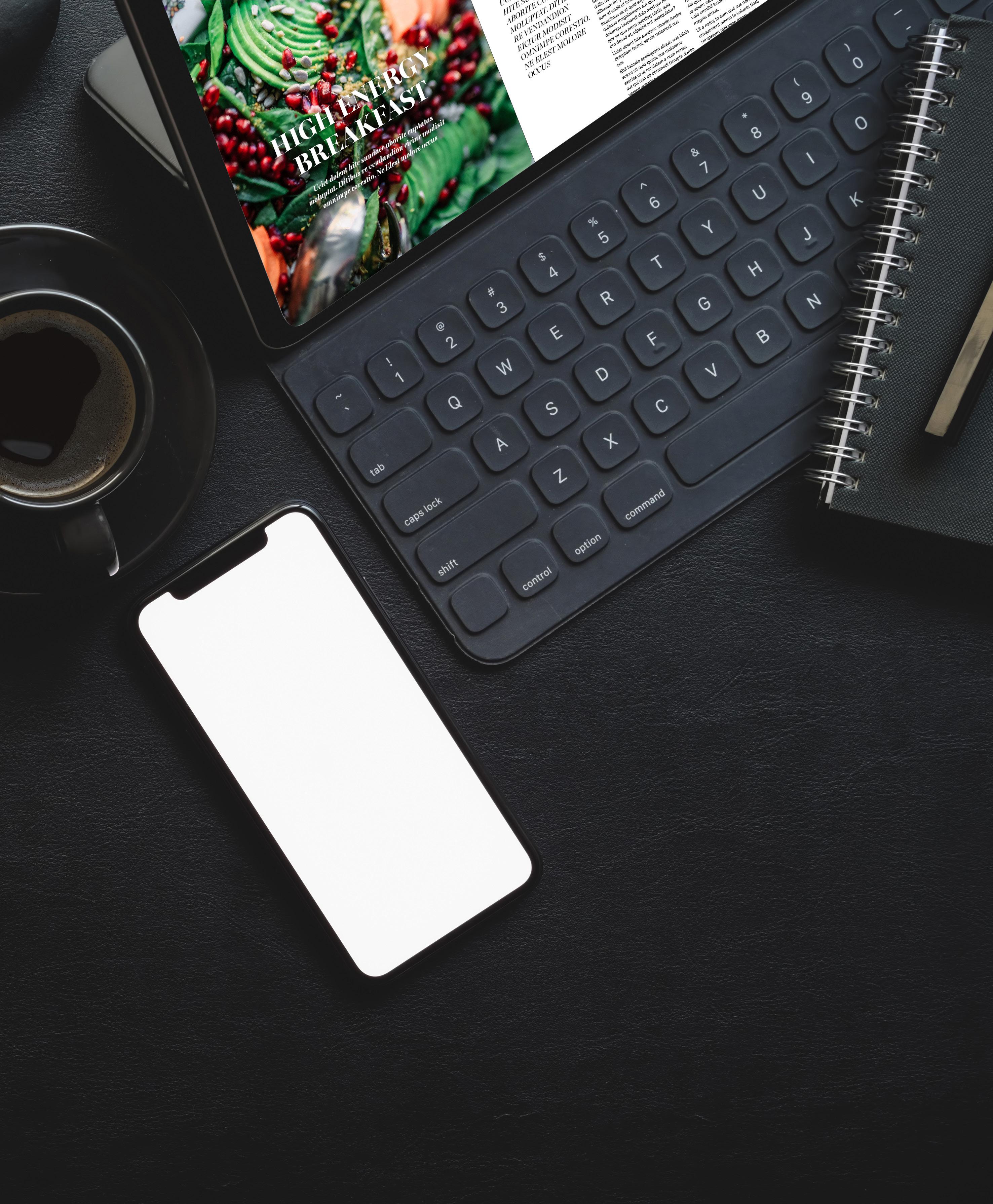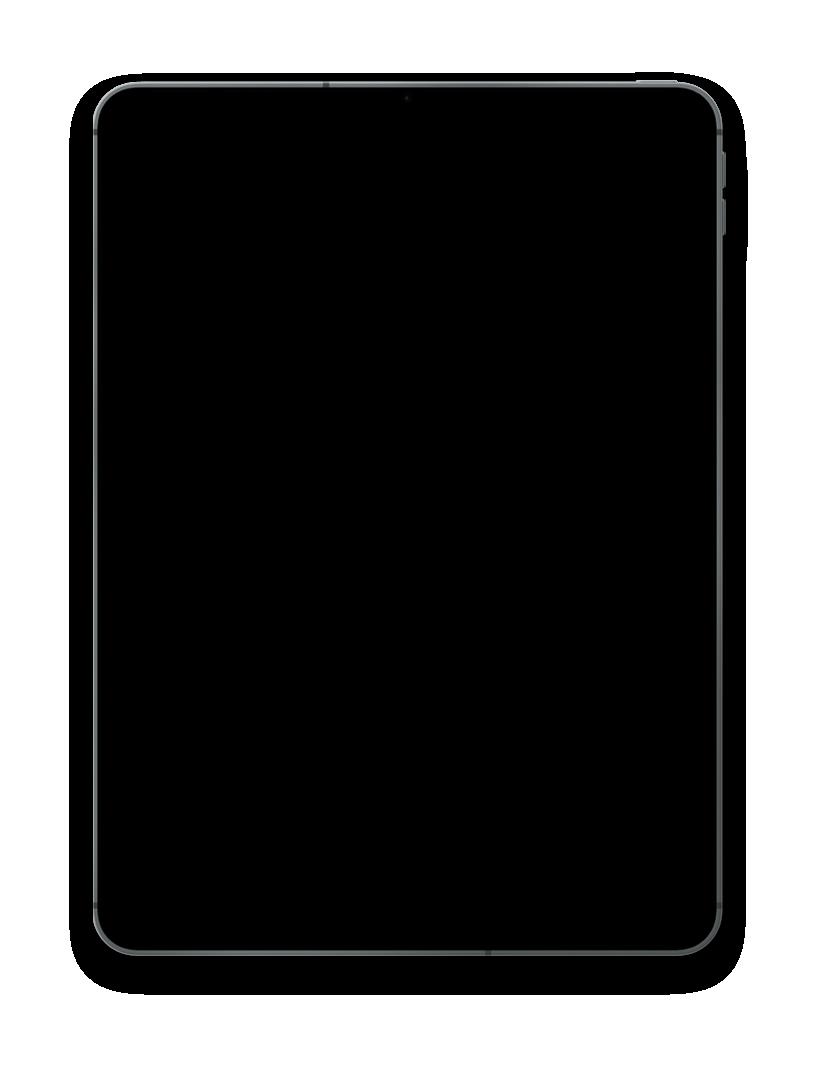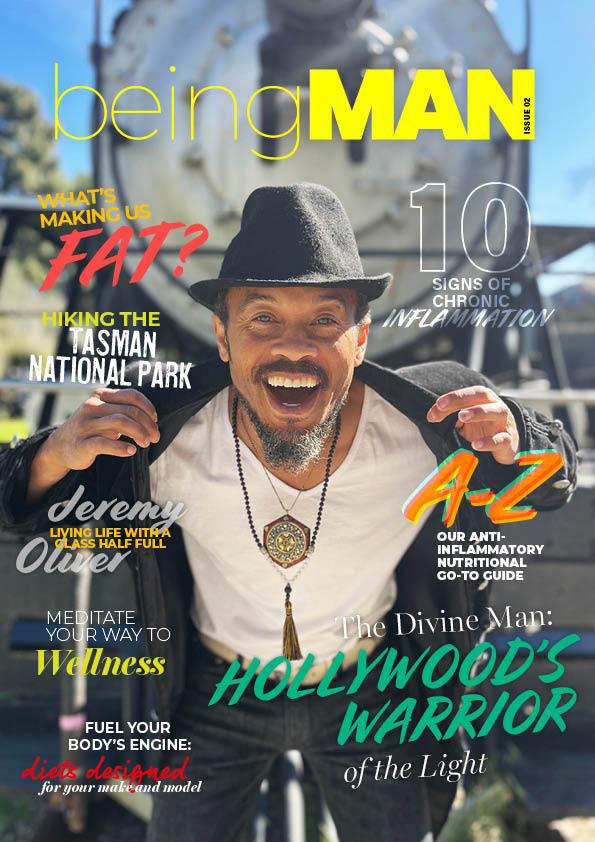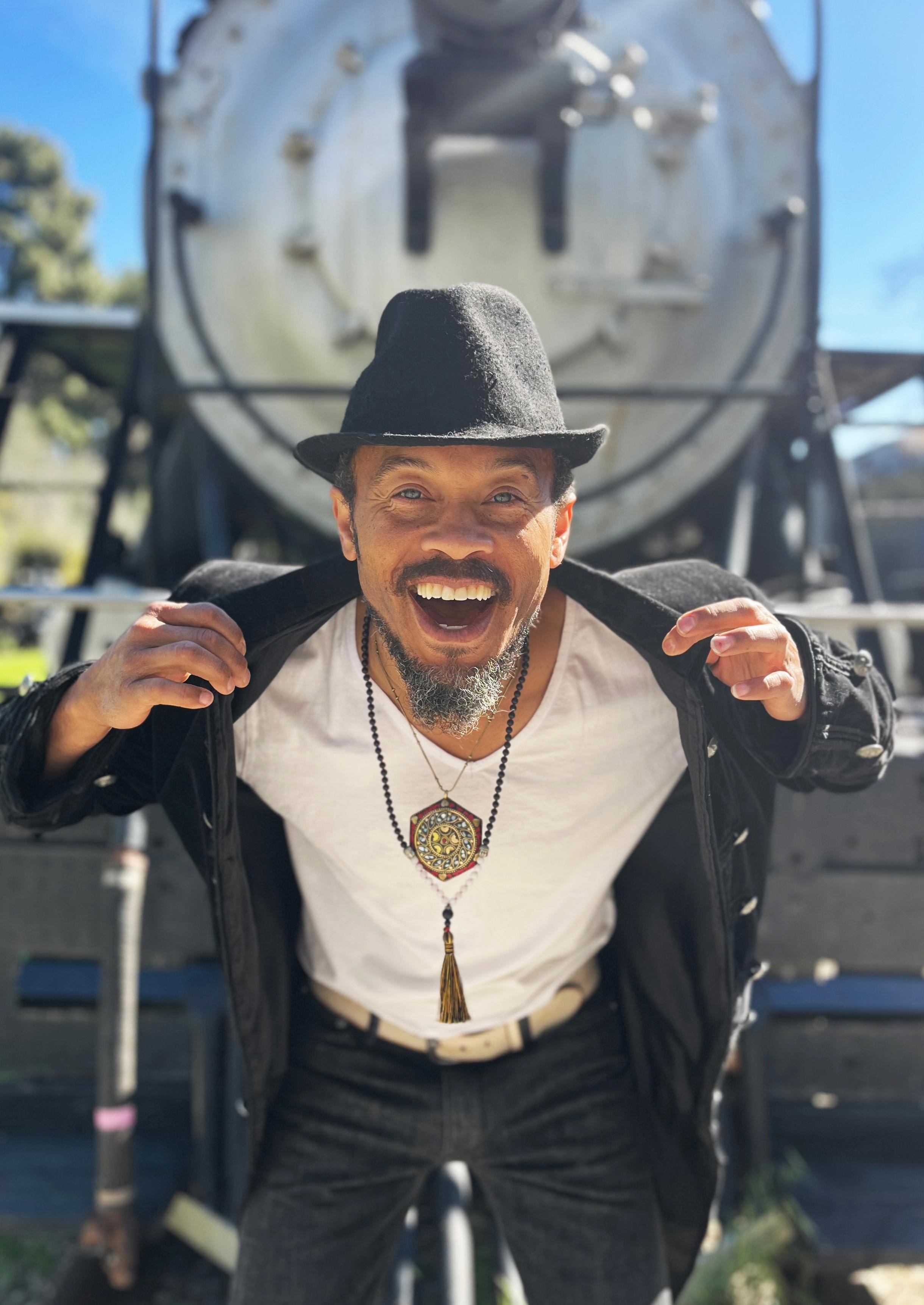

Live Your FULLEST LIFE
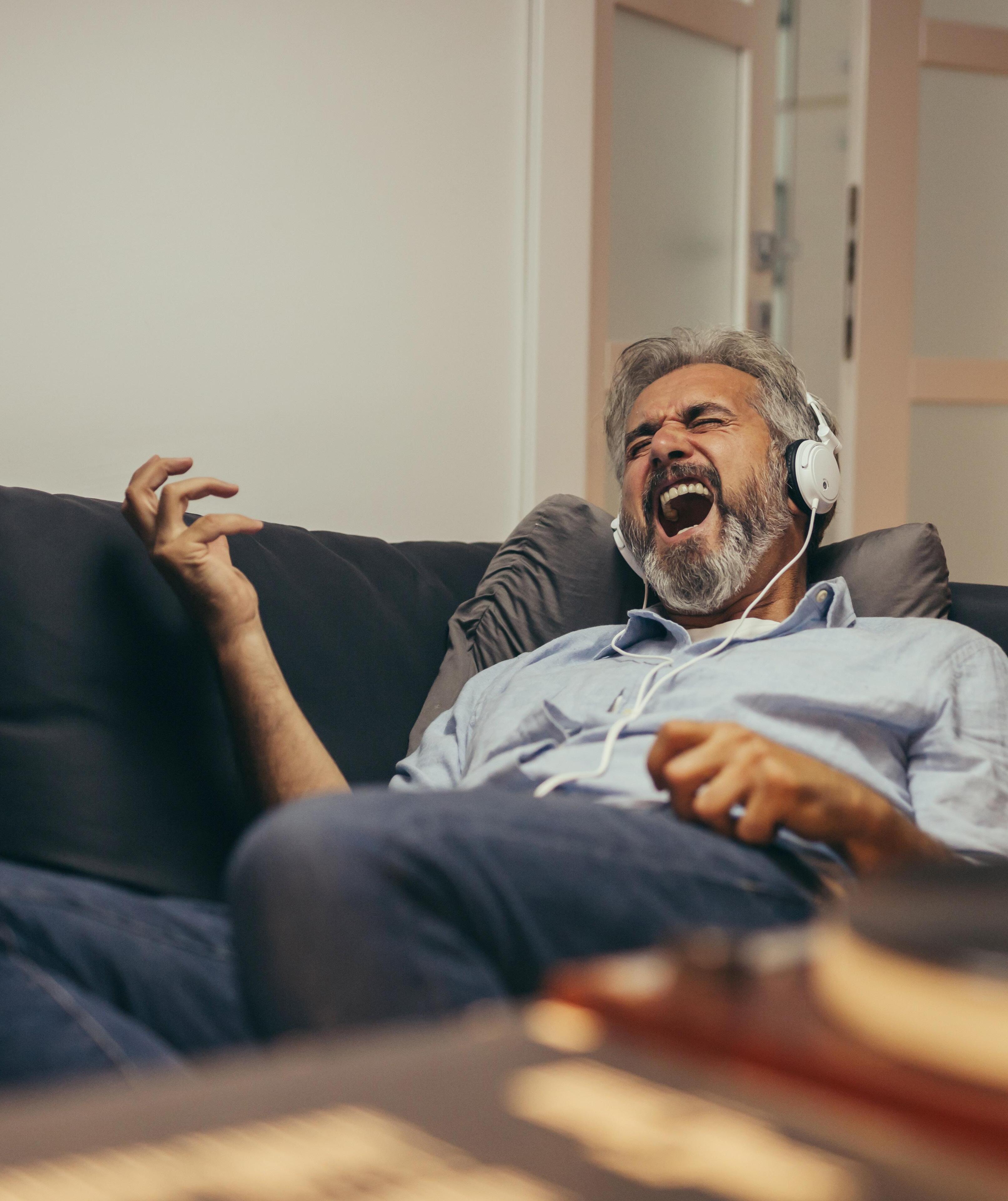
The content in this magazine is intended for general informational purposes only and is not a substitute for professional, legal, financial, or medical advice, nor does it assume responsibility for diagnosis or treatment. Always seek the advice of an independent qualified practitioner. Opinions, advice and representations expressed by our contributors and advertisers are solely their own and do not necessarily reflect the views of Saving Brothers (Publisher). We strive to provide accurate and up-to-date information, but we cannot guarantee accuracy. Any action taken by readers based on the information provided within these pages or on the pages of those we link to is done so voluntarily and should only be undertaken after independent research. The Publisher and its editorial team assume no responsibility for consequences or damages resulting from the publication or use of this information.

$500
AMAZON VOUCHERS
SHARE YOUR STORY FOR A CHANCE TO WIN
Do you have an inspiring story to share like Íse, Jeremy and Sara have done in this issue? If you would like to help and inspire another man by sharing your experience in a future issue of beingMAN, we would love to hear from you.
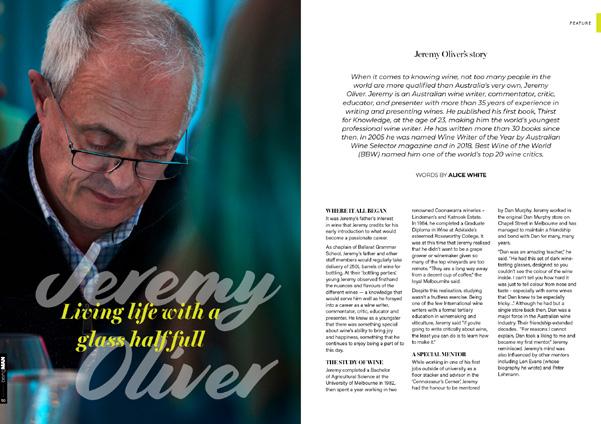
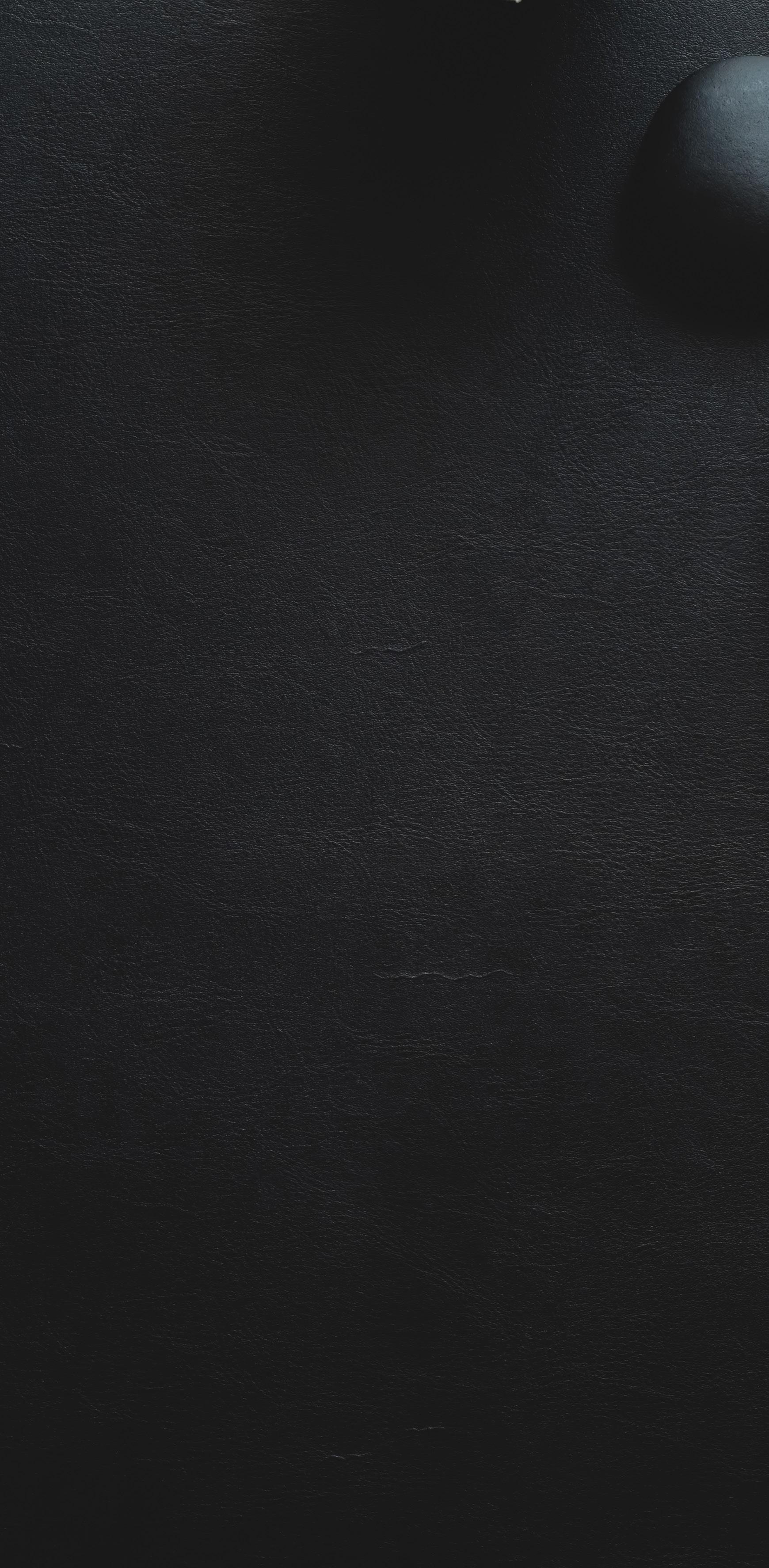
HOW YOU CAN WIN
1. Submit your inspiring story
2. Include:
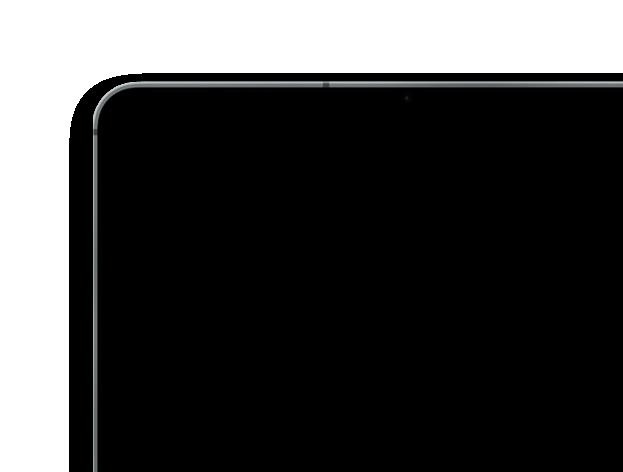
• The Beginning - how you felt stuck, challenged and/or in need of help.
• The Catalyst - what prompted you to want to do something about getting unstuck.
• The Journey - how you started, what the journey looked like, and who supported you. Provide details about the process or steps that you took on your journey. Reaching the Goal - where are you today because of taking this journey.
3. Share your contact details - name, email and mobile number to help us respond to you.
4. Should you be 1 of the 3 winners, our team will work with you to have your story published.
CLICK TO SUBMIT
*Amazon vouchers are in AUD currency valued at $500 AUD each. 3 are available and ends June 15th.
about
beingMAN
beingMAN magazine captures inspiring human stories, lifestyle and body science for men to find ways to build new abundance into their lives. We believe living a full life starts when men become the hero in their own story no matter the place they start from. Get inspired reading feature stories from those who have discovered how you can live your best life, soak up insights from our health experts, and feel immersed in our lifestyle sections. Our team at beingMAN believes curiosity is a great catalyst to reimagine how you see yourself tomorrow. This is also our commitment to empowering men to live their fullest life
info@beingman.online e
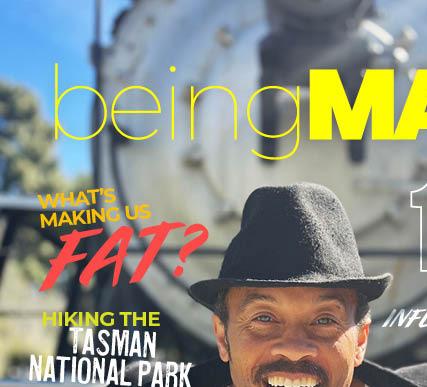
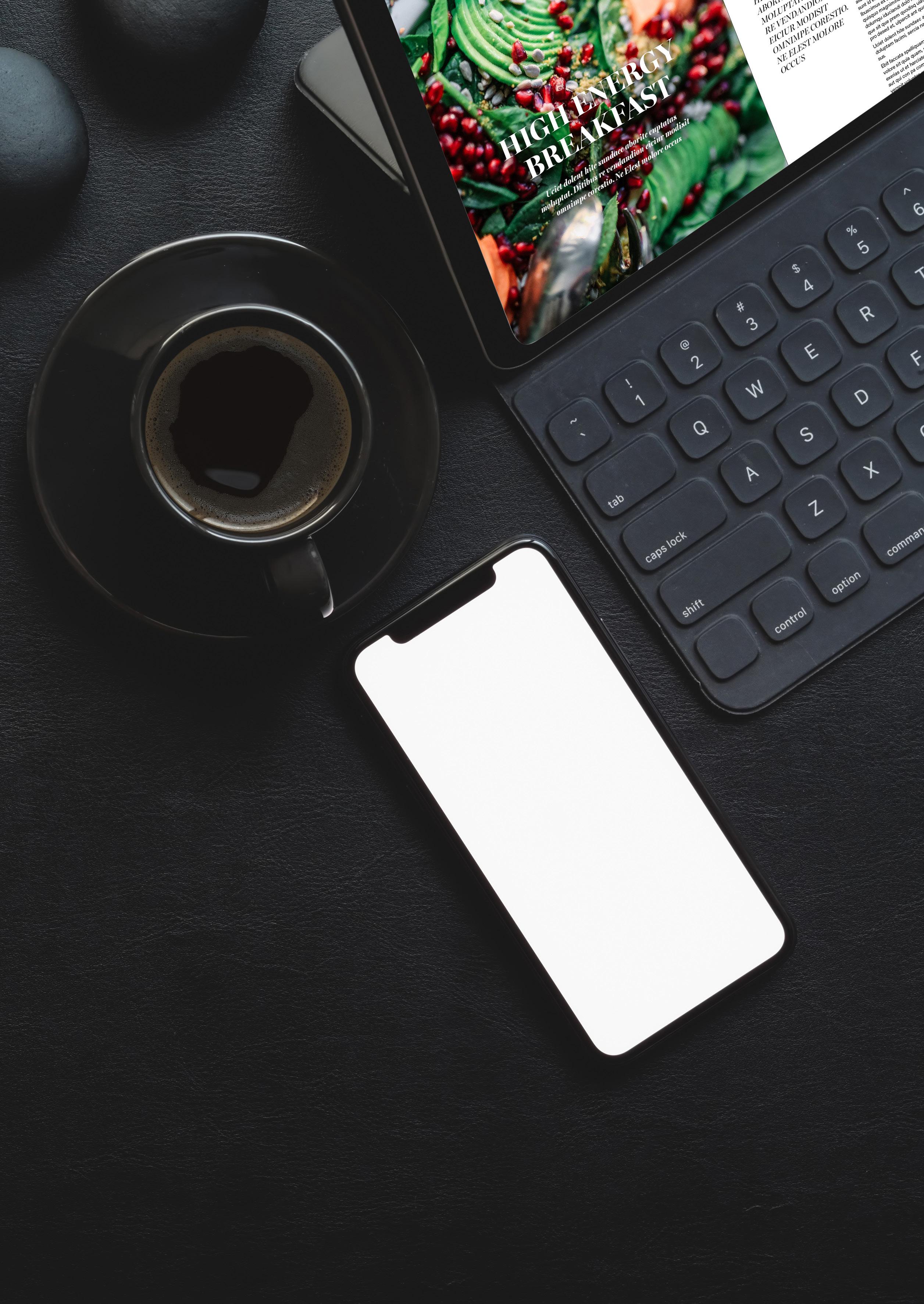
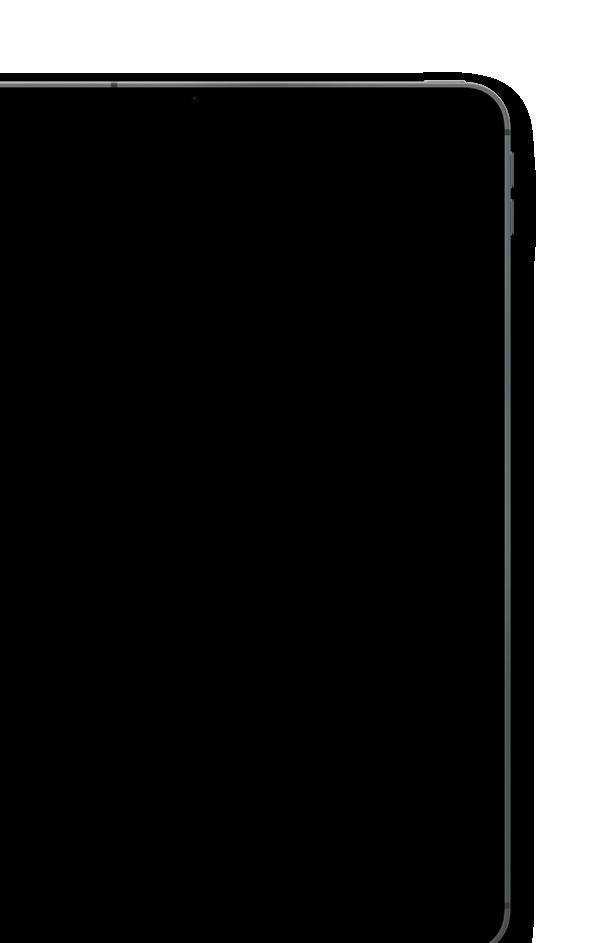
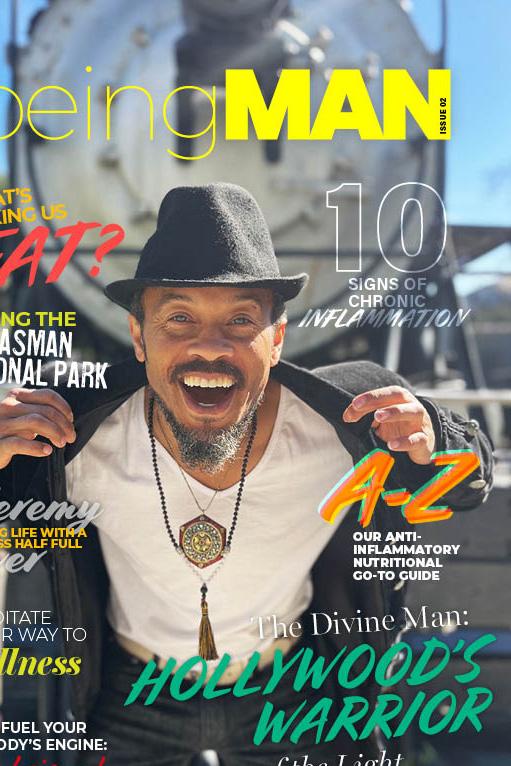
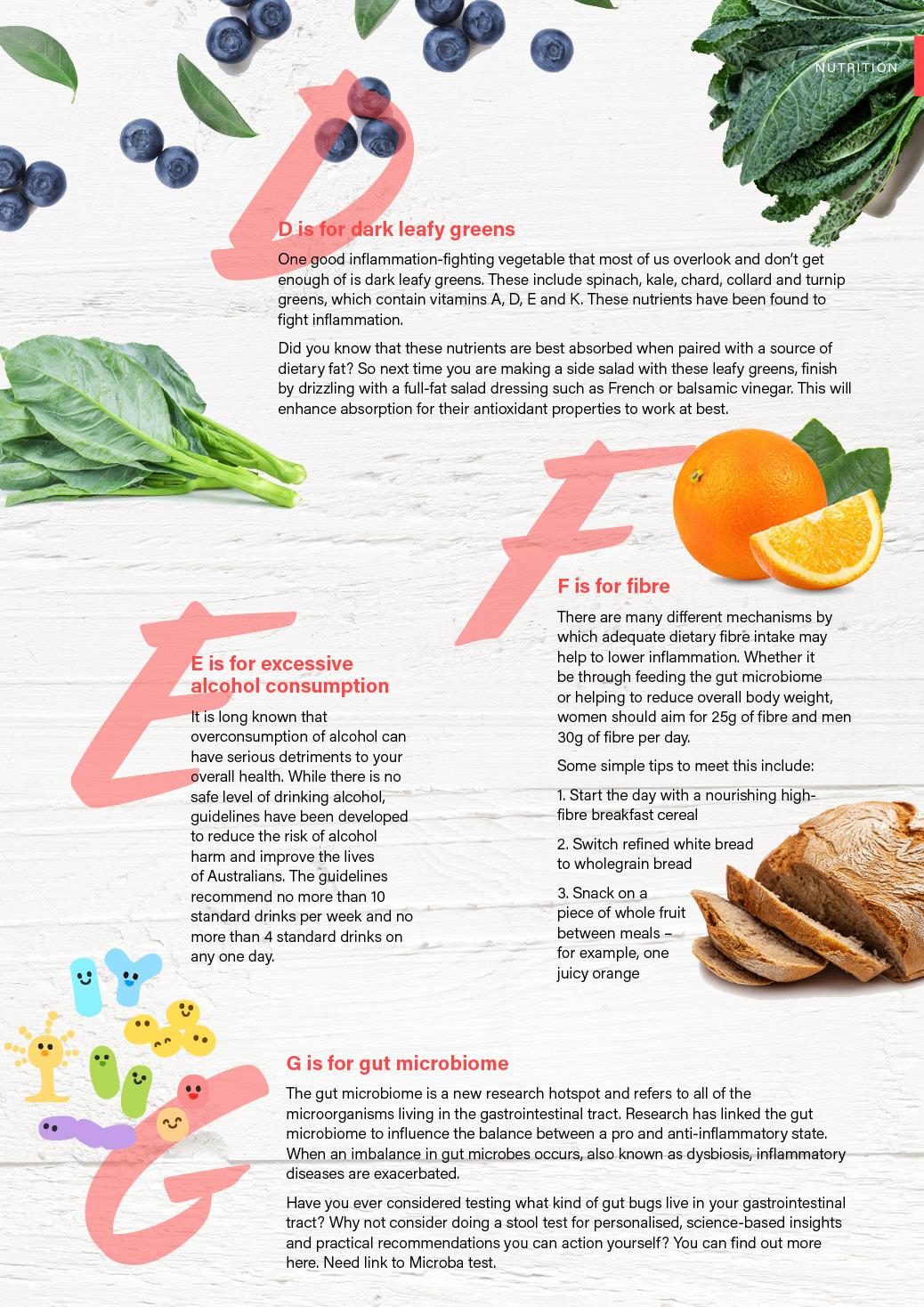
Welcome to the Vitality issue
Philip Robison FOUNDER, SAVING BROTHERS philip@savingbrothers.com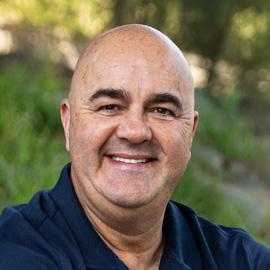
This month’s theme of vitality couldn’t have come at a better time for me on a personal level. My own health has suffered this past month with a chest infection (and Bali Belly to top that off); I’ve dropped everything to be with my dad who had a heart attack and is working through kidney failure; and some of my investments and business partnerships have paused which has made an unfavourable dent in my income. I tell you what: my daily walks, my meditation, my good sleep habits, and my focus on diet have all played a role in helping me through this rough patch.
Sure, I could dwell on all the bad in my life right now (and I’ve had my down moments, for sure), but they say pain is inevitable while suffering is a choice. I am not a sufferer. I am not a victim. And neither are you, my friend. I hope when you read this issue, you’ll be encouraged to keep up your healthy and active habits that give rise to vitality. A strong conviction and healthy habits are stronger than any setback.
In this issue, we look at different ways your diet and lifestyle might be zapping vitality from you without you even being aware of it, and our team of experts provide practical strategies to win it back. Olivia Wills’ A-Z Anti-Inflammatory Guide is a nice, easy to read guide to rid your body of debilitating inflammation, while What’s Making Us Fat is a must-read if you find you’re doing everything to keep the weight from creeping on, but not having any luck in doing so. And, if you’re feeling flat or like your body is in need of an overhaul, then check out the
11 Signs of Chronic Inflammation

This magazine will always be devoted to bringing quality health literacy to the everyday man - after all, education and awareness are the stepping stones to action and results. But that’s not to say we can’t have a little fun along the way! Life is for living, and that means travel, home projects, and maybe even a glass of wine along the way. Speaking of wine, I’m excited to make this lovely drop a resident page in beingMAN, with the award-winning Jeremy Oliver contributing his expertise each month. This month we start by interviewing him to get to him a little more. Jeremy is open to responding to your wine questions, so please email me with any article suggestions you have.
So, if times are tough right now my friend, I’m with you. But we don’t have to stay here. We get to live wherever we let our mind take us, so take that walk, breathe in the fresh air, and know that there are better days ahead.
Philip RobisonPERFORMANCE HEALTH COACH & RN
catharine@savingbrothers.com
Vitality is one of life’s greatest treasures. This month, as we celebrate all things vitality, we explore how it makes our bodies feel when fueled by this magnificent force, as well as how to cultivate more of it. We’ll also take a look at some common pitfalls that might be draining and sucking your vitality stores dry.
Vitality is defined by energy and strength – that feeling of aliveness that is capable of igniting a lifeforce inside of you and bolsters the connection to the world. It is magnetic, contagious and is why you feel more energised when around those who have it in spades. But not all energy is positive.
Every minute of every day we are constantly surrounded by forms of energy that are both positive and negative. Everything we see, touch, smell and feel is made up of this energy, which includes our thoughts, emotions, actions, and interactions with one another.
Are you perhaps lacking in vitality? If so, it’s time to immerse yourself in our feature articles and body section where we explore the human experience and its potential, as well as take a look at how the physiology of your body might be getting in the way and holding you back.
Our cover story with Íse Ma’at El O is a true testament to human potential. He triumphantly dove deep into himself to reconnect with his soul at a time when he felt lost and disillusioned. Today, Íse is now living life to the fullest as a free spirit filled with immense satisfaction and happiness. He tells us how he was able to reclaim vitality by discovering his truth, mending fractured identity, and leaning into the synergistical power that exists between masculine and feminine energies. Ise is a true warrior of light and you’ll find so much to learn from his journey.
For a great reminder of the accountability and power we have over our own health, Sara Webb’s feature
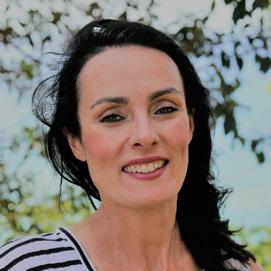
article is a must read. In this, she demonstrates how the power of becoming vulnerable through meditation and the formation of new habits can help you see new light and reach new potential each and every day. Relearning how to make everyday count has been a process for Sara, but is now her go-to mantra. From victim to victor, Sara is a gem shining brightly for herself and all those around her. Her energy is magnetic.
Geraldine Georgeou’s feature article speaks to her work in prescribing nourishing, tailored nutrition solutions for getting men back in the driver’s seats of their own body and vitality. I have the great pleasure of working with Geralidine in the world of clinical healthcare, helping everyday people fight disease, while also building vitality through little tweaks to body physiology. She is also my personal dietitian! Geraldine is one of Australia’s most soughtafter dietitians specialising in metabolic and gut microbiome health – and our go-to body hacker!
Lifestyle and vitality go hand-in-hand and the pages of our lifestyle section are filled with more secret ingredients for you to use on the quest for more vitality!
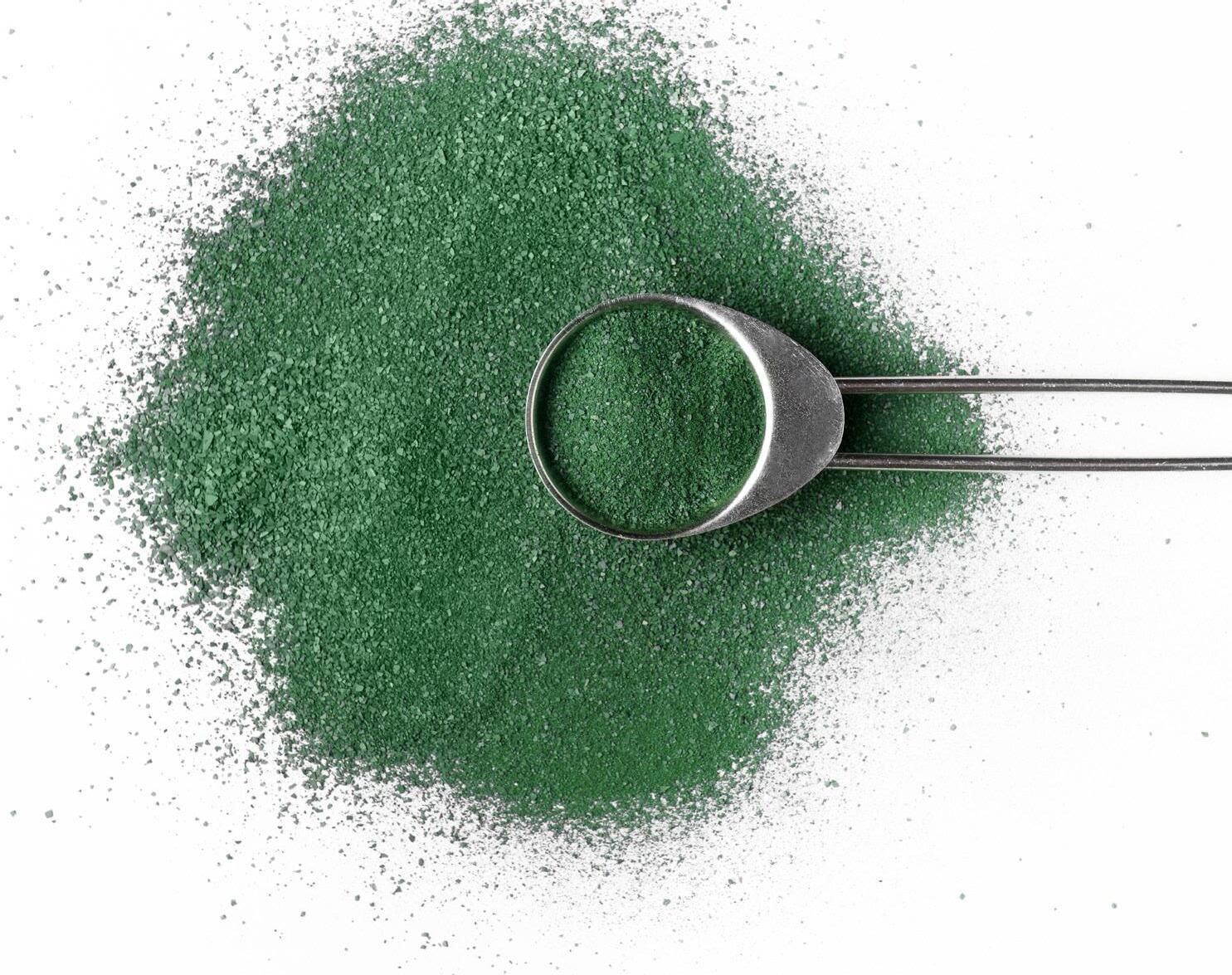
If you’re on a journey to improve your health, I encourage you to keep going and keep your eyes forward. You can’t undo the past – but you can prepare for the future. Vitality is a lifeforce we must protect. Building upon it will help you create new energy vibrations and see you go from strength to strength.
Find a comfy spot, enjoy, and please do reach out.
Catharine xxVITALITY is a LIFEFORCE
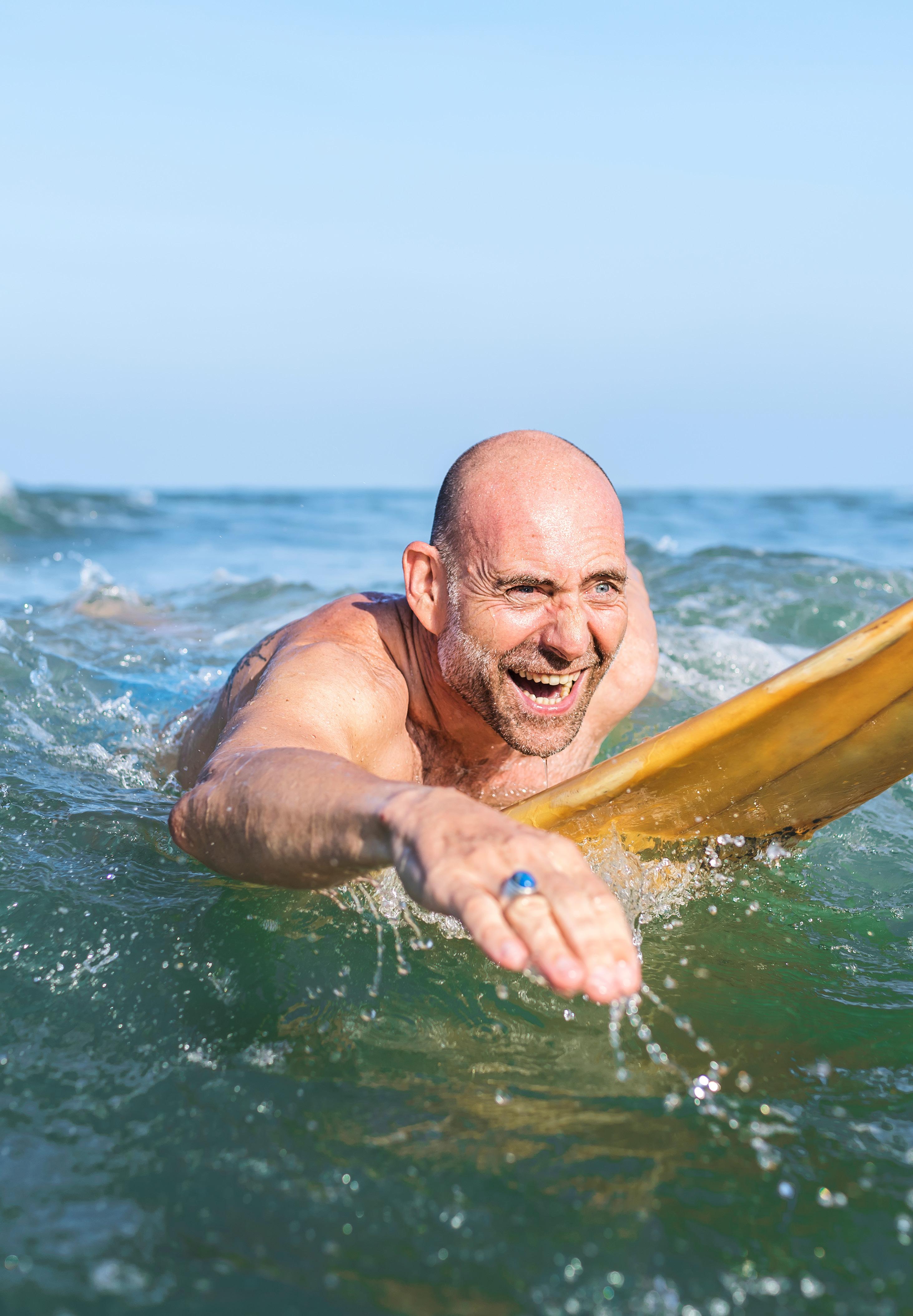
"Your health is what you make of it. Everything you do and think either adds to the vitality, energy and spirit you possess or takes away from it."
- Ann Wigmore
MOVING FROM ANXIETY AND STRESS TO FINANCIAL Confidence
Sloan Wilkins
Sloan Wilkins is a Financial Coach with more than 30 years’ experience in Banking, Financial Planning and Wealth Management. He holds an Executive MBA (AGSM) and Financial Planning qualifications but learnt the most from making his own financial mistakes as a young adult and clawing his way out the other side. Sloan is passionate about ending financial stress for his clients.
When it comes to men’s health and wellness, one area that often gets overlooked is financial wellbeing. However, our income is the most important wealth creation tool we have and taking control of your money can have a huge impact on how you feel overall.
Anxiety and stress are common emotions when it comes to money, and it’s easy to feel overwhelmed by our finances. But like physical and mental health, it’s important to remember that wherever we are today, we can take action to improve our future financial health.
TAKING THE FIRST STEP
The first step is to gain clarity on your current financial situation. This means understanding your income, expenses, and debt. Once you’ve got a clear picture of your money, you can begin to make plans for moving forward.
Remember, money is more than just numbers in our bank account. It also has an energy associated with it. The way we think, feel and
act towards money can have a direct impact on our energy levels, and subsequently on our overall wellbeing.
Taking care of our money sends a message to our brains that this is important. It also demonstrates that we value ourselves and our financial wellbeing, which in turn can boost our self-esteem and confidence.
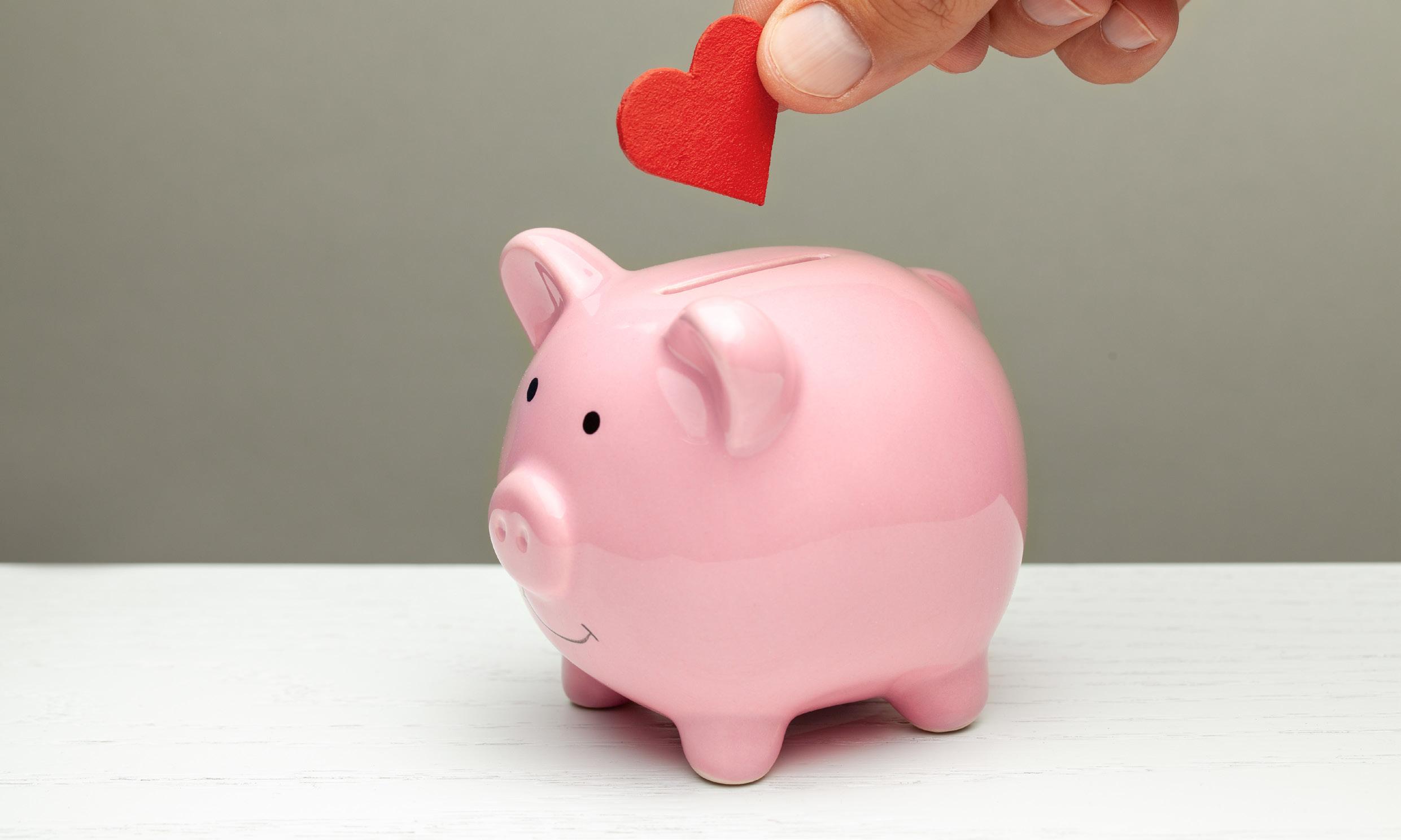
On the other hand, if we neglect our money or have negative thoughts and feelings towards it, it can make us feel helpless, and stressed. This can drag down our energy levels.
THE POSITIVE IMPACT OF A POSITIVE MINDSET
It makes sense that when we shift the energy around our money, it has a positive flow-on effect across other areas of our life, such as our fitness, job, and relationships. When we take control of our finances, we begin to feel more in control of our lives, leading to a sense of empowerment and motivation. One of the most powerful things about taking control of your finances is the immediate boost in confidence available. Even though changing your financial position takes time, you can start to feel the difference from day one.
Knowing you’re on the path to a better financial future is a powerful motivator to keep moving forward.
However, if you have emotions like blame and shame tied up with your money, it can make progress difficult. The good news is you’re not alone. There are many resources available to help you improve your financial wellbeing, including financial coaching.
MONEY COACHING
When you’re ready to be the boss of your money, working with a coach can be incredibly beneficial. A financial coach can provide guidance, support, and accountability to help you stay on track. They can also help you to identify and overcome any mindset blocks that may be holding you back.
When it comes to health and wellness for blokes, we can benefit from boosting our financial wellbeing. Taking control of our finances boosts confidence, shifts our energy in the right direction, and improves our overall wellbeing.
Wherever you are today, you can take action to build a better financial future. You’ve got this!
HOLLYWOOD’S
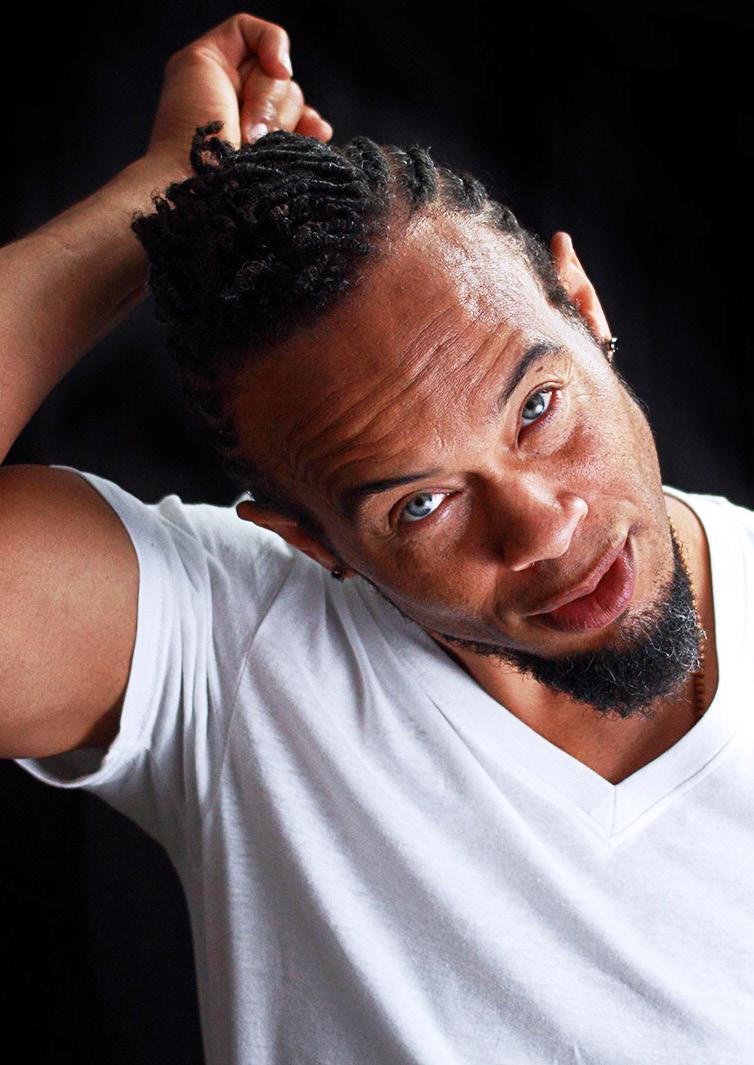
The Divine Man: HOLLYWOOD’S WARRIOR of the Light
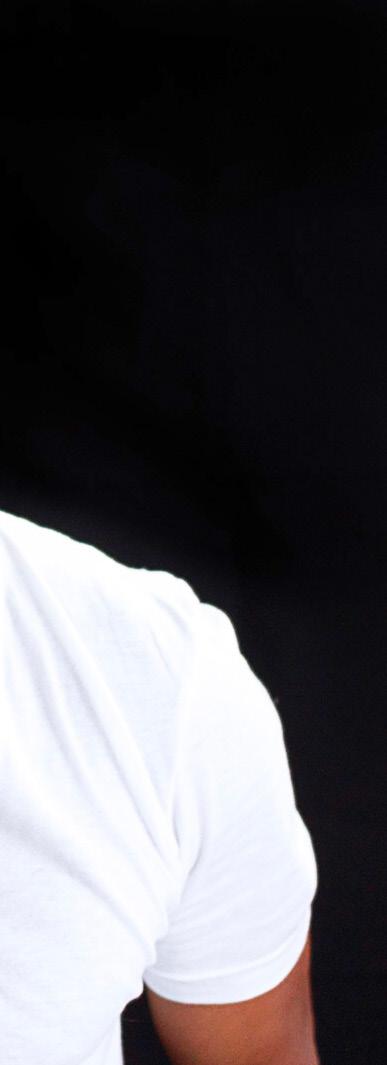
Rising from the ashes of his incomplete self, Emmy Award winning actor Iseluleko Ma’at El O (Kiko Ellsworth) is on a divine journey to teach boys and men how to perform at their best across all aspects of life. By being fully present in their lives and harnessing the powerful balance of feminine and masculine energies, Íse’s youth and men’s development programs provide them with everything they need to succeed: themselves.
WORDS BY JESSICA MASUDATwenty years ago, Íse Ma’at El O was living the fast life in Hollywood as Emmy Award-winning actor, Kiko Ellsworth. Following his breakout role in the soap opera, Port Charles, Íse has been credited with over sixty film and television roles, including work as a writer, producer and director.
But life in the limelight was not always so glamorous. Íse was lost. Unconscious. Drowning in low selfesteem, materialism, and boatloads of unhealed trauma. It was a life that was not sustainable. Without time to focus on himself or gain an ‘inner-standing’ of who he was as a person, as a man, a crash was all but inevitable.
And, several years later, that was exactly what happened.
THE DIVINE AWAKENING
Íse’s fall was a slow descent –certainly not one he was aware of at the beginning. However, the trauma and toxicity of living with his incomplete self progressed to the point where he started turning down TV shows to invest in himself and in his relationship with his then-fiancée, Christine. And while the decision to cut ties with his theatrical agent and manager was initially a happy and freeing experience, things slowly began to crumble.
“There was this numbness in my heart and I was insecure, I just wasn’t put together on the inside and I knew it. I was so fractured. That’s the only way I can describe it… You’re trying to put the pieces together so you can see a clear vision of yourself but the pieces keep moving and you keep trying to put it together but you never see a clear picture of yourself. That was me. And from my experience, that’s where I’ve noticed most men are at,” he says
While the decision to step away from Hollywood had set Íse on the path of his spiritual journey, he was
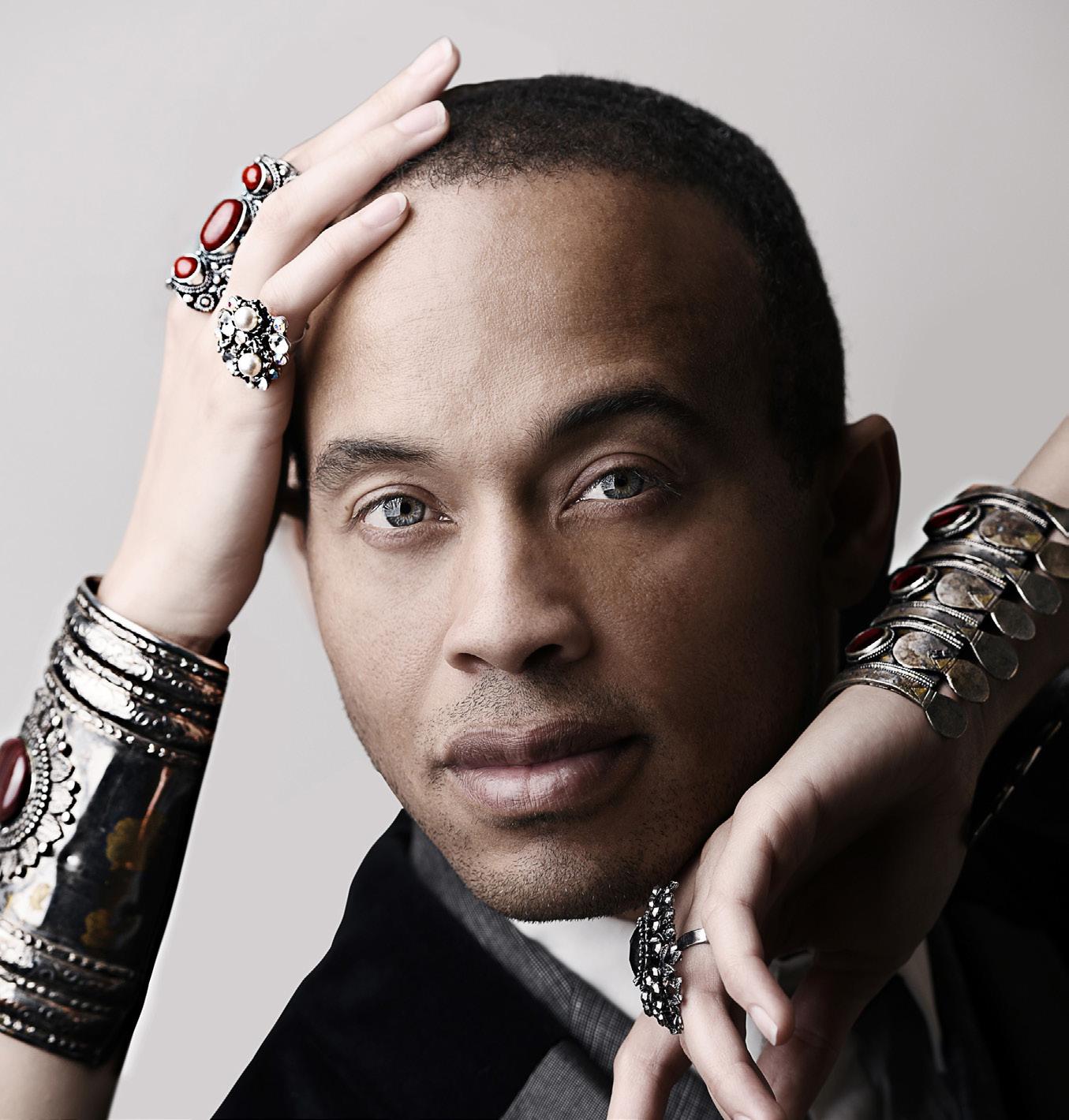
still working on the foundations of his new divine self. One of his first true mentors and inspiration for this quest for self-mastery was his long-time partner Christine, who has been a part of his life for over twenty years. Despite completing their marriage, he and Christine have remained exceptionally close, and it was their impromptu ‘completion ceremony’, where they exchanged closing vows and blessings, that triggered the spiritual awakening Íse had been searching for.
Following this rebirth with a complete sense of self, Íse has been able to clean up the messes he’d
left behind during his unconscious years and even make the return to acting. Having hit rock bottom and rebuilt himself, Íse describes feeling incorruptible by the forces that gradually distorted his sense of self in the past and that he’s now not only a better actor, but a peaceful, more grounded, and more complete person. Now that Íse has found himself, he’s determined to share that message with men around the world.
To be complete, a man must access the full spectrum of spiritual energy within him - the masculine and the feminine.
“When you hit rock bottom, something special happens. You just say, ‘Okay, I can’t get any lower.’ And that was when I started really building myself up from the inside out.”

Íse’s spiritual journey has now spanned decades and he has observed that man’s fractured sense of self often stems from an inability to show up and be fully present. However, a man cannot be fully present unless he clears emotional blockages and connects spiritually, emotionally, and physically to the world around him.
According to Íse, to achieve harmony within the home and beyond, a man must access the
full spectrum of spiritual energy within him - the masculine and the feminine - which has proven challenging for many men who have been conditioned for centuries that having anything ‘feminine’ about them is in some way unmanly.
Íse describes this spectrum as opposite ends of the same energy that we shift between in order to operate in life harmoniously and wholly. “Think about the sun being masculine and the moon being feminine,” he says. “The gas pedal being masculine and the brake pedal being feminine - you need both. You can’t learn to box without punching (masculine) and blocking (feminine).”
“If a man cannot properly switch between the masculine and feminine ends of the spectrum, there will always be friction within him as a divine being and therefore within the home, in the workplace, with his female partner, and in life.”
A man cannot be whole, cannot be complete, if he only utilises one end of his energetic spectrum. He is never fully in touch with himself or with those around him. But once he has the ability to harness the spectrum of his natural energy, he has a more complete, more loving, and more powerful version of himself. And once he has himself, he has everything.
INSPIRING CHANGE FROM THE TOP
The transition from Hollywood actor to modern-day shaman may seem like an unusual career path, but for Íse this was a natural progression. Having worked with non-profits teaching empowerment and self-defence to women, Íse was prompted to think about what lessons he could impart to men, especially after his enlightenment following his marriage completion. Taking the lessons he has learned over the last thirty years healing the damaged and disconnected relationships in his own life, Íse has curated the Divine Man SelfMastery Coaching Program and the Youth Development Program to support and facilitate the divine rebirth and spiritual awakening of
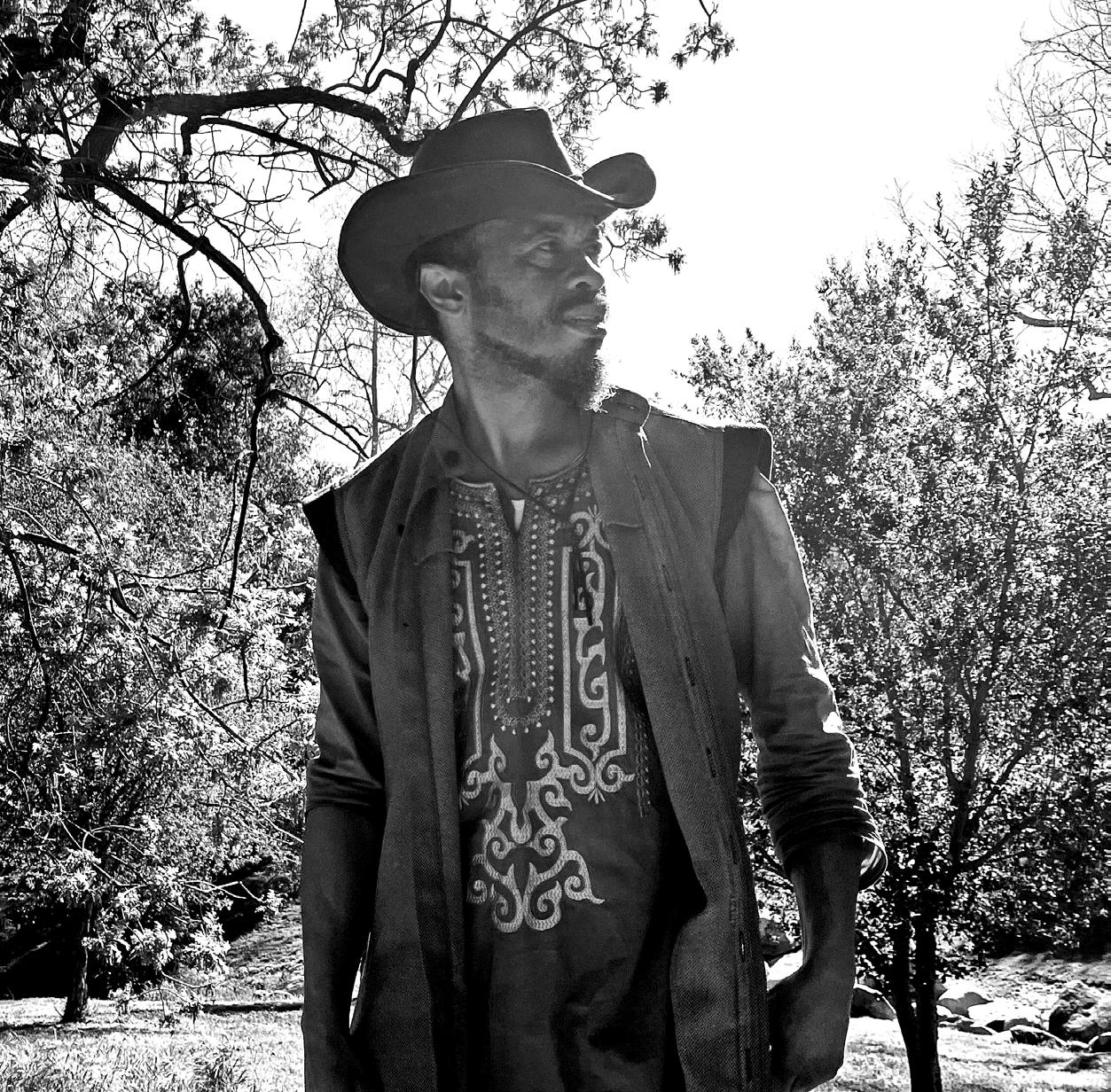
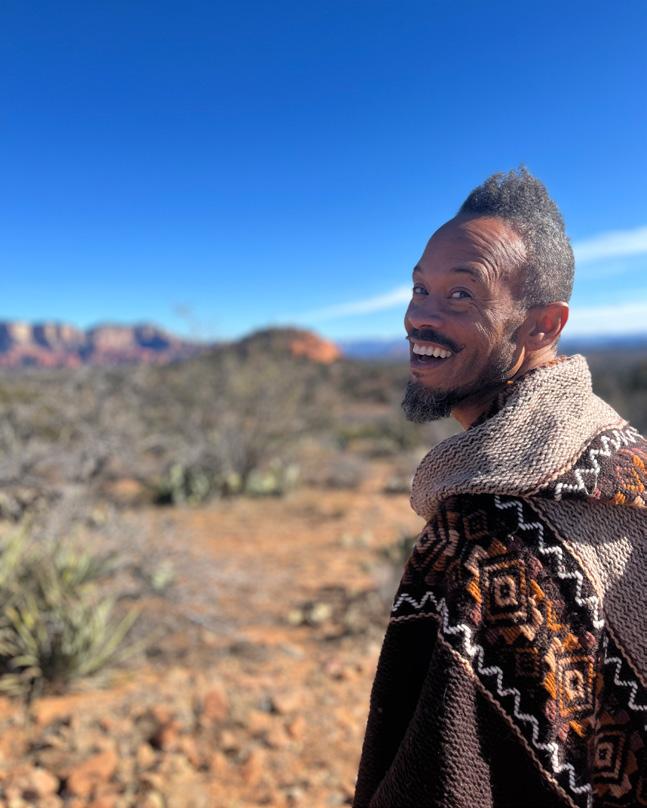
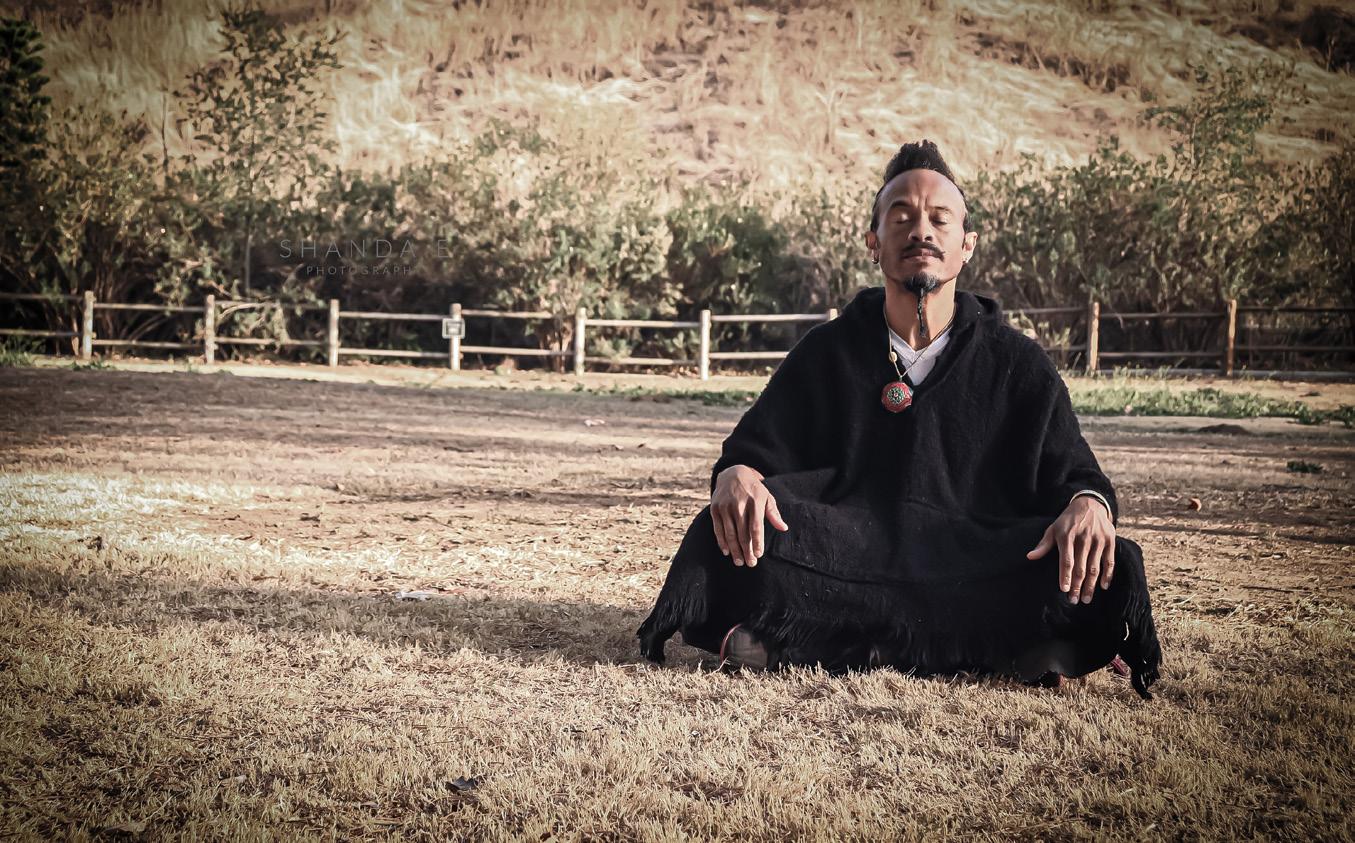
“Christine was my spiritual mentor, my mother, my wife. She was everything - the womb I needed. Every man needs a womb - a safe place to rebirth himself in.”
A DIVINE MAN:
has mastery over his worklife balance turns mistakes and past pain into wisdom replaces DEstructive habits with CONstructive ones feels centred, clear and orientated demonstrates real peace, purpose and spiritual power in his life can access emotional areas of himself to be present as an empathetic, strong and whole partner communicates with truth and authenticity
will elevate their identity with self as well as females ; help them establish simple yet powerful daily habits ; breath-work; and other clarifying practices where the effects – and benefits – are felt immediately.
These small but tangible changes offer a glimpse into the larger spiritual world, where men can then reach out for more support in their own time. Íse then provides the safe space for youth to unload their emotions, learn how to communicate, heal traumas and recalibrate their lives.
JUNGLE HEALING: THE MEDICINAL POWER OF NATURE
The next leg of Íse’s spiritual journey takes him deep into the Amazon jungle where he will be travelling with other divine men and women to explore the healing power of the plant medicine, Ayahuasca.
a man has done his deepest healing through plant medicine,” Íse says.
Íse will spend ten days exploring the Amazon rainforest alongside other men and women from around the world as he and his partner/ wife Amber Jazairi produce the upcoming movie, Jungle Man. This documentary will follow these divine men on their quest for deep, spiritual healing to better themselves and the world at large. You can visit JunglemanMovie.com for more details .
“We as men have done a lot of conscious and unconscious damage to women individually and collectively and it’s time we start cleaning up all of our messes. This documentary is a powerful and much needed conversation never before had between men and women at this scale,” Íse says when asked of the motivation behind making this film. “This film is one of our pieces of work that will amplify that healing process and reengagement between men and women.”
While every man is capable of ascending to a higher version of himself, Íse’s ideal clients are men who hold influence over other men in order to achieve the biggest positive impact for our planet in the shortest period of time, and mothers who need positive male support in raising their young boys into healthy and complete men.
To help new clients embrace the path to spirituality with an open mind, Íse starts by introducing males to divine man concepts that
While not essential in unlocking one’s divinity, Íse credits the sacred plant medicine of Ayahuasca with supporting him in healing many of his deepest traumas and aiding in his own ascension process.
“I would not be the man I am today had I not used the power of plant medicine to heal my trauma. It is a feminine, mother medicine that excavates quantum amounts of trauma with a magnifying glass. I can always see the difference when
This documentary will show other men and women what is possible, what type of man is awakening in men, and also create a conversation about personal development for men, particularly in regards to healing childhood trauma and reclaiming their divinity with the support of the feminine plant medicine, Ayahuasca.
If you need support in raising your young man into a Divine Man or you’re thinking about reinventing your own personal identity by awakening your inner Divine Man, you can contact Íse at https:// thedivinemancoaching.com/ for a free consultation and discover if one of the Divine Man Self-Mastery Coaching Programs is right for you or your youth.
“Every male is supposed to evolve into his own spiritual man. That’s his maturity. When he learns to move from his head into his heart, then he awakens his eternally powerful divine man within.”
10
INFLAMMATION SIGNS OF CHRONIC
WORDS BY CATHARINE NIXONFrustrated by body aches and pains, fed up with uncomfortable symptoms, or feeling confused by a recent health diagnosis? Inflammation is part of our body’s natural defence mechanism and is essential for survival. There is, however, a dark side that exists and is linked to many of today’s chronic and degenerative health conditions that are on the rise.
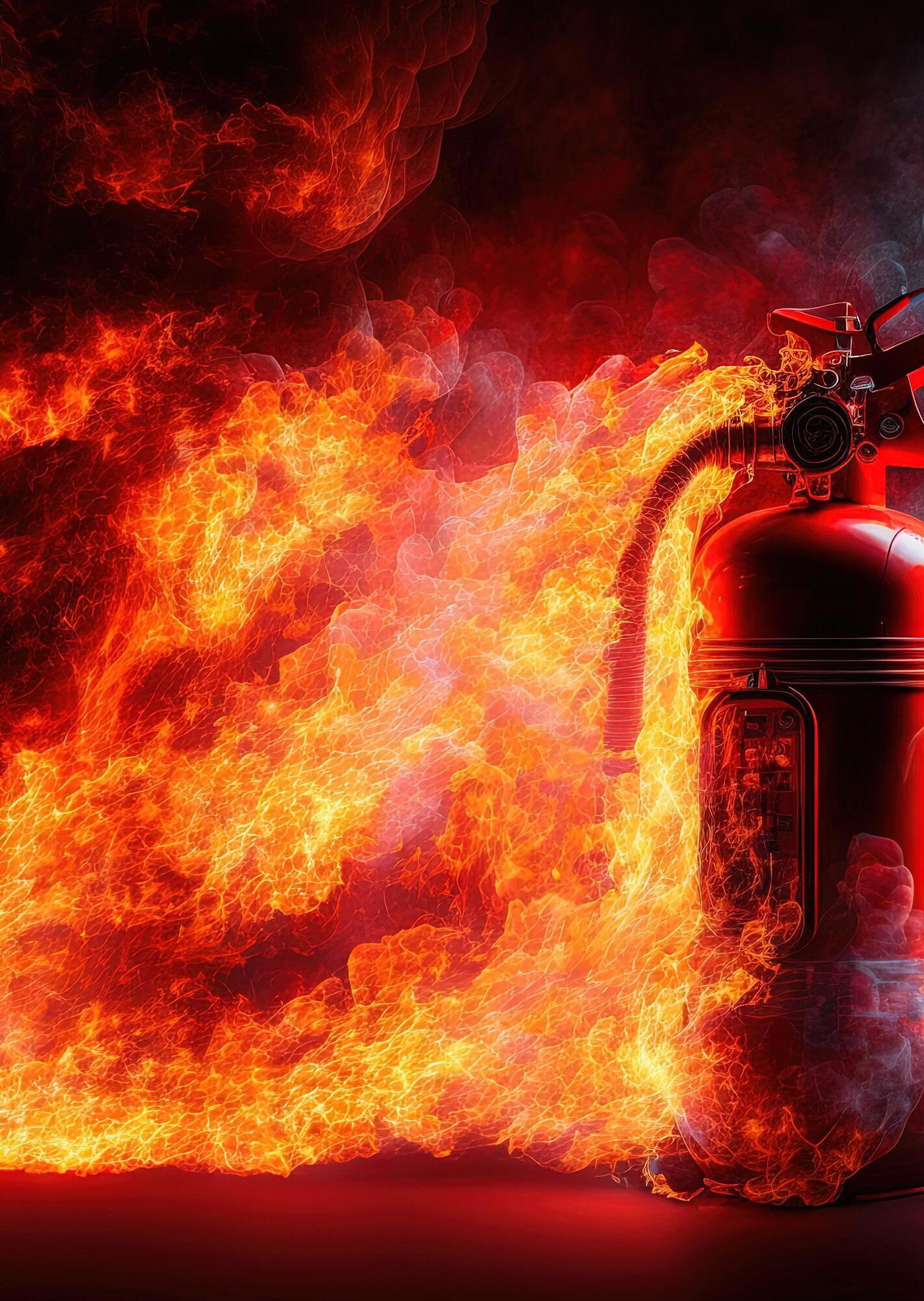
INFLAMMATION
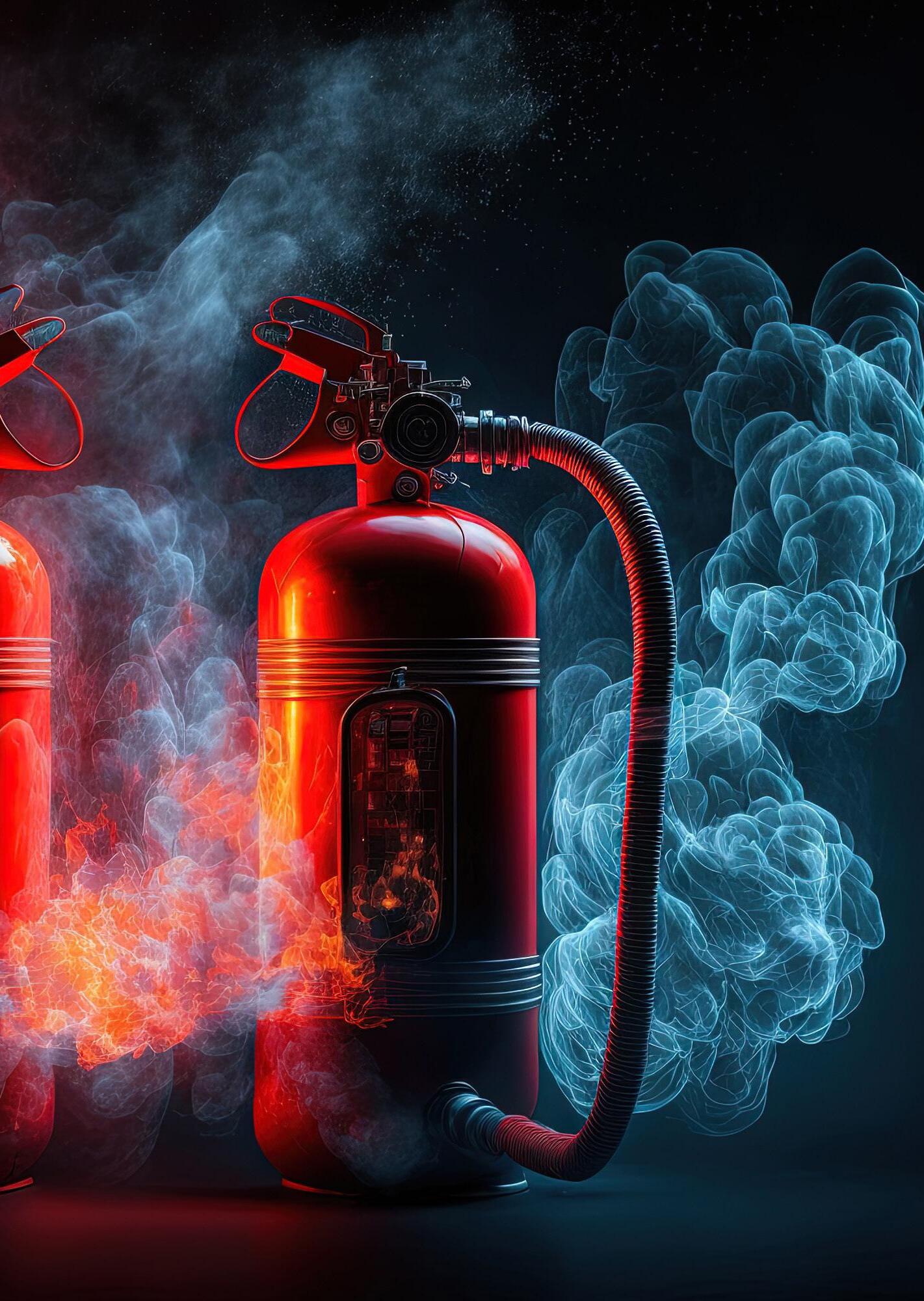
WHAT IS INFLAMMATION?
There are two types of inflammation: acute and chronic.
Let’s say you trip, fall over, and graze your skin. Our immune system immediately signals an acute inflammatory response to protect and repair the area.
Swelling and redness appear, but no sooner disappear, and the skin is healed. This is pretty standard and is the type of inflammatory response that we want and expect to happen in this scenario.
In fact, if we lacked the acute inflammatory response to combat bugs and viruses, it would be detrimental and catastrophic to our health. For instance, when we come into contact with a harmful virus, we need our bodies to respond appropriately to fight it off.
Chronic Inflammation, on the other hand, is the unfavourable side of the aforementioned coin.
As the term suggests, chronic inflammation is persistent and longlasting. The main differentiator between chronic inflammation and acute inflammation is that the chronic kind can set off a chain of events and can be a causative factor in many health conditions.
1. Abdominal ‘Belly’ Fat
As it turns out, those ‘love handles’ have another not-so-loving purpose after all.

They’re potentially a holding/production ground for chronic inflammation. ‘Belly fat’ is a sign that some of your internal vital organs are surrounded by visceral fat.
Why is abdominal fat dangerous for the body?
Abdominal visceral fat lies deeper than superficial fat and produces inflammatory cytokines increasing the risk of developing insulin resistance, cardiovascular disease, and metabolic abnormalities, including type II diabetes and liver problems.
Abdominal visceral fat is a strong predictor of inflammation and also mortality in men. Fat cells found in the abdominal fat also secrete molecules worsening inflammation, stimulating the production of pro-inflammatory cytokines and increasing the risk of insulin resistance.
High levels of abdominal fat are also a predictor of type II diabetes, a chronic disease. In these sufferers, whole-body inflammation, also known as systemic inflammation, persists irrespective of blood sugar control.
Inflammatory signalling pathways are activated by obesity and linked to reduced gut microbiome diversity. Emerging science is beginning to identify specific gut bug species involved with weight loss. Watch this space!
Metabolism can also be affected as a result of inflammation.
Exercise, stress, sleep and diet together all play a role in reducing inflammation and resolving abdominal visceral fat.
“There are two sides of the same coin,” as they say.
Want to live a strong and healthy life on your terms?
Make 2023 your year for living a life free of chronic inflammation.
2. Stress and Inflammation
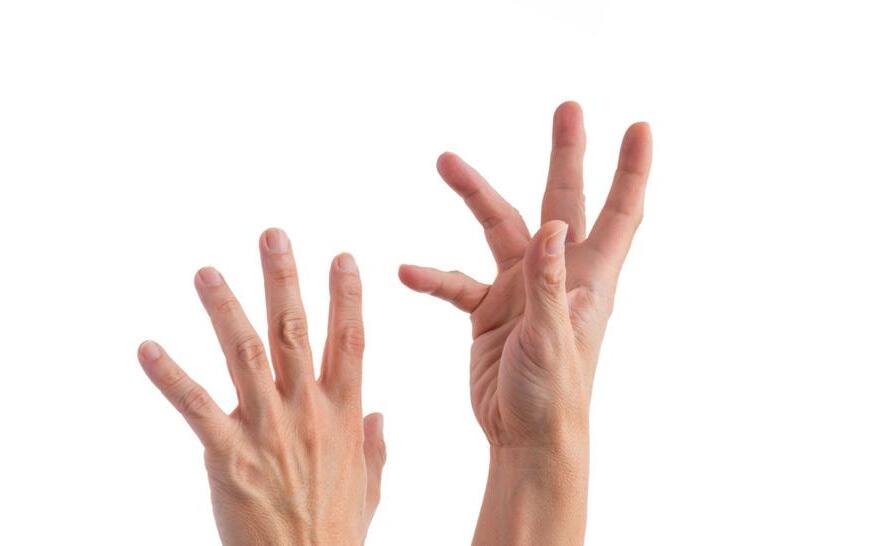
Stress can cause disruptions in the balance of hormones in the nervous system. It can cause an increase in the secretion of stress hormones like cortisol, which can trigger inflammatory changes in the body.

Adopting strategies to reduce stress can restore the healthy balance of stress hormones like cortisol and feel-good hormones like dopamine and serotonin in the brain, thereby preventing inflammation. Reducing stress can also restore the healthy activities of the immune cells, thus preventing the release of pro-inflammatory substances like cytokines and interleukins. This can help to reduce inflammation and protect the tissues against damage.
Chronic stress is associated with low-grade inflammation.
Acute and chronic forms of stress both increase inflammatory activity and cause cognitive stress reactivity. Chronic stress is predictive of depression symptoms. Prolonged stress over time reduces tissue sensitivity to the stress hormone cortisol making cortisol less effective at regulating immune and inflammatory responses. This altered state can also cause the body to initiate inflammation in response to stress.
Stress interplays with the immune system. When stress is acute, the immune function is enhanced compared to chronic stress, which acts as a suppressant.
Finding ways to reduce chronic stress will help restore a healthy balance of stress hormones, improves gut microbiome health, and deactivates the pathway of stressinduced-low-grade inflammation.
3. Digestive Issues
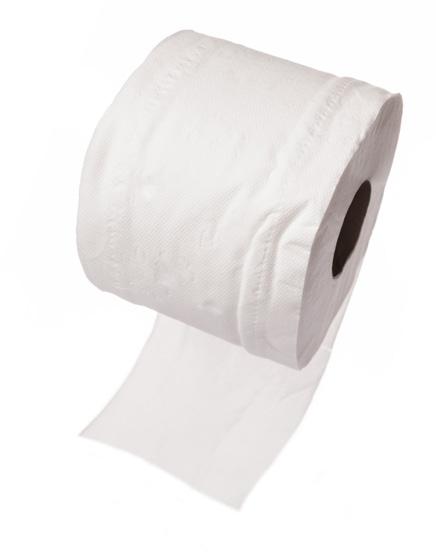
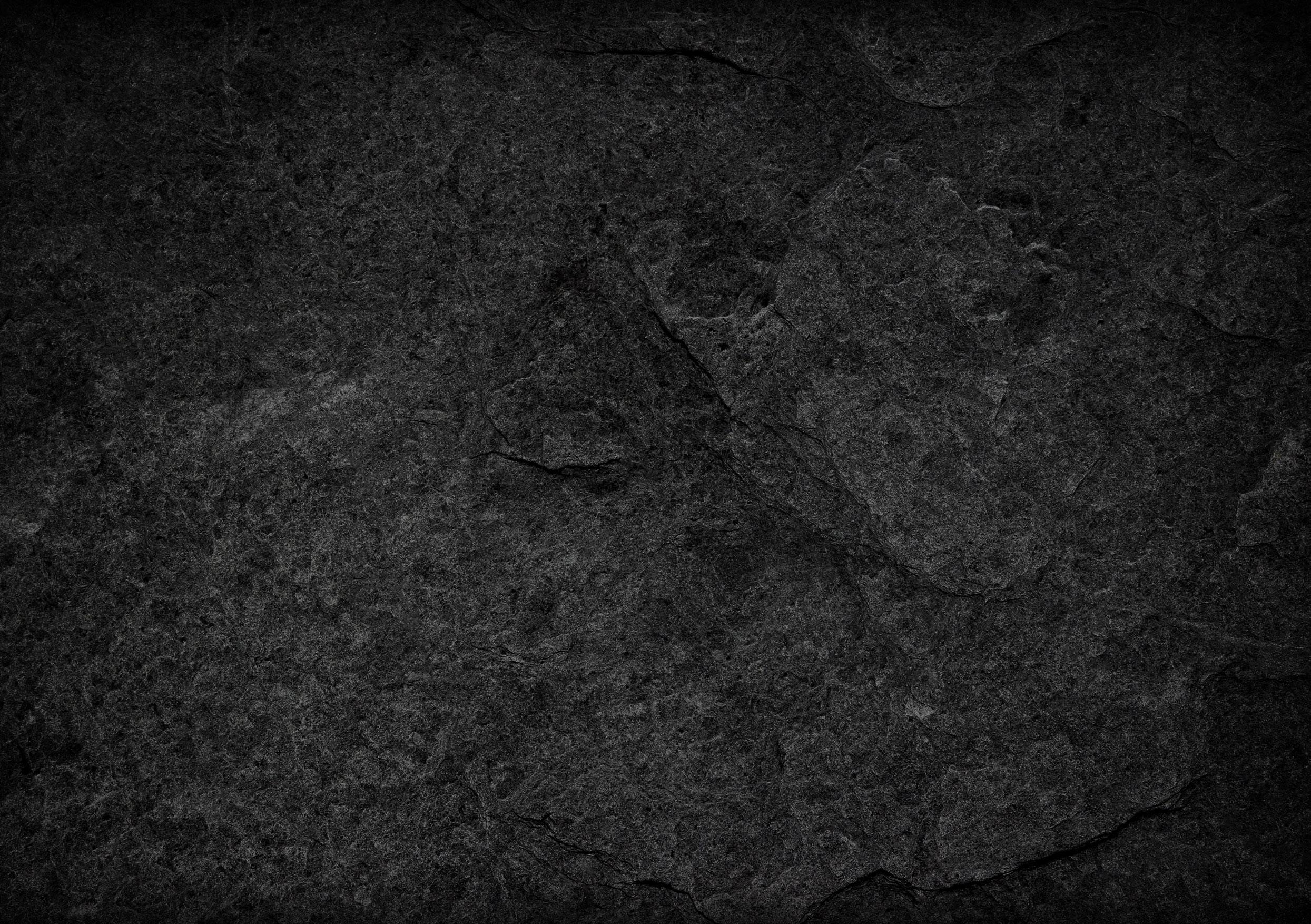
Abdominal pain, cramps, diarrhoea, and excessive flatulence are common gastrointestinal (GI) complaints and can be a sign of gut inflammation.
Gut inflammation is a sign of imbalances in the gut microbiome. Gut imbalance, or dysbiosis in scientific terms, is common in people with gut inflammation.
When disruption strikes the gut microbiome, the health of the trillions of gut bugs (microbes) that make up the microbiome suffer, diversity reduces, and bad versus good becomes a problem. Proinflammatory cytokines are released by the changed group of gut bugs, thus promoting gut inflammation.
Once favourable conditions become unfavourable, chronic inflammation sets in. Interestingly, dysbiosis isn’t just a GI complication. It is also linked to other non-GI-related conditions. The link between chronic inflammation and the gut microbiome is intricate and complex. Learning more about this relationship helps us understand more about what we can do to avoid developing chronic inflammation and chronic diseases, how we can treat common inflammatory disorders, and how best to exit the vicious cycle.
Inflammation present in the gut increases the risk of developing chronic conditions, cancers, and also suffering from gastrointestinal disorders such as:
• Crohn’s disease
• Ulcerative colitis
• IBS
• Celiac disease
WHAT CAN HAPPEN WHEN INFLAMMATION IS PRESENT IN THE GUT?
Inflammation in the gut can make the mucus lining of the intestine weaker and can also lead to the development of ulceration in the intestinal mucosa. These changes can induce an increase in intestinal permeability leading to the development of leaky gut syndrome. When this occurs, gaps develop in the walls of the intestine, making it easier for infectious organisms and toxins from food to enter the bloodstream and reach other parts of the body. When these toxins are transported via the blood, it increases the risk of recurrent infections and inflammation. Exposing vital organs to toxins can also trigger cancerous and precancerous changes.
4. Insulin Resistance
Insulin is a hormone that helps regulate your blood sugar levels.
If you have elevated blood glucose levels, it’s a sign that your body either has a resistance to insulin or perhaps has a lack of insulin, and indicates that you may be suffering from either insulin resistance, pre-diabetes or diabetes – all of which are serious. Insulin resistance and type II diabetes are linked to many inflammatory chronic health diseases, including cancer.
Think of three people you know. Statistically speaking, one of you is likely to have insulin resistance. 1 in 4 people are believed to have insulin resistance, and 1 person every 5 minutes is diagnosed with type II diabetes! That’s 280 new cases each day, and is now the fastest-growing chronic disease globally.
Persistent elevated blood sugar levels and insulin resistance creates a proinflammatory environment and the perfect storm for developing chronic inflammation and getting stuck in the vicious cycle of the complications associated with chronic inflammation.
Sleep, diet, and exercise play a key role in managing insulin resistance and blood glucose levels. If you think you might be the one in four, speak to your doctor about getting tested.
Symptoms:
• Weight gain
• Skin tags
• Acne, eczema, psoriasis
• Waist circumference of 40cm or greater (or 35cm or greater for females)
• Poor sleep
• Brain fog
• Sugar cravings and increased hunger
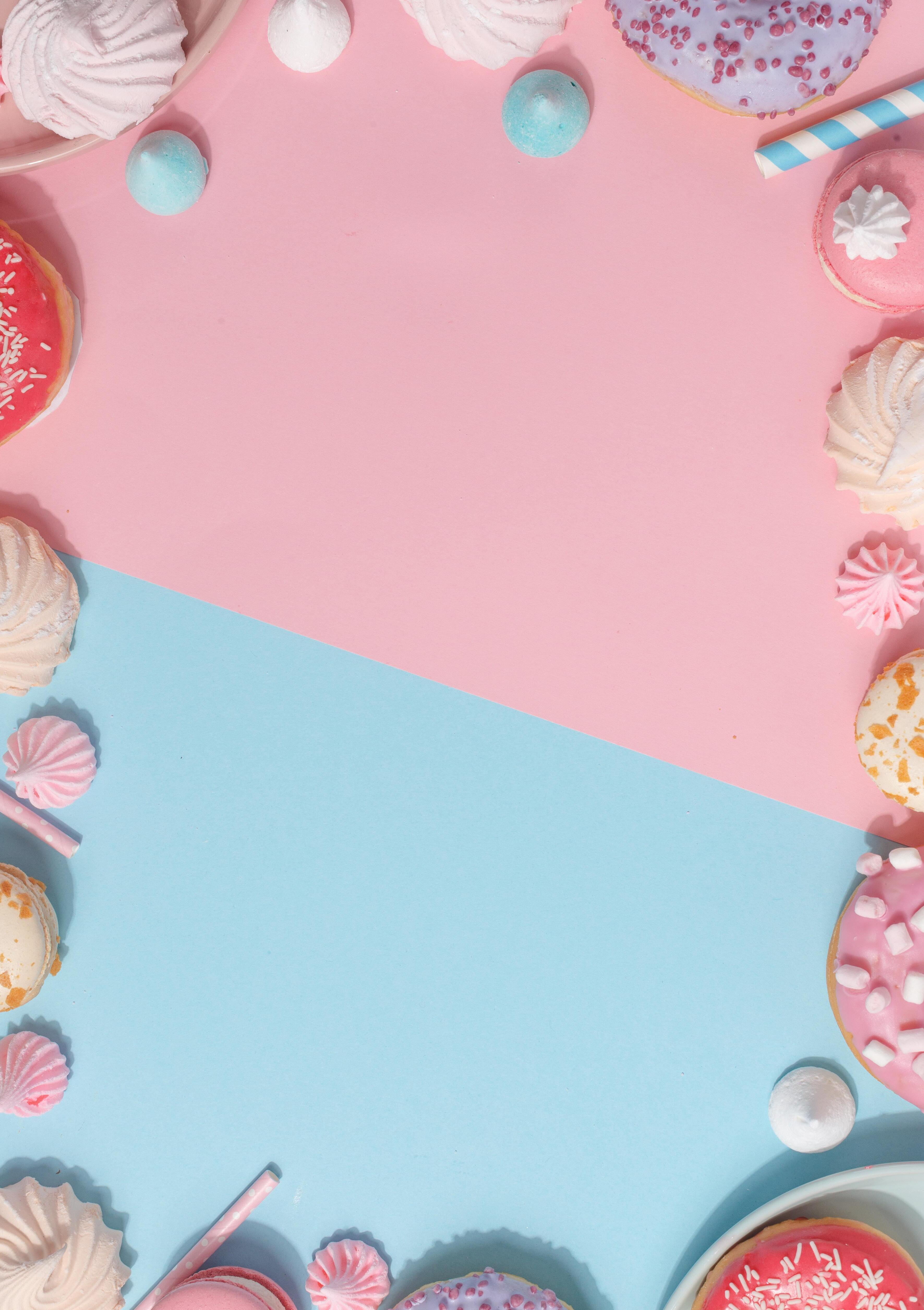
• Lethargy
Other Signs, Risk Factors & Complications:
• High blood pressure
• High cholesterol
• High triglycerides
• Family history of type II diabetes
• Past stroke event
• Sleep apnea
• Belly fat
• Overweight
• Smoking
• Inactivity
• Stress
• Non-alcoholic fatty liver disease
• Cancer
5. Autoimmune Conditions
Autoimmune conditions are on the increase and can kick start chronic inflammation as a result of the immune system mistakenly attacking healthy tissue.
Chronic information can weaken the immune system and cause disruptions in the activities of immune cells, thus increasing the risk of autoimmune conditions like lupus, psoriasis, eczema, rheumatoid arthritis, and thyroiditis. Chronic inflammation can also reduce the ability of vital organs to resist the activities of pro-inflammatory compounds, thereby contributing to the faster progress of autoimmune conditions.
Following an anti-inflammatory lifestyle and diet can support the reduction of inflammation and the strengthening of the immune system.
Various symptoms can occur in response to an autoimmune disease. It is best to speak with your doctor to find out if they are linked to an autoimmune condition. It is much easier to treat symptoms when the root cause is understood!
Types of autoimmune conditions
• Graves disease and Hashimoto’s disease: autoimmune conditions of the thyroid
• Rheumatoid arthritis (RA): attacks the joints and tissues
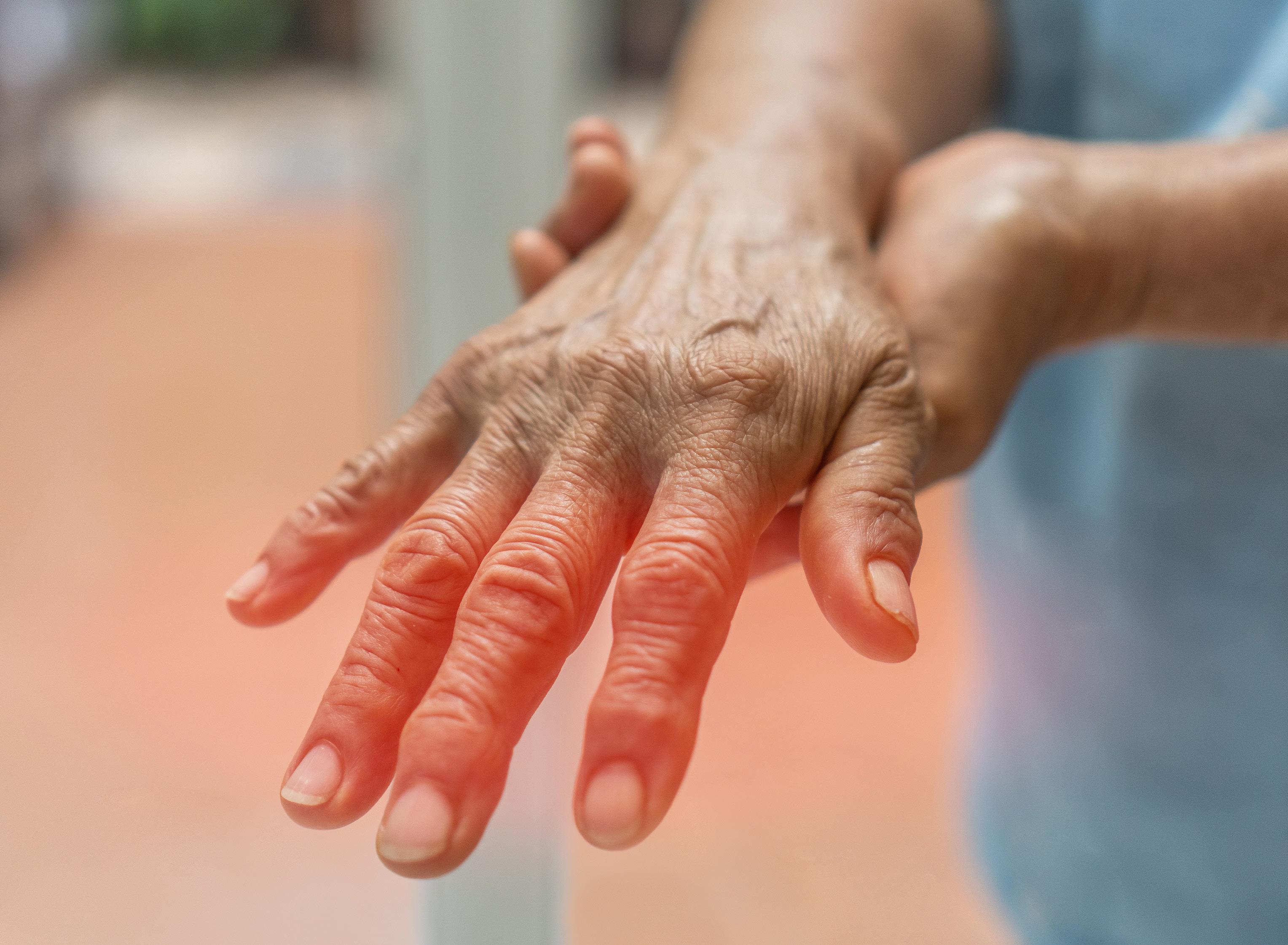
• Psoriasis: accelerates the life cycle of skin cells, causing a build-up of skin cells
• Lupus: causes the body to attack various tissues and organs
• Multiple sclerosis: attacks the myelin surrounding the nerve fibres
• Type 1 diabetes: causes the pancreas to produce very little or no insulin
• Celiac disease: has zero tolerance to gluten; eating gluten damages the small intestine
Common autoimmune disease symptoms
• Skin problems
• Fatigue
• Pain in joints
• Swelling in joints
• Digestive pain and discomfort
• Low-grade fever
• Unexplained weight loss or gain
6. Hypertension (High Blood pressure)
The WHO estimates approximately 1.28 billion worldwide suffer from hypertension, 46% remain undiagnosed, and only a mere 1 in 5 have high blood pressure well controlled. Hypertension is serious and is a contributor to premature death.
Inflammation can weaken the walls of blood vessels, thus affecting their ability to expand and relax in response to changes in blood flow. Inflammation, therefore, increases the risk of developing hypertension.
Inflammation also damages the tissues of the heart and contributes to the development of hypertension and other cardiac diseases. Atherosclerotic (build-up of plaque) also develops in response to the activation of inflammatory pathways.
Blood pressure comprises 2 variables, the systolic and diastolic values (you might see this displayed as 120/80, for example). The 120 is the systolic variable, and 80 is the diastolic. Systolic pressure is the force of pressure in the artery as the heart contracts and pumps blood out around the body, and diastolic pressure is the force of pressure when the heart relaxes in between heartbeats. Studies have found a link between the number of inflammatory cells and diastolic dysfunction in those suffering from hypertension and cardiac insufficiency. This suggests the role of inflammation worsens diastolic dysfunction.
The complications of suffering from hypertension include creating further serious damage to the heart and its functioning, stroke, vision impairment, chronic kidney disease, cognitive impairment such as memory loss, and erectile dysfunction.
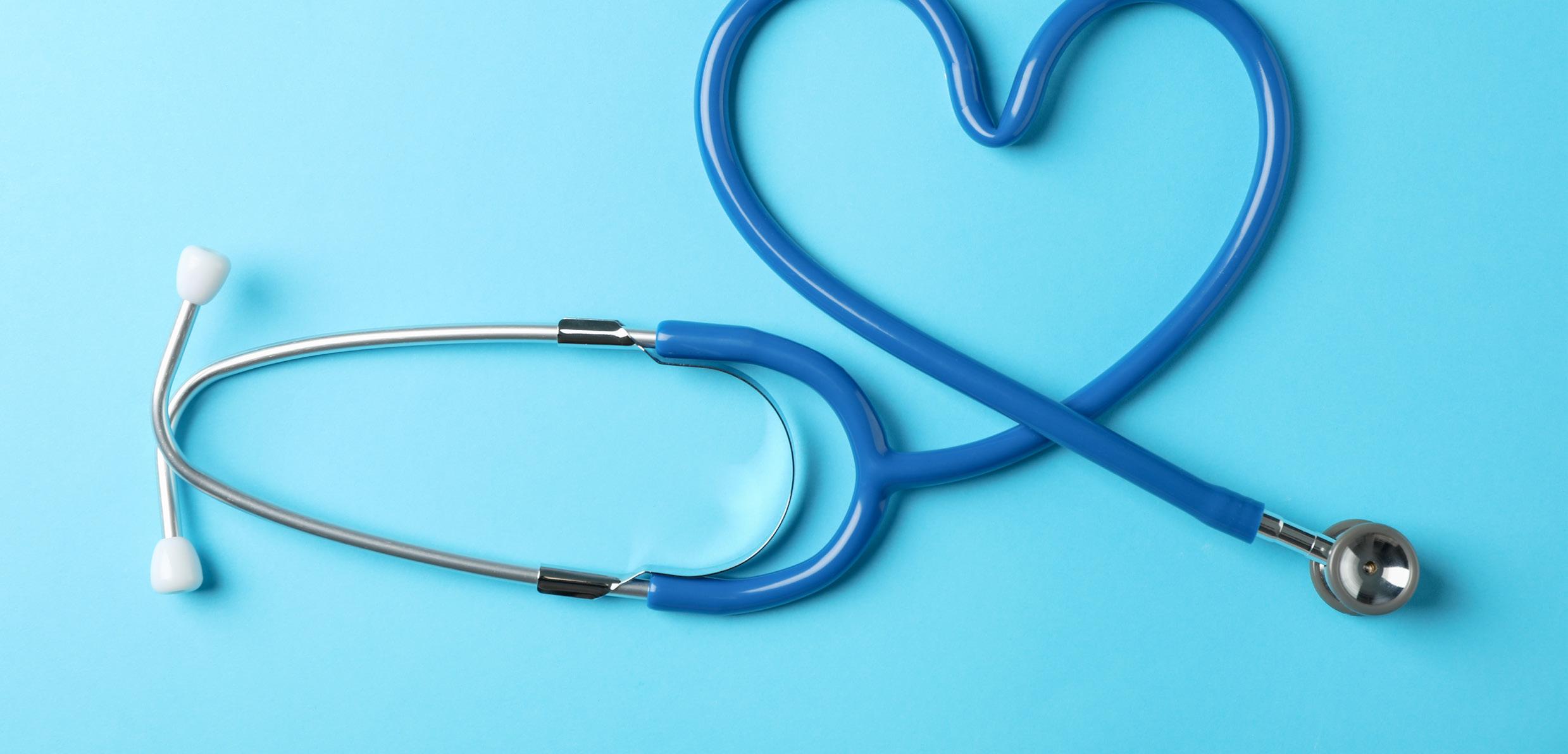
7. Joint Pain
Pain in the joints can be an indicator of inflammation. It can occur due to acute or chronic inflammatory changes in the joints as a result of injuries, increased strain, and pressure on the joints, or autoimmune conditions.
Rheumatoid arthritis is an inflammatory and autoimmune disease. Pain in the small joints, such as fingers and wrists, can occur due to the inflammation caused by the pro-inflammatory compounds released by the immune system. Inflammatory forms of arthritis occur when the body’s immune system attacks healthy tissues creating chronic pain for the sufferer by making joints swollen, stiff and painful.
Emerging research is taking a closer look at how the gut microbiome plays a role in the development of inflammatory arthritis. Given 70–80% of immune cells are found in the gut, should the gut microbiome suffer from dysbiosis, this can dysregulate the immune system causing it to attack the body.
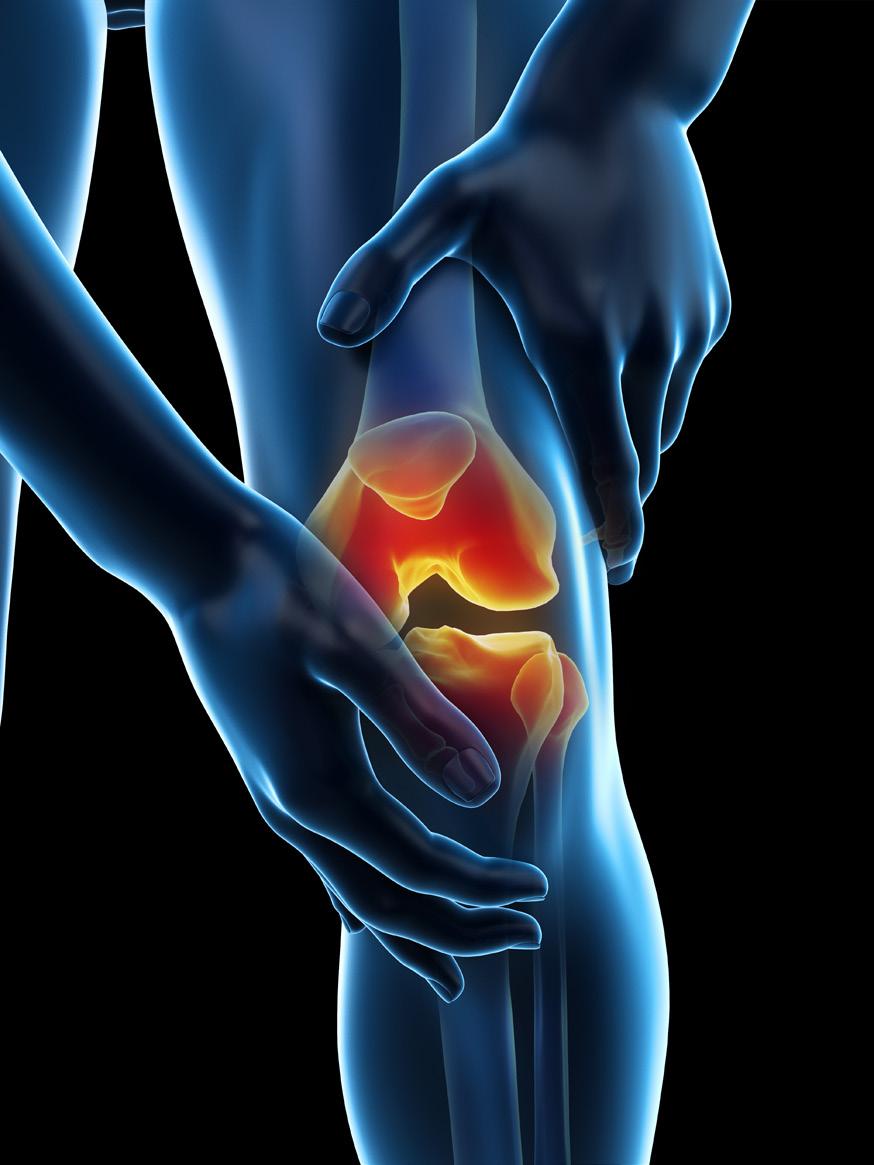
8. Skin Complaints
Acne, rosacea, psoriasis and eczema are common skin complaints and, while they present differently, evidence points to a gut-skin connection.
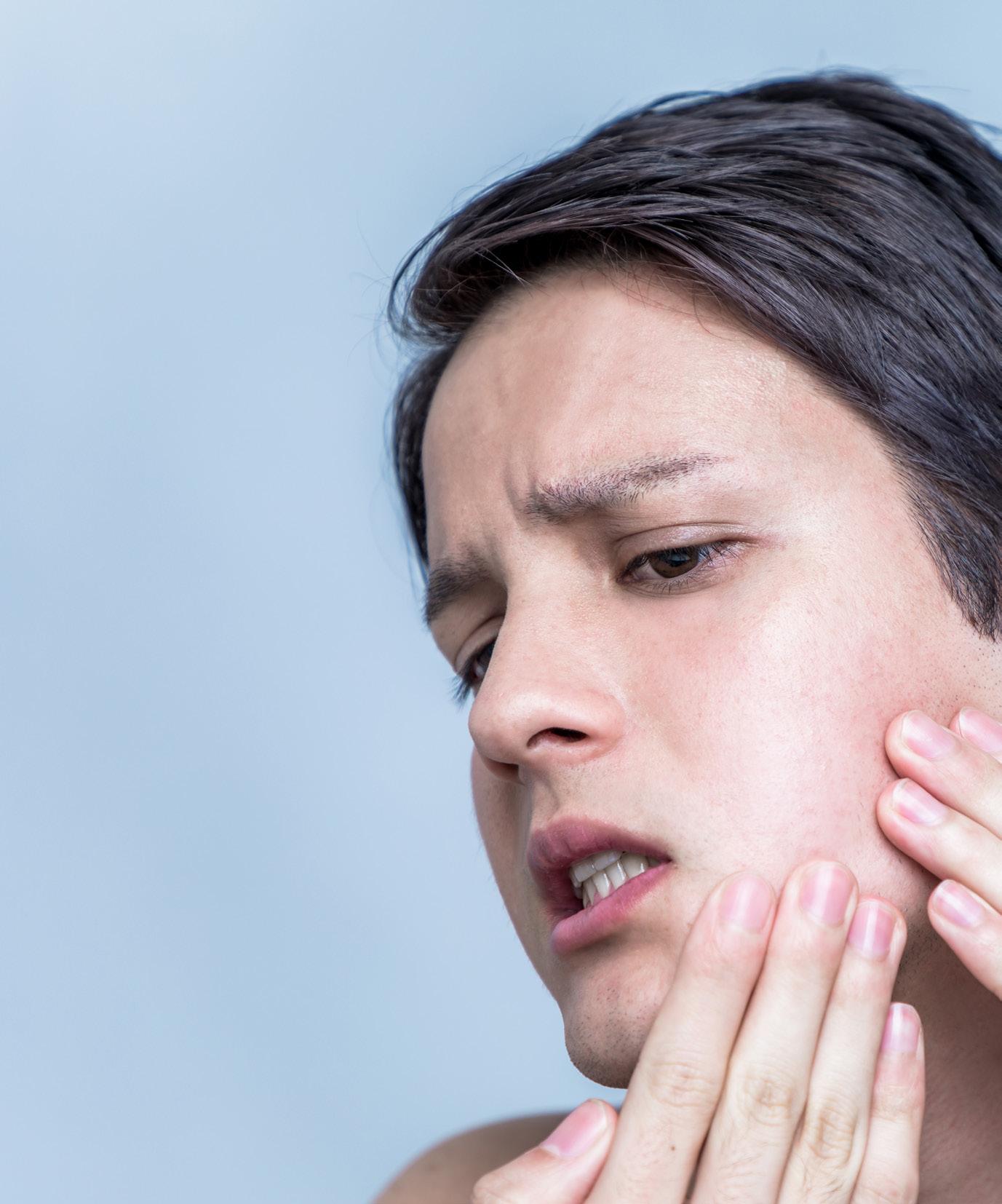
In a nutshell, an unhappy gut suffering from inflammation will externalise this inflammation through the skin.
Small intestinal bacterial overgrowth (SIBO) occurs when gut flora moves from the large intestine into the small intestine. This causes the gut lining to become irritated, signalling a release of pro-inflammatory cytokines inducing skin inflammation (identified as more prevalent in acne and rosacea sufferers).
Psoriasis is an autoimmune disease whereby the immune system initiates an inflammatory response. This response creates inflammation in the skin. Systemic inflammation can also manifest from psoriasis affecting other organs. Studies suggest candida overgrowth, also known as yeast overgrowth, is more likely to occur in people suffering from psoriasis. While there is no cure for psoriasis, emerging research speaks to the benefits of achieving good gut health through nourishing the gut with diet and nutritional support.
Eczema is another chronic inflammatory skin condition that can benefit from an internal and external treatment approach.
9. Forgetfulness & Memory Loss

Inflammation has emerged as a central pathology that is likely to play a role in the onset and progression of Alzheimer’s disease (AD). Memory loss and forgetfulness can occur due to chronic inflammation in the brain.
Inflammation in the brain can drive the progression and the development of amyloid plaque and tau tangles leading to the onset of dementia and AD.
The process of sleep plays an important role in brain health, cognitive abilities, and the development of neurodegenerative diseases such as AD. A special process that occurs during sleep helps to wash amyloid plaques out of the brain that builds up each day. This wash-out process occurs when cerebrospinal fluid is allowed to enter and then flush over the brain, washing out amyloid plaques, thus preventing a toxic build-up while also helping to promote healthy sleep and protect the memory capacity of the brain.
Emerging new research is beginning to demonstrate how inflammation in the brain and the interaction with amyloid plaques contribute to the progression of neurodegenerative diseases.
Diets high in foods associated with inflammation may accelerate brain aging, leading to dementia. Research has found diets that include good sources of omega-3s provide anti-inflammatory properties helping to reduce oxidative stress and inflammation, and improve cognitive function.
10. Sleep Troubles
Ever wonder why we often get sick with jet lag and abnormal sleep patterns?
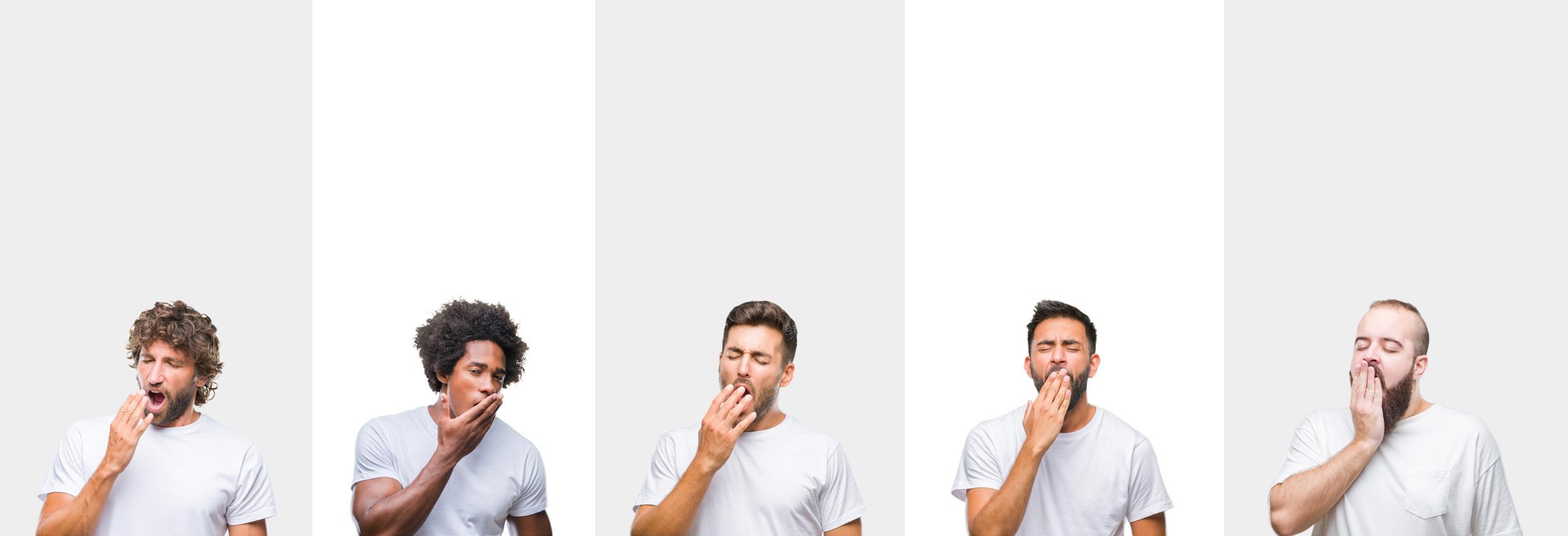
Two of the body’s most complex processes, sleep and immune health, are both regulated by circadian rhythms and therefore interlinked.
Just one night of sleep loss increases inflammation in the body.
Sleep is a complex process, and good sleep is essential for helping to protect against inflammation. But should sleep be lacking or disrupted, sleep can become a driver of rising levels of inflammation in the body.
Sleep intricately connects to your immune system, and both sleep and your immune system influence and impact the inflammatory processes in your body. Studies show that both too little and too much sleep can raise the levels of inflammatory markers.
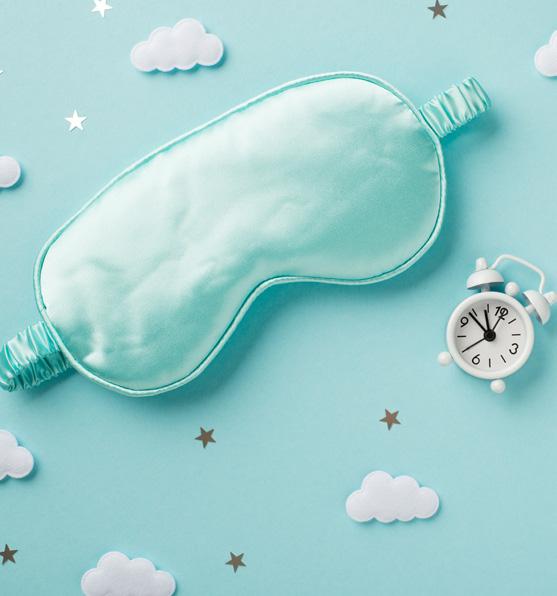
Suffering from stress can impede getting a good night’s sleep, and when stress becomes chronic, can lead to a vicious sleep-stress cycle, further fueling low-grade systemic inflammation. Good sleep, on the other hand, helps to reduce stress hormones and inflammation.
Obstructive sleep apnea (OSA) can induce systemic inflammation, thereby inducing cardiovascular disease (CVD). Researchers have found that obstructive sleep apnea syndrome promotes a persistent low-intensity inflammatory state. Intermittent hypoxia, the hallmark feature of OSA, can lead to the activation of inflammatory pathways that may contribute to endothelial dysfunction. When endothelial dysfunction occurs, the endothelium (the inner lining of cells) is damaged and blood vessels narrow as a result.
Disrupted sleep can also induce neuroinflammation and lead to cognitive impairments, and contribute – alongside inflammation and endothelial dysfunction – to erectile dysfunction.
Poor sleep is a driver for whole-body low-grade inflammation and can kick-start the vicious cycle of inflammation. Addressing insufficient sleep is one of the most advantageous ways to improve health, guard against inflammation, and start achieving desired body outcomes.
Next Steps
The fastest way to get to where you want to be is to resist the urge to delay and instead get actionable about getting to the root cause behind the reason for your niggling symptoms.
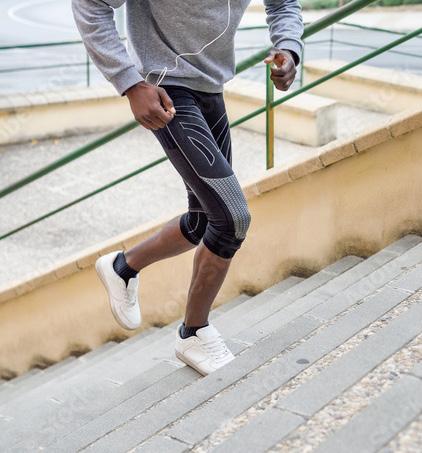
Slow-burning inflammation is persistent, relentless and detrimental to your health. The only way to help put the flame out is to find out why and then start anti-inflammatory tactics. Nutrition, sleep, exercise and minimising stress are powerful, affordable, and accessible antiinflammatory strategies.
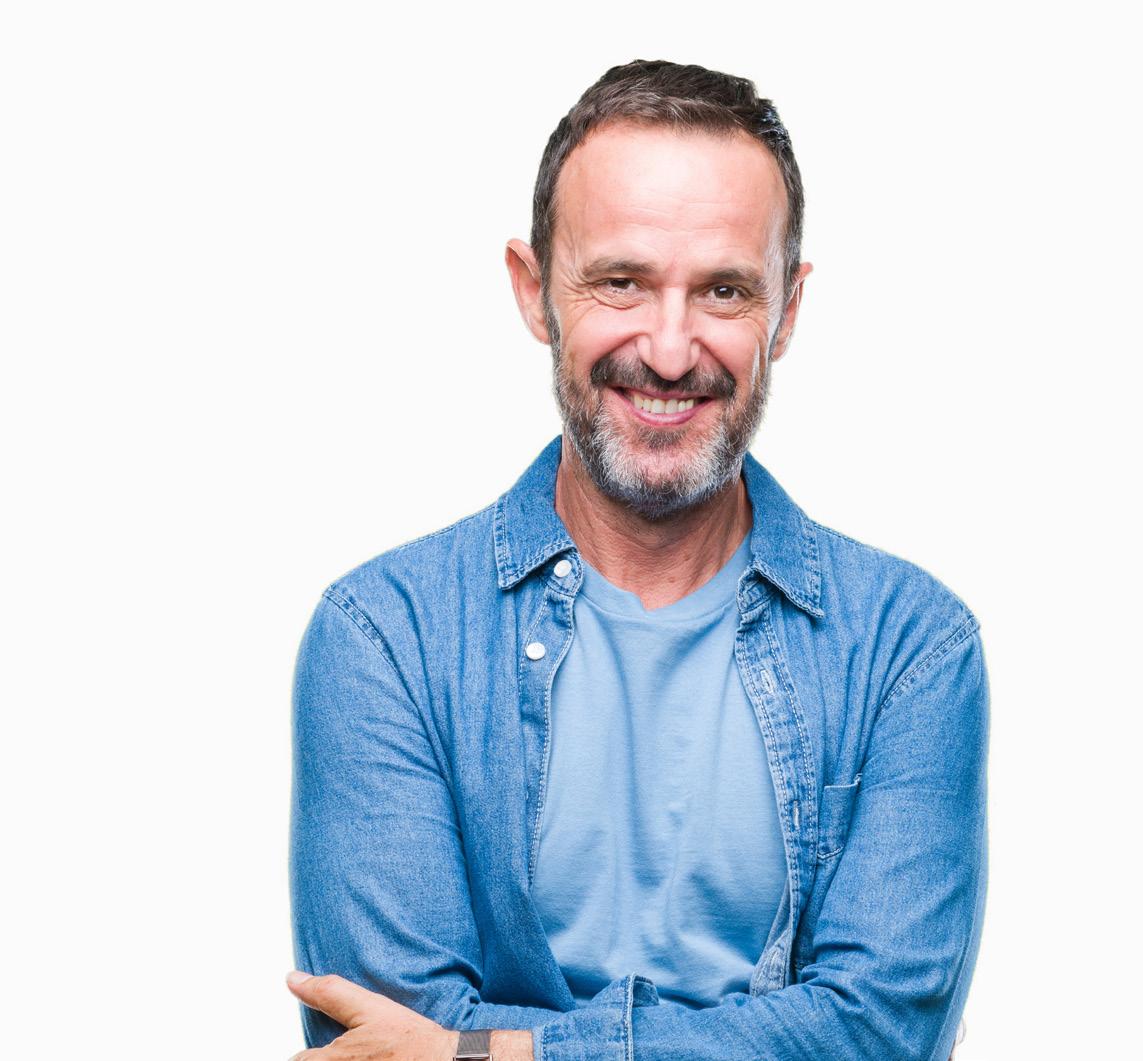
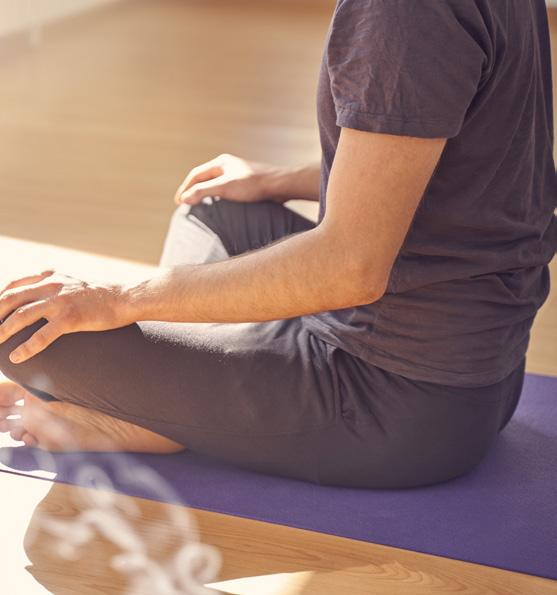
What’smakingus
FAT
and causing carb and sugar cravings?
When you’re resistant to insulin, your body’s cells find it harder to absorb blood sugar and convert into energy. An expanding waistline and excess kilos are just the beginning. Learn how to stave off sugar cravings, stabilise your blood sugars and shed the excess kilos.
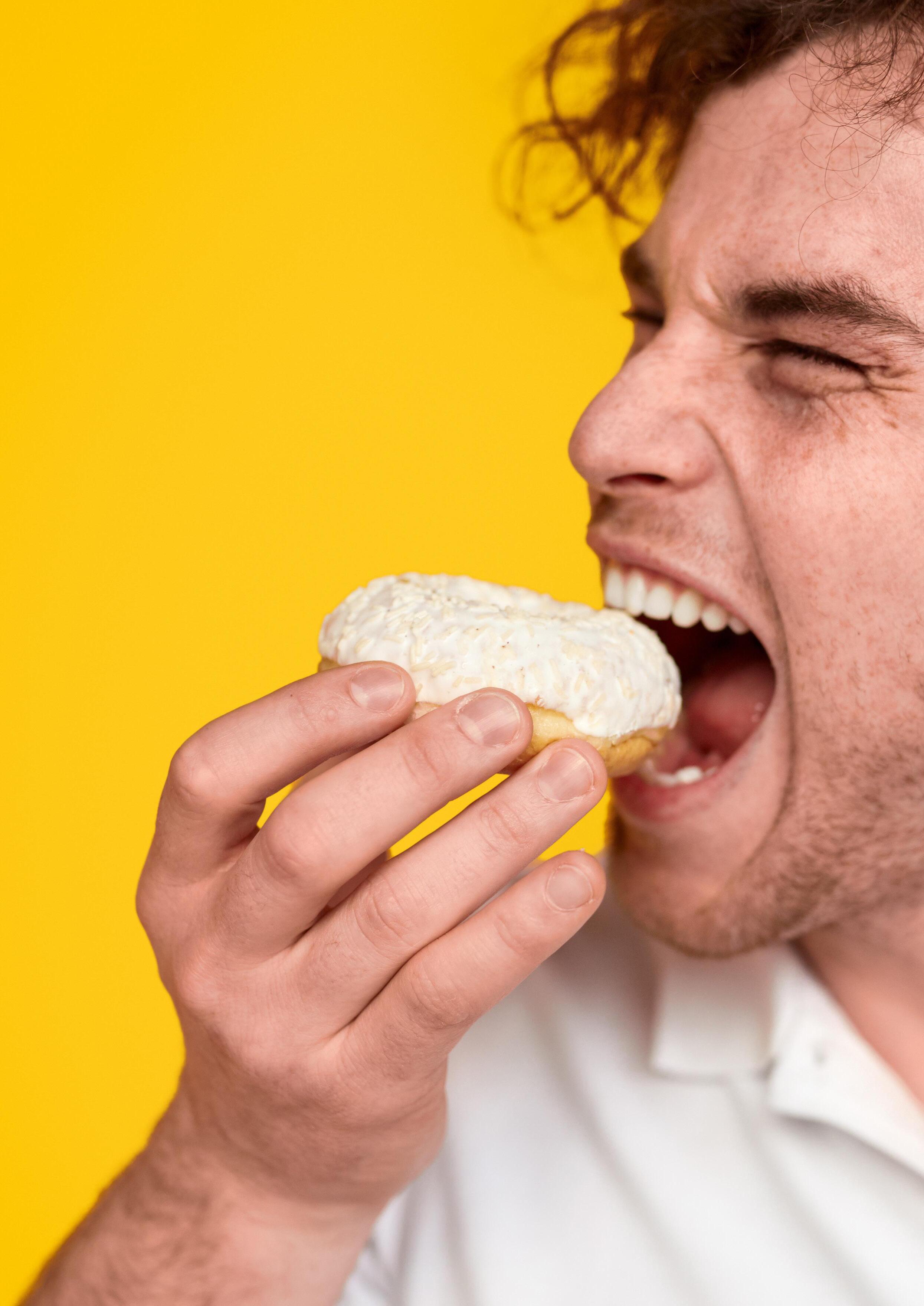 WORDS BY GERALDINE GEORGEOU Accredited Practising Dietitian DIRECTOR OF DESIGNER DIETS
WORDS BY GERALDINE GEORGEOU Accredited Practising Dietitian DIRECTOR OF DESIGNER DIETS
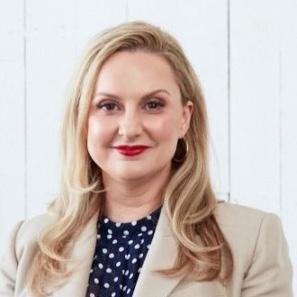
WHAT IS INSULIN RESISTANCE?
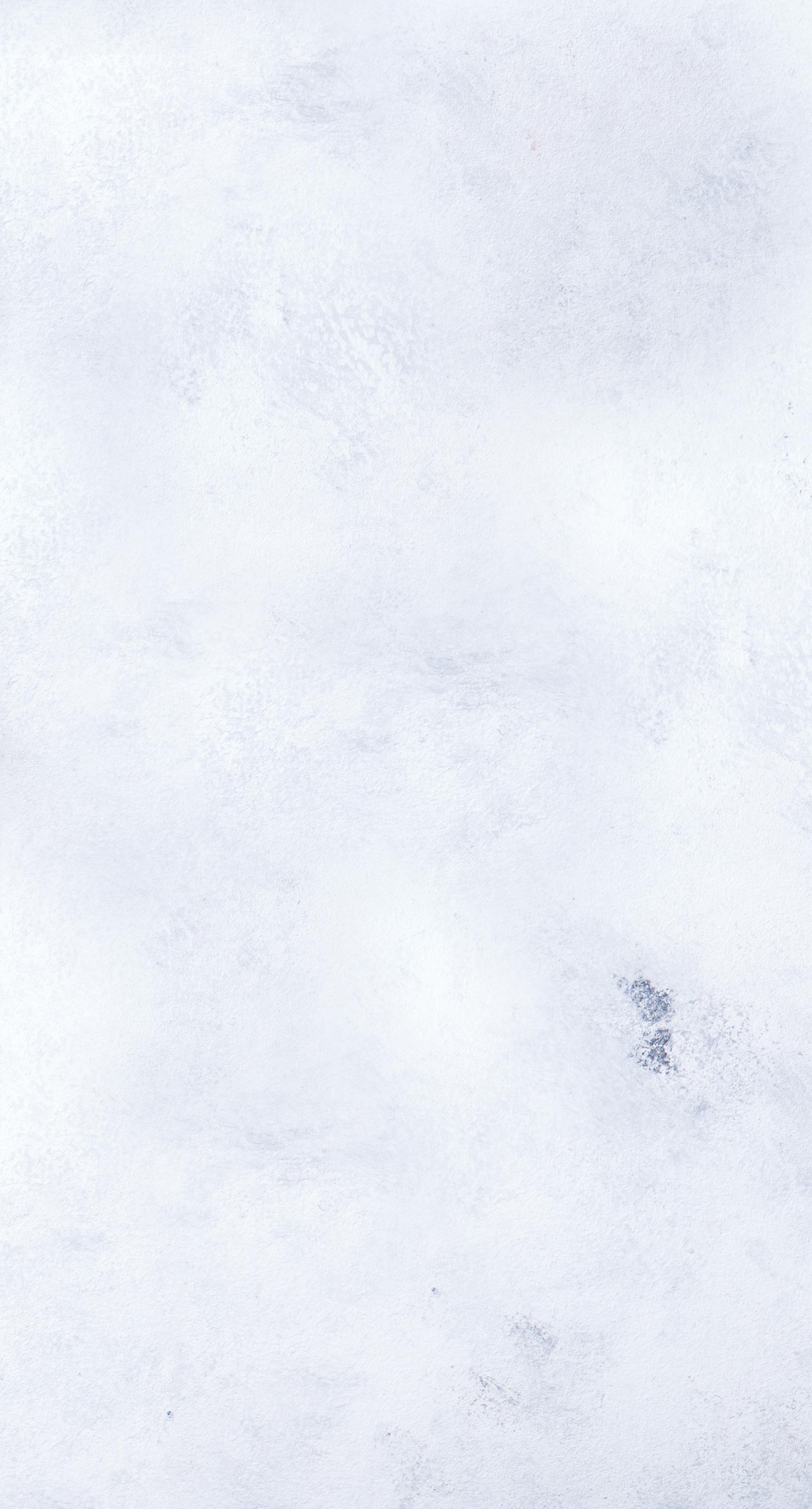
Now, I hear you ask, “What does insulin-resistance mean?” In a nutshell, insulin resistance is a complex genetic condition that can increase slowly with age. Insulin is a hormone secreted by the pancreas and used to digest carbohydrates. Carbohydrates are found in plantbased foods, including bread, rice, breakfast cereal, pasta, fruits, and sugars. When carbohydraterich foods are consumed, insulin is secreted by the pancreas to take glucose from the food to the muscles for energy. For a number of reasons, over time, insulin may fail to work as well as it should, and your body can start over-producing insulin.
Eventually the pancreas can no longer make enough insulin to control the blood glucose levels and impaired glucose tolerance results, and the next stage is diabetes where the blood glucose is significantly elevated.
WHAT CAUSES SUGAR/ CARBOHYDRATE CRAVINGS?
Glucose levels can rise and fall quickly (instead of being stable) when you don’t include small healthy snacks in between meals throughout the day. Great snacks to curb this include reduced-fat yoghurt, fresh fruit, nuts, reducedfat cheese, and wholegrain crackers. When glucose levels aren’t stable, this can stimulate excessive hunger at main meals such as dinner… which can lead to the “nibbles” after dinner.
Balancing lean protein, low GI carbohydrates and controlled fats is key to create a low glycaemic load, less insulin spikes which then creates a slow and steady release of glucose in the bloodstream helping you feel satiety or basically “full and happy”.
AIM TO EAT HEALTHY FATS, LEAN PROTEINS AND LOWGI CARBS EVERY 3–4 HOURS
Skipping snacks can lead to immense sugar cravings if ignored, and skipping meals such as breakfast, eating a small-sized lunch, or not having a balanced snack, particularly in the afternoon, can lead to coming home from work starving and running the risk of bingeing on sugary foods before or after dinner.
It is important to include low-GI carbohydrates, balanced with lean protein and good fat meals throughout the day to keep your blood glucose levels steady, avoiding those ups and downs. Many of my patients come to me consuming meals without some form of carbohydrates, leading to feelings of hunger and lethargy which leads to snacking on junk food (often late at night). This adds unnecessary calories to your diet, and eating more calories than what you burn off leads to a surplus of energy your body converts into fat tissue.
Try this for a balanced dinner: a lean beef steak with a small baked sweet potato and steamed green beans and broccoli to provide a feeling of fullness. If you don’t maintain a balance of healthy fats, lean proteins, and unrefined low-GI carbohydrates in your meals, you risk feeling dissatisfied, which ultimately leads to a risk of overeating and weight gain.
BOREDOM EATING
Boredom can be a huge factor in eating when we are not hungry. Eating provides enjoyment as our body releases endorphins making us feel happy, which can compensate for the lower levels of energy that boredom gives us.
It is very easy to over-indulge when bored as we tend to eat mindlessly,
either when watching TV or sitting at the computer. It takes our brains over 20 minutes to register that we’re full, so taking frequent breaks in snacking allows the brain time to catch up and process what’s happening.
You can easily consume half to an entire calorie intake for the day in one snack if you’re not aware of what you’re eating, so try and be mindful of what you are putting into your mouth! Even a snack considered generally healthy can easily add up. For example, dried fruit (1/2 up) and nuts (1 cup) = ~
1200kcal which could be half your calorie intake for a man. Better snack ideas include one medium sized fruit, such as an apple, and unsalted nuts (½ cup), or 150g of a higher protein greek yoghurt with berries. You may also prefer a slice of wholegrain or sourdough bread with 1 tbsp of nut butter and a cup of tea which would be great.
FOODS TO WATCH OUT FOR!
Although certain foods can be found in the health food aisle, like vegetable chips and date balls, do not assume they are necessarily healthy. Fried vegetables such as chips are generally fried in oil and provide little nutritional value whilst packing a punch when it comes to calorie content. They provide little fibre and no protein, meaning a large amount is needed in order
Binge eating, even on healthy foods, will lead to weight gain if you eat more calories than your daily requirement.
to feel full – which leads to a large calorie intake. Energy, protein or bliss balls (as they’re known) of all varieties can include lots of yummy ingredients like dried fruit and nuts. Nuts are a great source of protein and good fats, and dried fruit provides fibre as well as a range of vitamins and minerals. However, considering they range from 600 to 800 kilojoules for just one 40–50g protein ball, we need to control our portions! Hidden excess kilojoules will pack on those unwanted kilos.
WHERE TO GO FOR HELP!
If these scenarios are familiar to you, ask your doctor to test you for insulin resistance. A blood test could mean the difference between a life with or without diabetes.
The treatment for insulin resistance starts with the help of an Accredited Practising Dietitian. Through controlled and balanced carbohydrate, protein and healthy fat intake, we can help manage and even treat insulin resistance and prevent metabolic diseases including diabetes.
Visit designerdiets.com.au/ to book an appointment with us to begin your healthy journey.
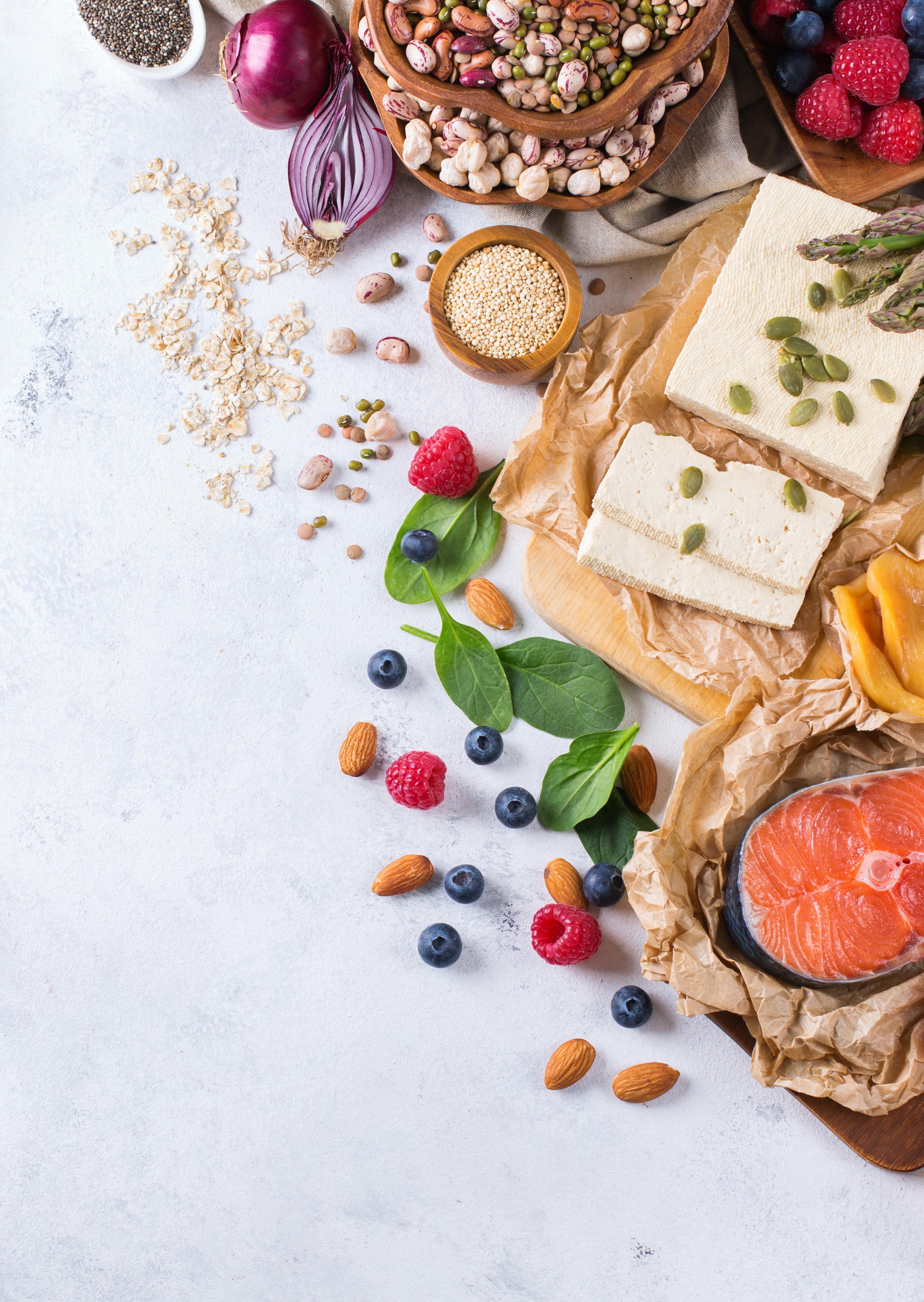
Medications may also be prescribed, and working with daily food intake and physical activity are all important factors in the treatment of insulin resistance.
A-Z A-Z A-Z
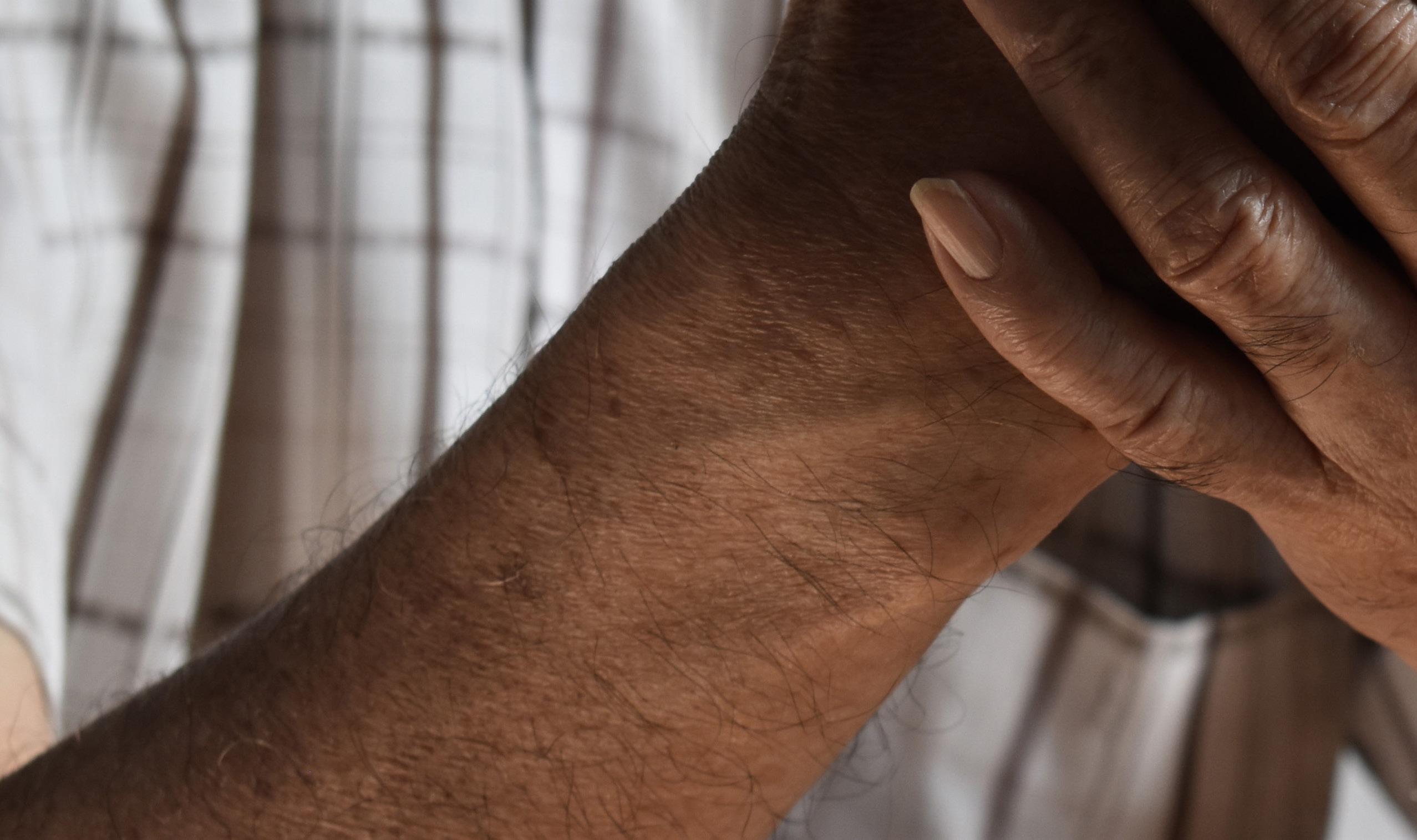
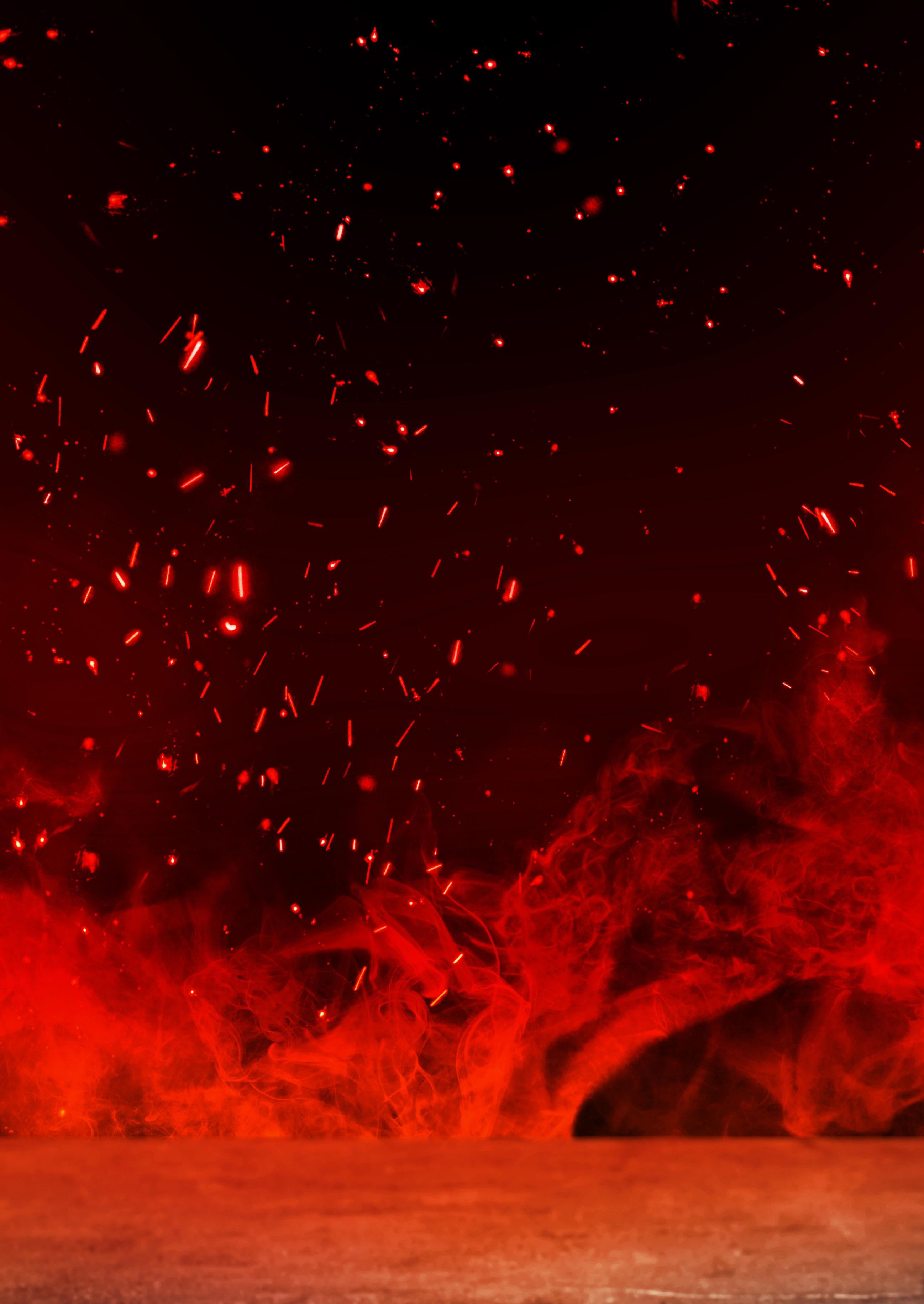
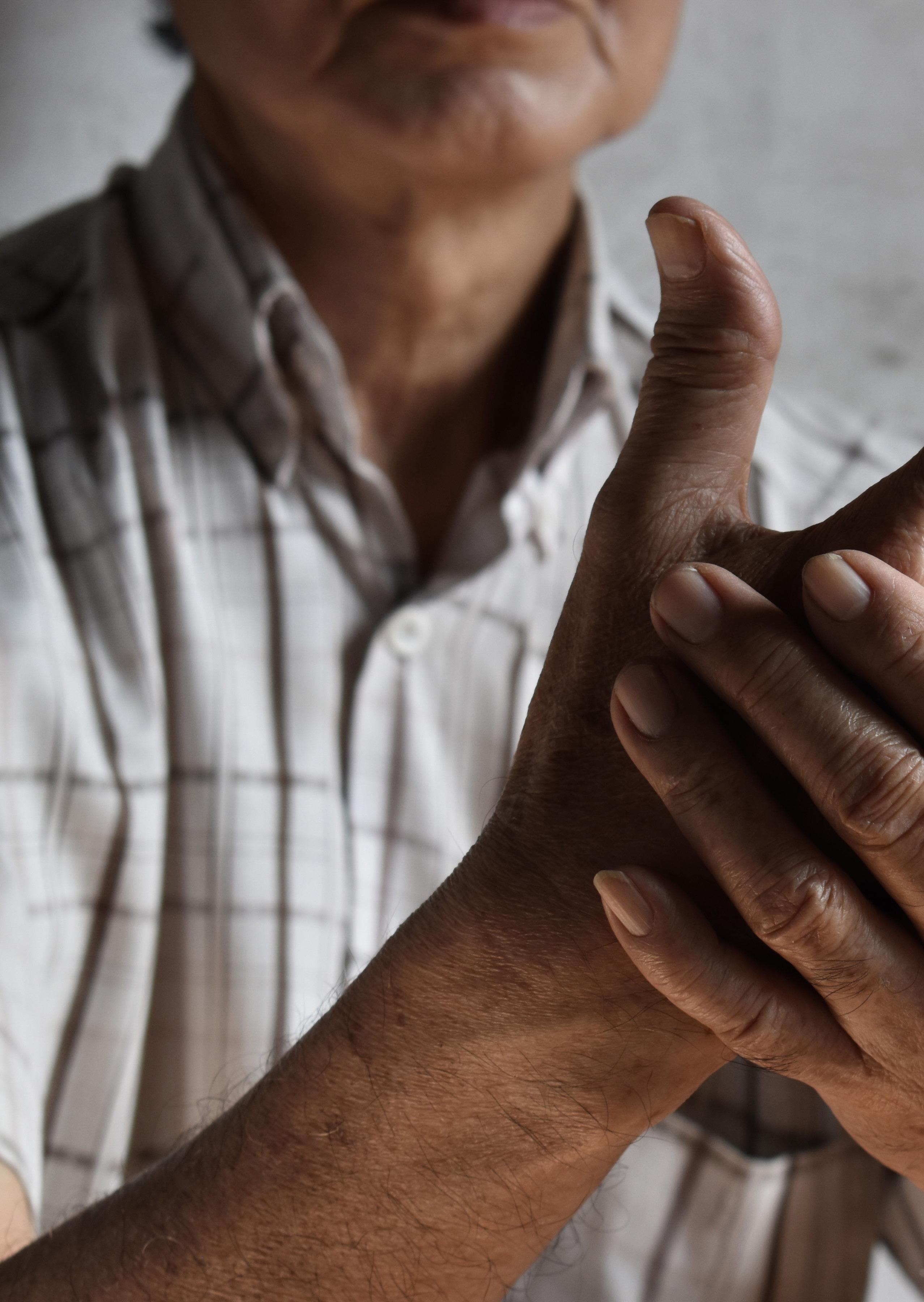
A-Z A-Z A-Z
ANTI-INFLAMMATORY
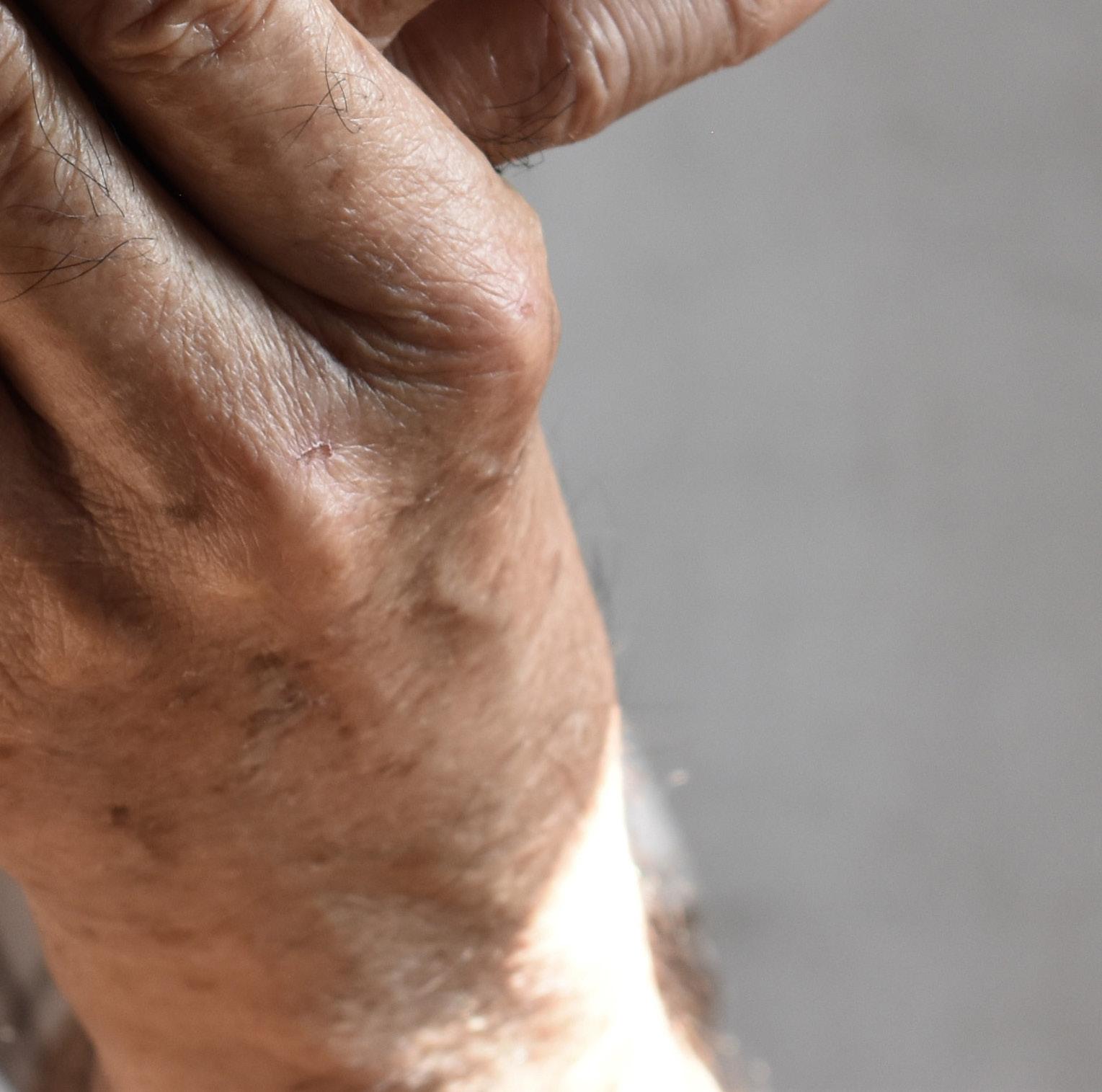
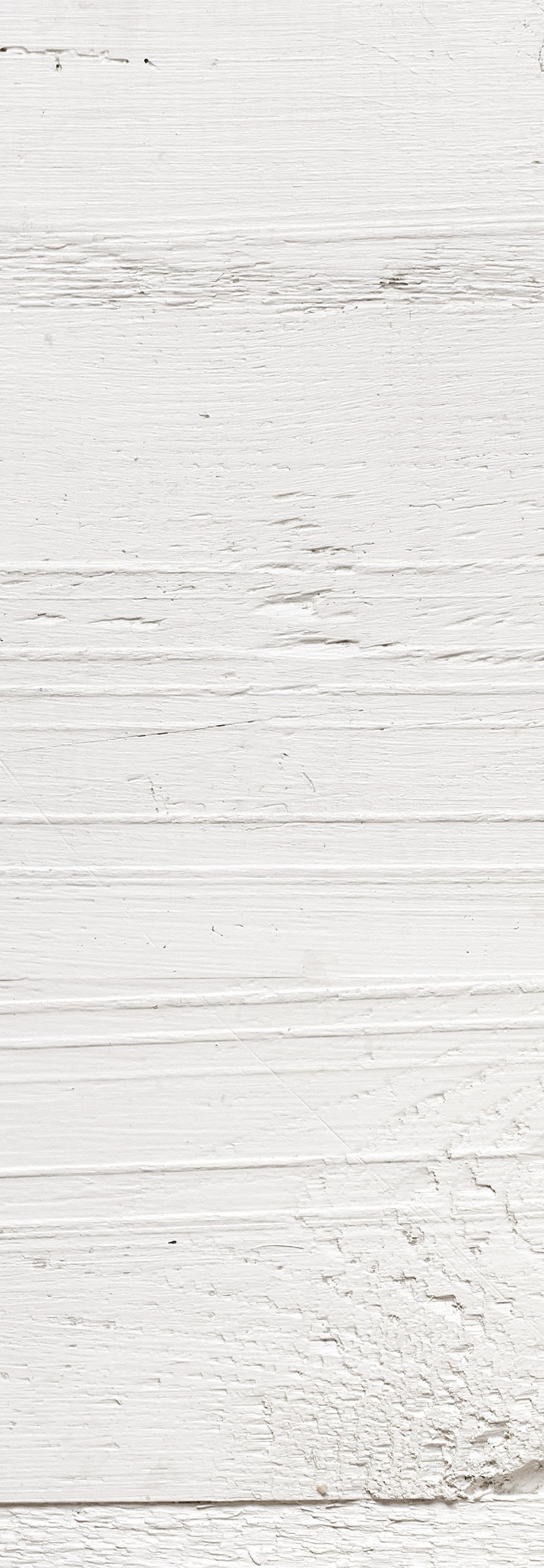
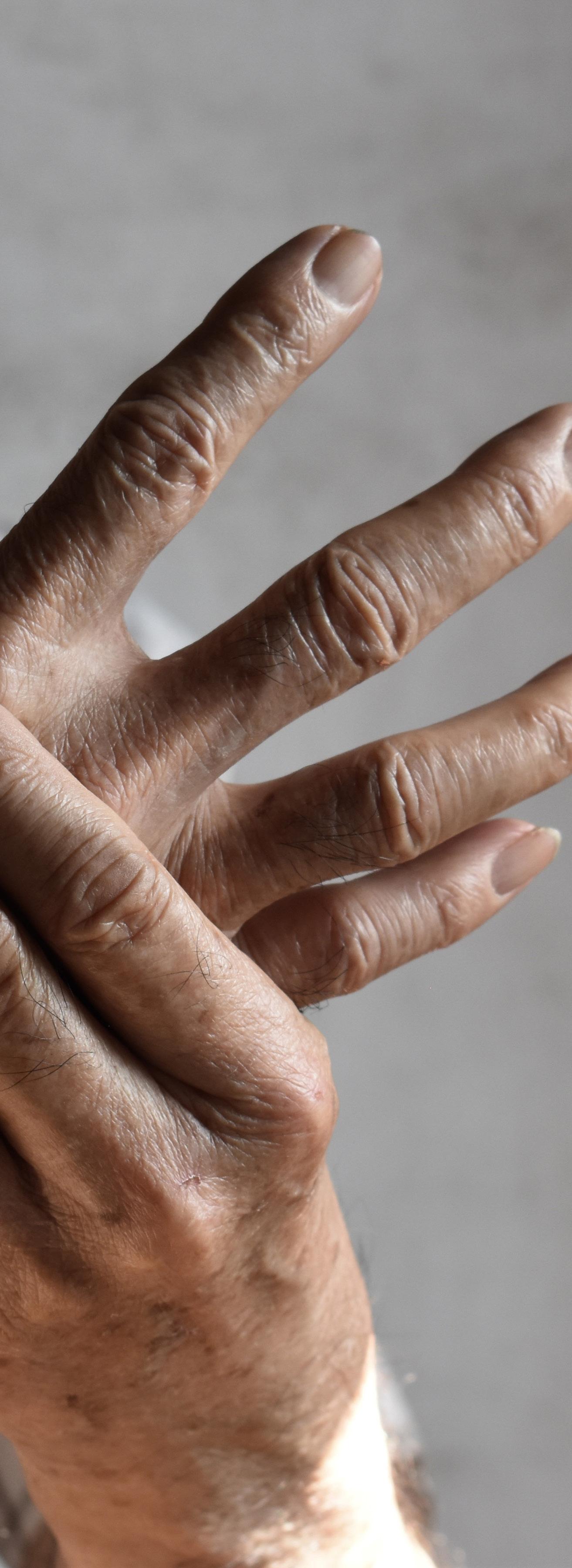
Olivia Wills
Olivia Wills is an Accredited Practising Dietitian, Nutritionist, Author, Researcher and Presenter. She spent 15 years as an Elite Athlete and is currently completing a Doctorate of Philosophy (PhD) on the role of diet in multiple sclerosis management. Olivia is an award-winning advocate for the importance of diet in the management of complex medical conditions.
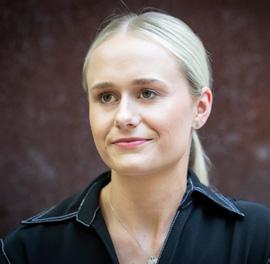
One simple analogy to understand the damaging effects that chronic inflammation can have on your body is to compare it with the 2005 cinematic classic “King Kong.” In the same way that a giant ape takes over the city of New York, inflammation is a destructive process, and a state of chronic inflammation can lead to the development of many serious chronic diseases such as diabetes, arthritis, inflammatory bowel disease, and even some cancers.
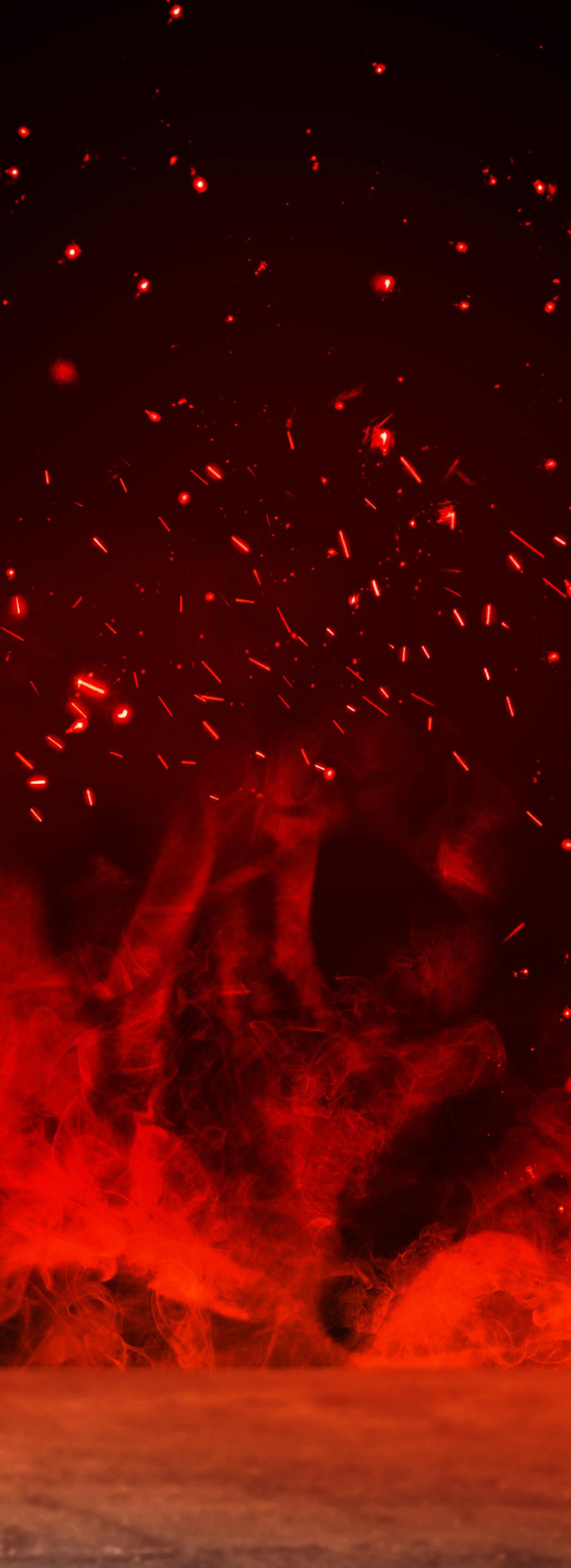
What if we told you that one way to protect yourself from the damaging effects of chronic inflammation is through what we eat?
You heard right! I’ve put together a list of A-Z anti-inflammatory food tips and have explained how to make these changes to your diet and the science behind them, so you’ll not only be left feeling stronger but appreciate just how important food is in taking control of your own health.

Let’s get started.
AA is for antioxidants
Antioxidants are a type of natural molecule found in the body to help neutralise, protect and counteract unwanted inflammatory responses from occurring. Nutrient antioxidants occur naturally in plant-based products such as vitamins A, C and E and minerals such as zinc
Incorporating antioxidant substances in your daily diet may help to solve health issues associated with various inflammatory illnesses. You may have heard that blueberries are one of the best sources of dietary antioxidants. Aim for a handful of fresh blueberries in your morning smoothie or as a topper on your breakfast cereal.
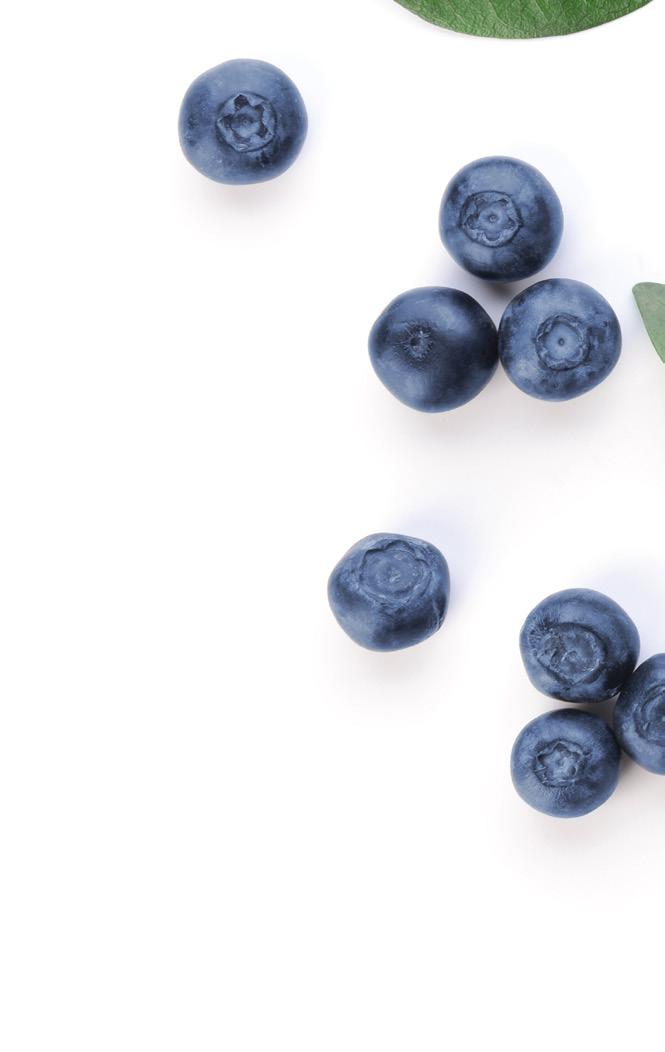
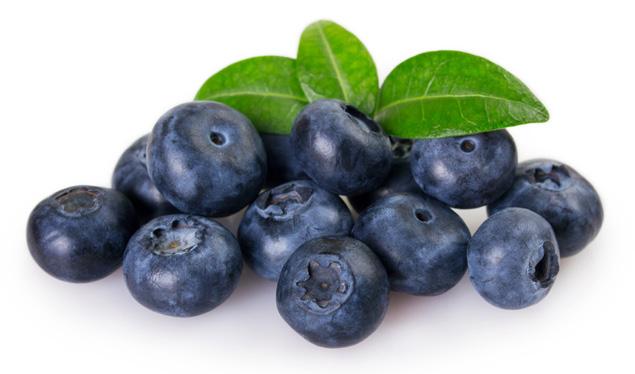
CC is for colour
Bwith anti-inflammatory and antioxidant compounds such as phytonutrients, soluble fibre, and protein.

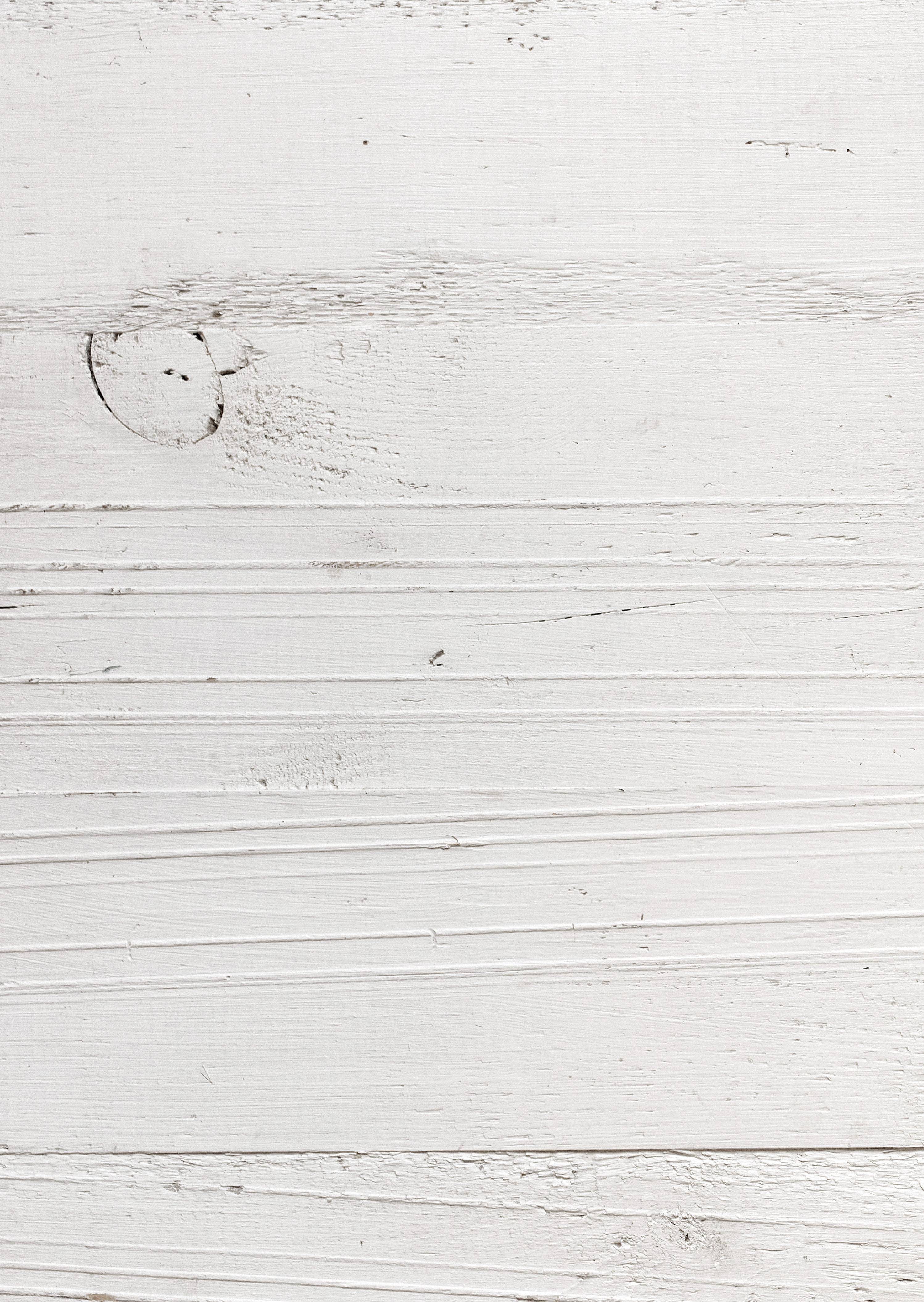
Aim for 2–4 serves of beans per week

You may have heard the saying, “eat the rainbow.” Well, this isn’t because it looks good on the plate. Each colour or phytonutrient has important antioxidant properties and may reduce the risk of cancer and heart disease, support cognition, and decrease inflammation.
To eat the rainbow, try and incorporate a variety of different coloured fruits
D is for dark leafy greens
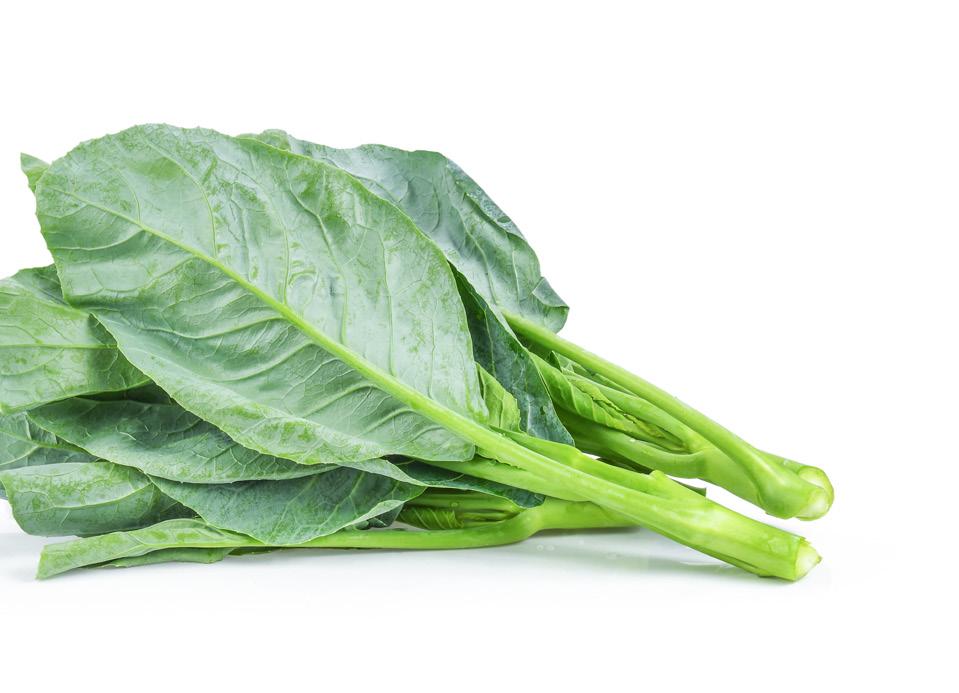
One good inflammation-fighting vegetable that most of us overlook and don’t get enough of is dark leafy greens. These include spinach, kale, chard, collard, and turnip greens, which contain vitamins A, D, E and K. These nutrients have been found to fight inflammation.
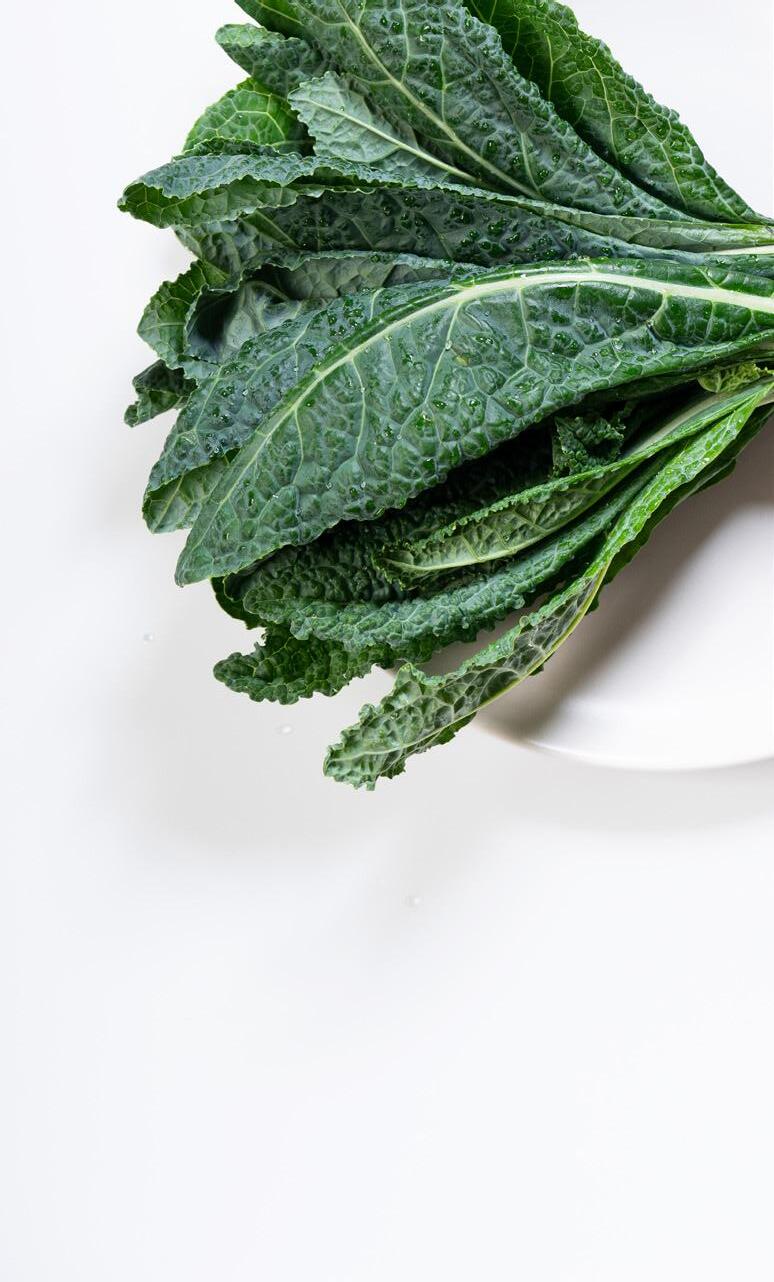
Did you know that these nutrients are best absorbed when paired with a source of dietary fat? So next time you are making a side salad with these leafy greens, finish by drizzling with a full-fat salad dressing such as French or balsamic vinegar. This will enhance absorption for their antioxidant properties to work at best.
F is for fibre
E is for excessive alcohol consumption
It is long known that overconsumption of alcohol can have serious detriments to your overall health. While there is no safe level of drinking alcohol, guidelines have been developed to reduce the risk of alcohol harm and improve the lives of Australians. The guidelines recommend no more than 10 standard drinks per week and no more than 4 standard drinks on any one day.
G is for gut microbiome
E F G
There are many different mechanisms by which adequate dietary fibre intake may help to lower inflammation. Whether it be through feeding the gut microbiome or helping to reduce overall body weight, women should aim for 25g of fibre and men 30g of fibre per day.
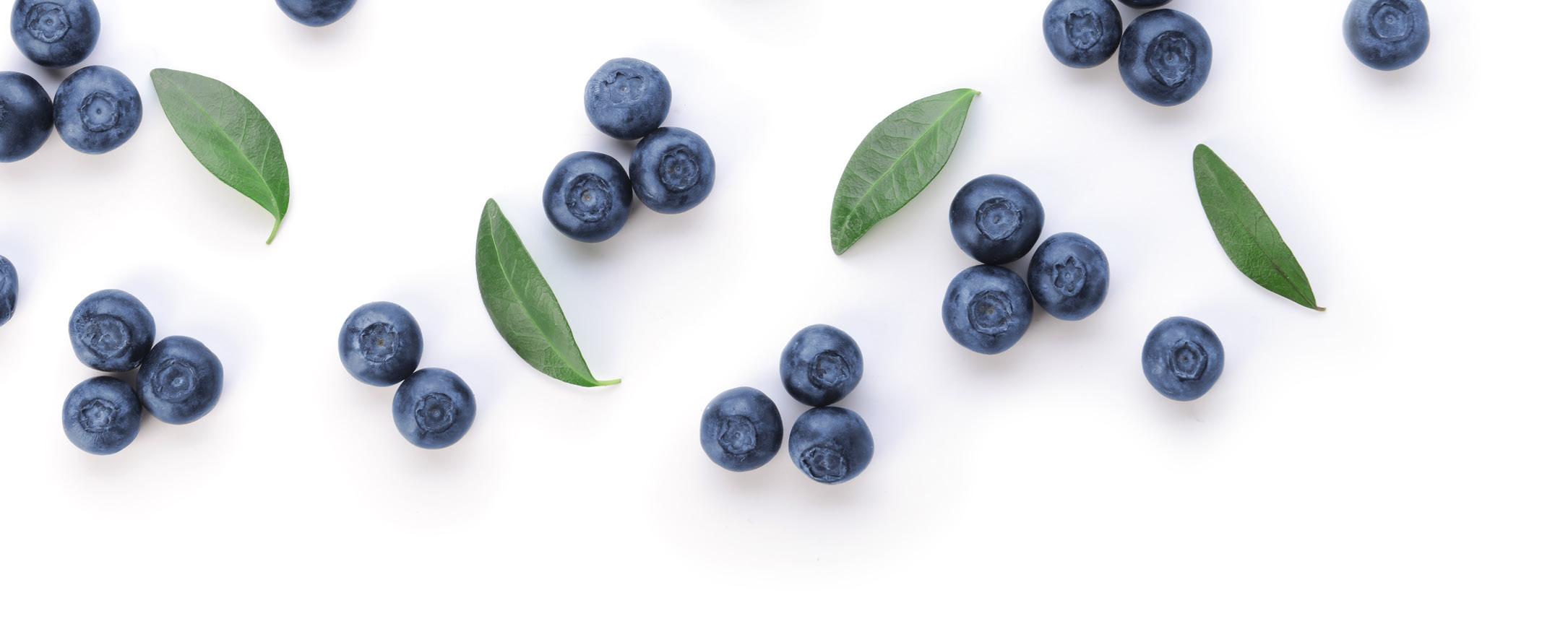
Some simple tips to meet this include:
1. Start the day with a nourishing highfibre breakfast cereal
2. Switch refined white bread to wholegrain bread
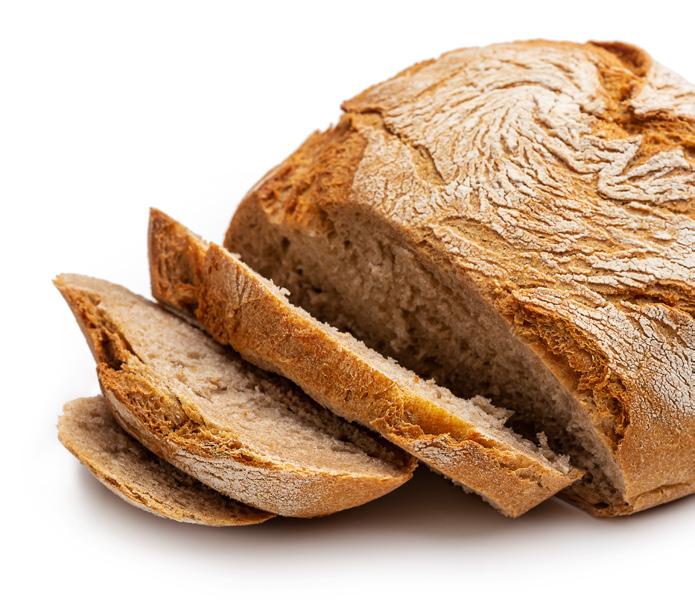
3. Snack on a piece of whole fruit between meals –for example, one juicy orange
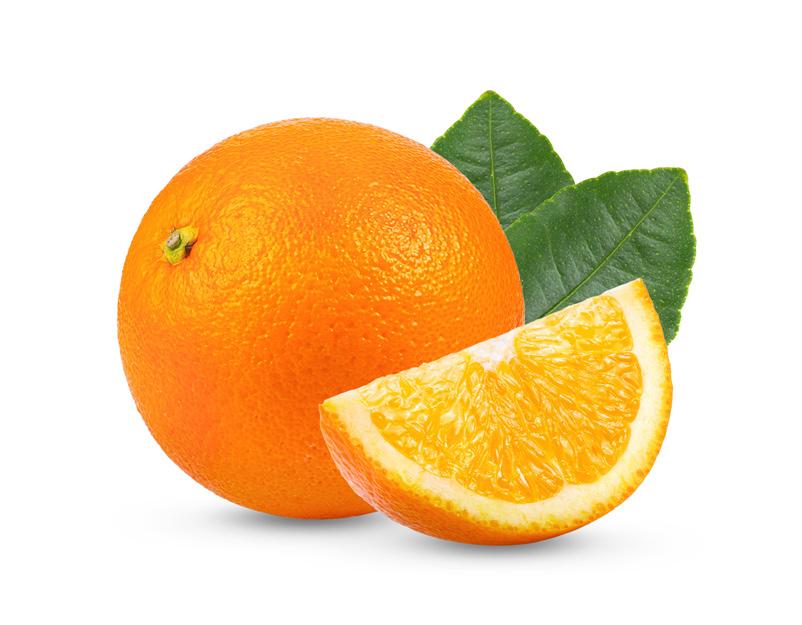
The gut microbiome is a new research hotspot and refers to all of the microorganisms living in the gastrointestinal tract. Research has linked the gut microbiome to influence the balance between a pro and anti-inflammatory state. When an imbalance in gut microbes occurs, also known as dysbiosis, inflammatory diseases are exacerbated.
Have you ever considered testing what kind of gut bugs live in your gastrointestinal tract? Why not consider doing a stool test for personalised, science-based insights and practical recommendations you can action yourself? You can find out more here.
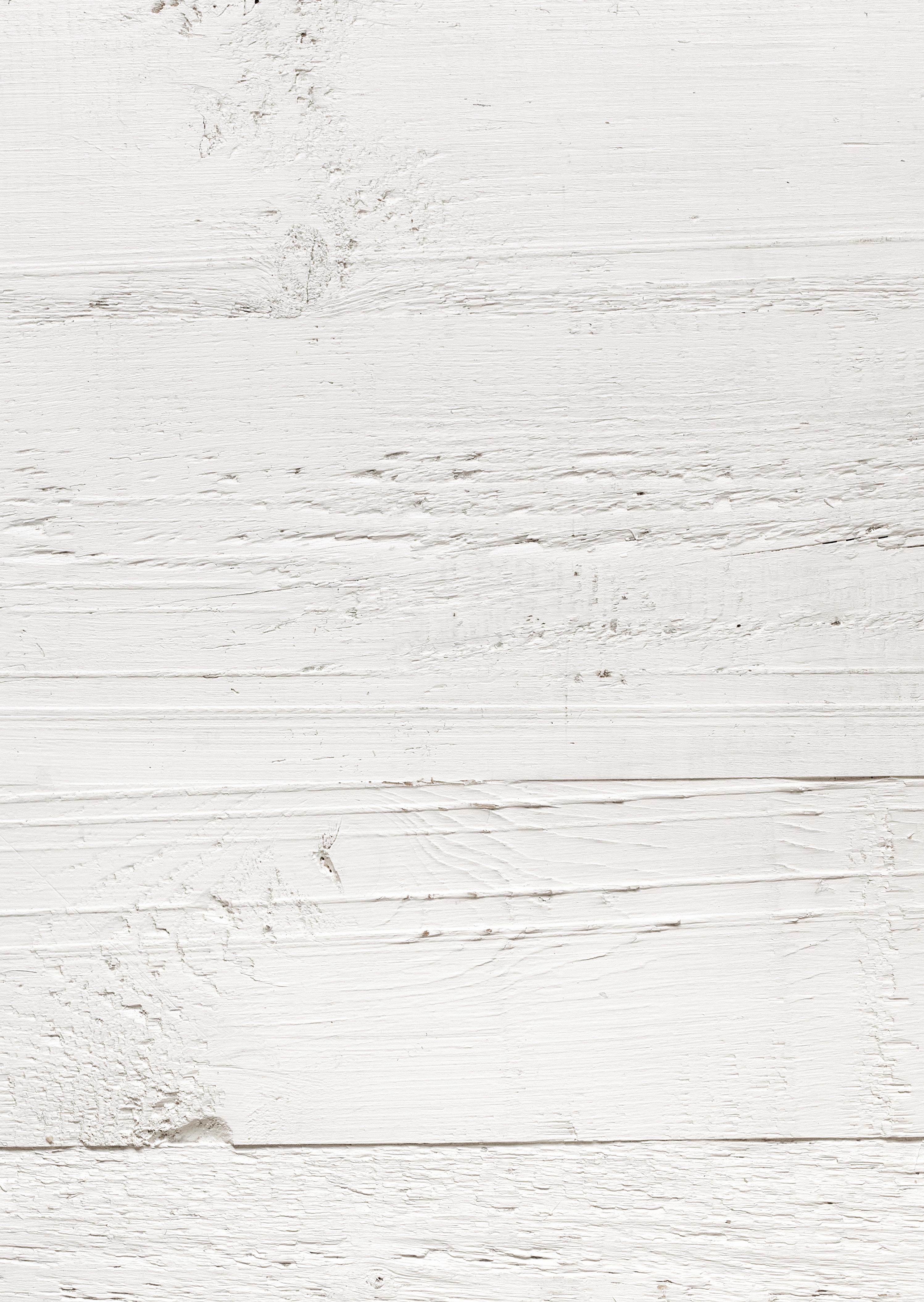
H is for healthful fats
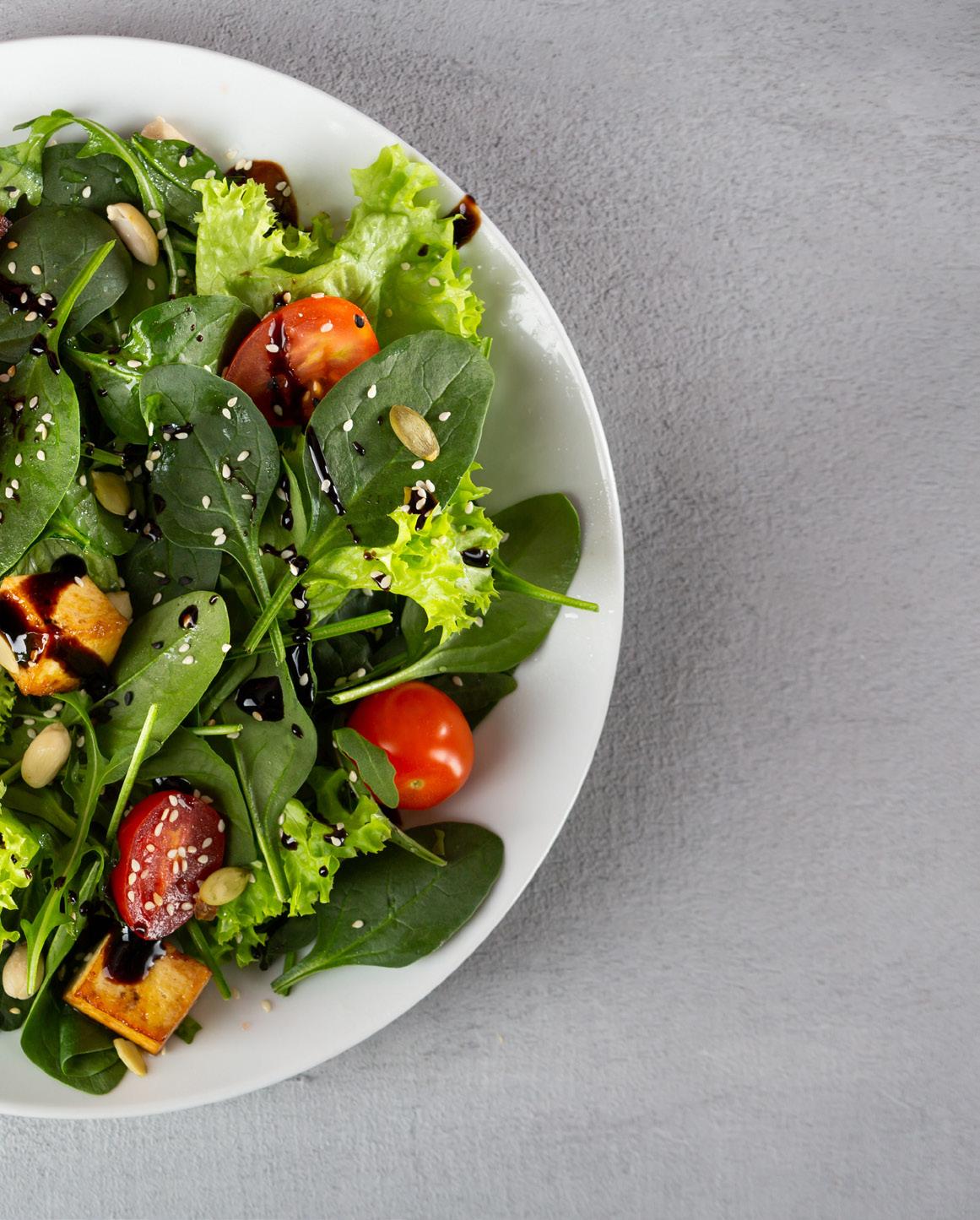
For years, the three-letter word, F-A-T, was deemed the bad guy, and we were urged to remove it from our diets. In fact, that is not entirely true. Our bodies need some fat from food as it is a major source of energy, provides insulation and protection and is actually essential for inflammation. However, to reduce long-term inflammation, some fats are better than others.
Consider extra virgin olive oil (EVOO) as your new kitchen staple. EVOO is a rich source of monounsaturated (good) fat which helps to lower LDL (bad) cholesterol and raise HDL (good) cholesterol levels. It also contains a compound called oleocanthal, which has anti-inflammatory properties. Saturated (bad) fat increases total cholesterol, which may drive underlying inflammatory processes. For that reason, we want to limit foods like red meat to twice a week and perhaps consider switching full cream milk and cheese to the lite alternative.
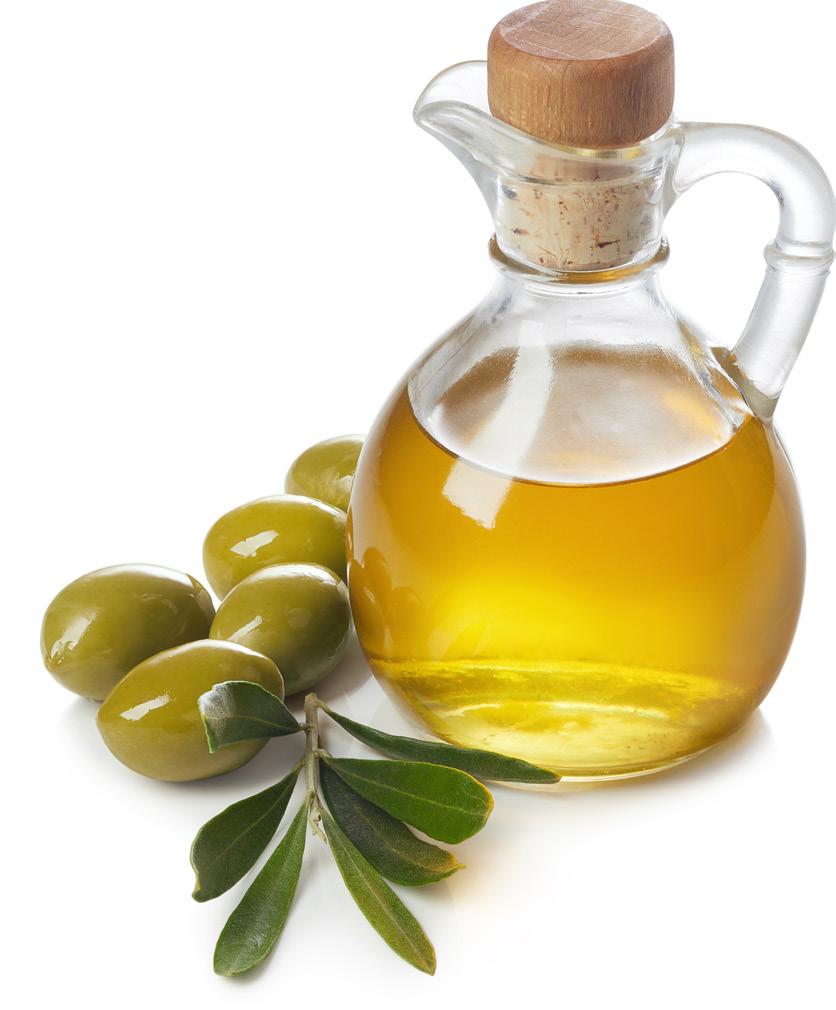
J is for juice
I is for insulin resistance
Insulin resistance, as you would have read earlier in this edition, is a major driver for the underlying inflammatory process. I refer to it, really simply, as systemic (whole-body) inflammation.
Insulin is produced by the pancreas in response to the amount of glucose in the bloodstream. For a steady glucose curve and, therefore, steady production of insulin, the diet tip is
carbohydrates, lean protein, and good fat at every meal not only meets a meal requirement but lowers the glycaemic load of a meal, meaning that the body can process
H I J K
You might think juices are a great source of fruit, vegetables and key nutrients. But actually, they’re particularly low in fibre and jam-packed with added sugar which has, of course, been linked to inflammation.
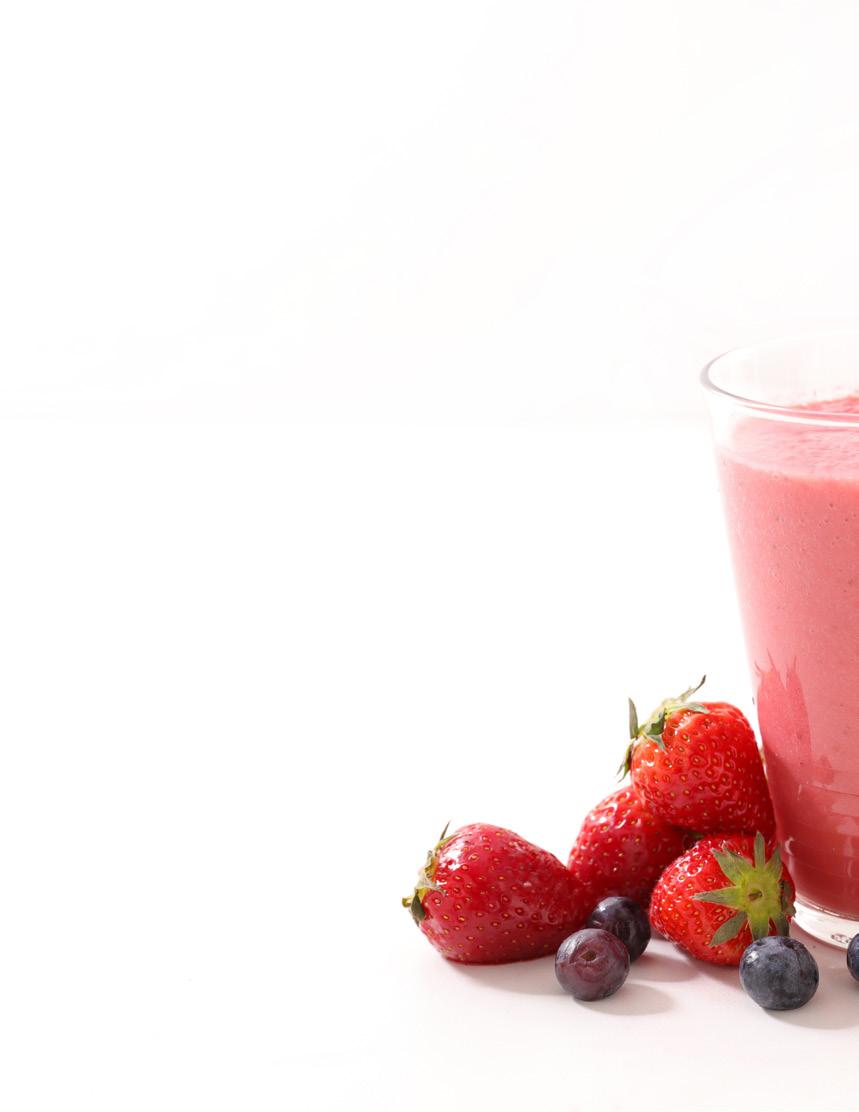

Why not swap a glass of orange juice for a fresh juicy orange or a handful of berries that are loaded with fibre, micronutrients, antioxidants, and polyphenols? Try to adopt the wholefood approach.
K is for kimchi
Kimchi is a nutrient-dense Korean dish made from fermented vegetables and has many health benefits. Kimchi is a helping to feed the good bacteria in the gut microbiome shown to support the immune system and reduce inflammation.
Wondering how you may incorporate Kimchi into your snack on a creamy kimchi dip with 1 slice of crunchy whole or prepare a kimchi slaw and serve it with a chicken parmi!
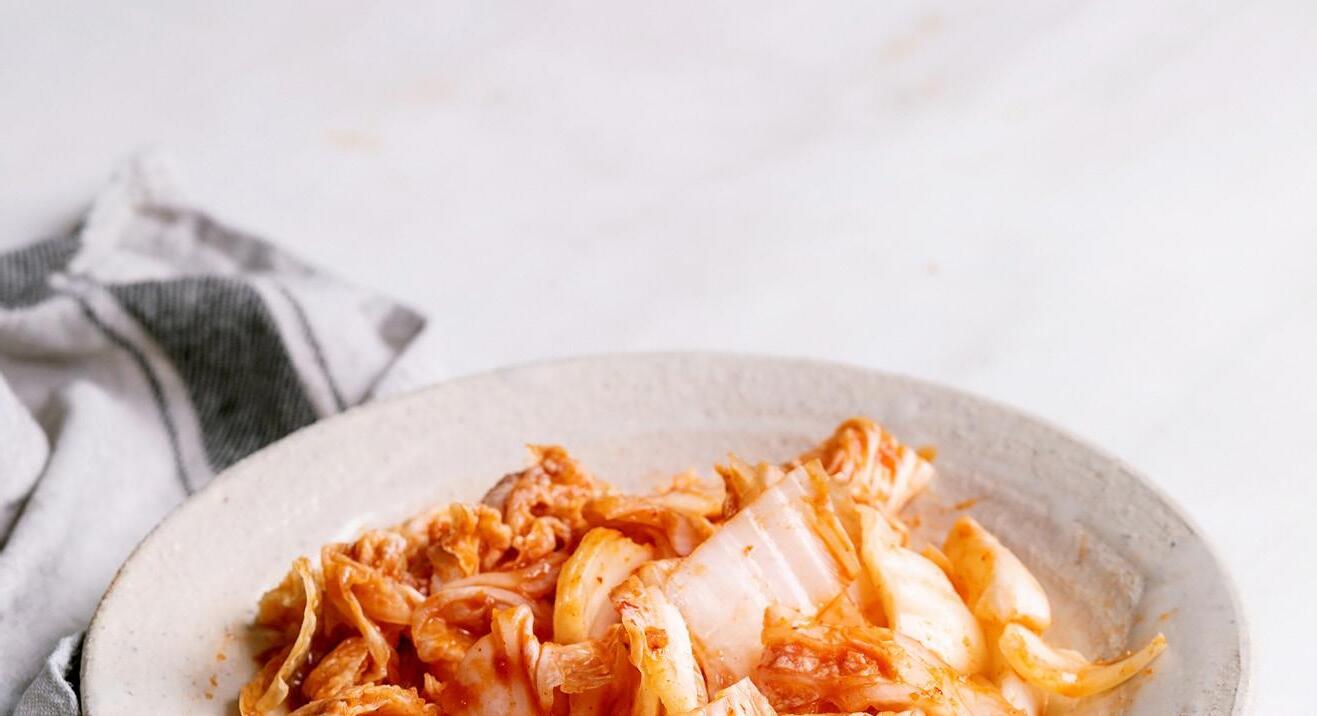
fermented good probiotic, microbiome and has been inflammation.
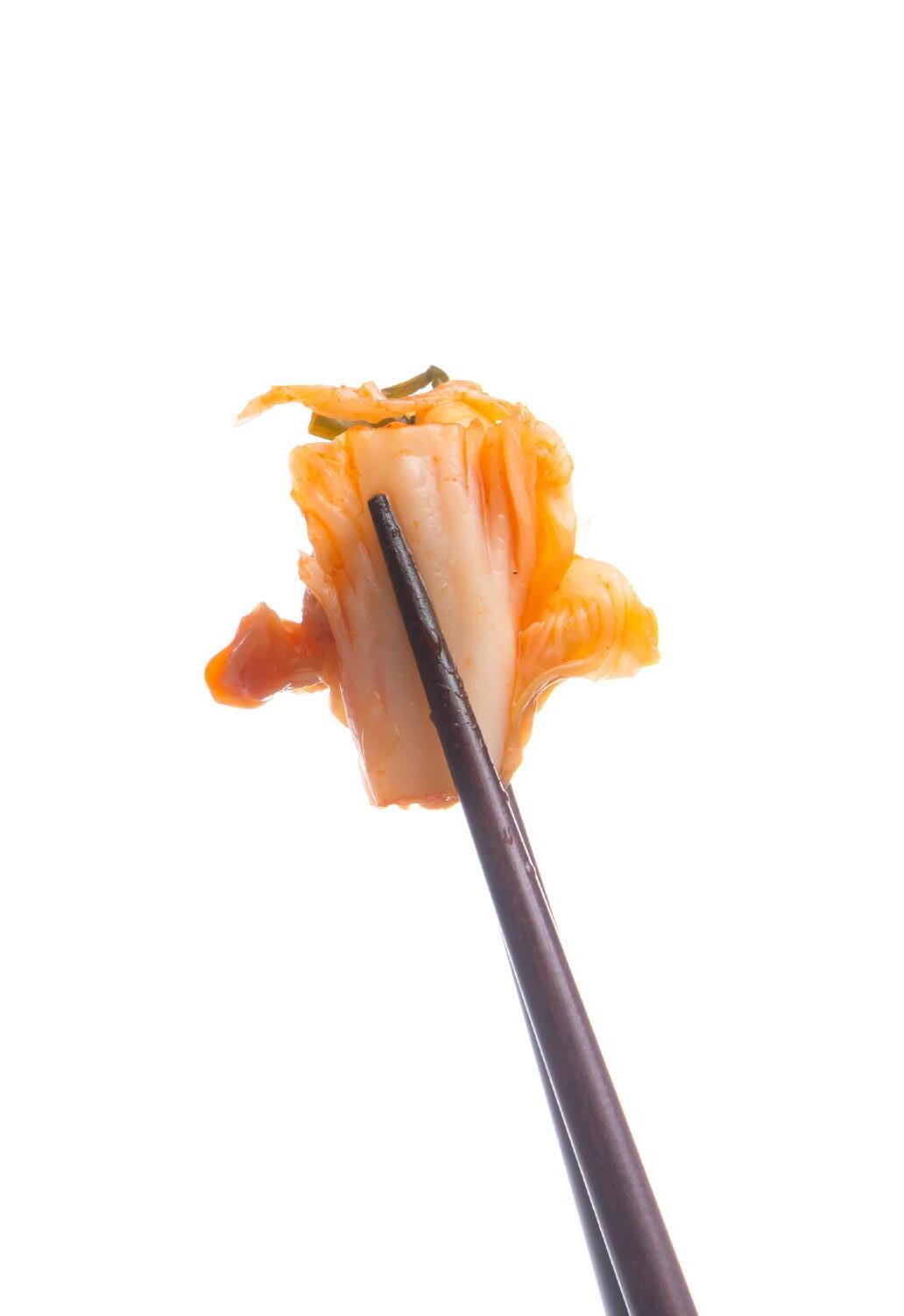

diet? Why not whole grain bread parmi!
L is for lean protein
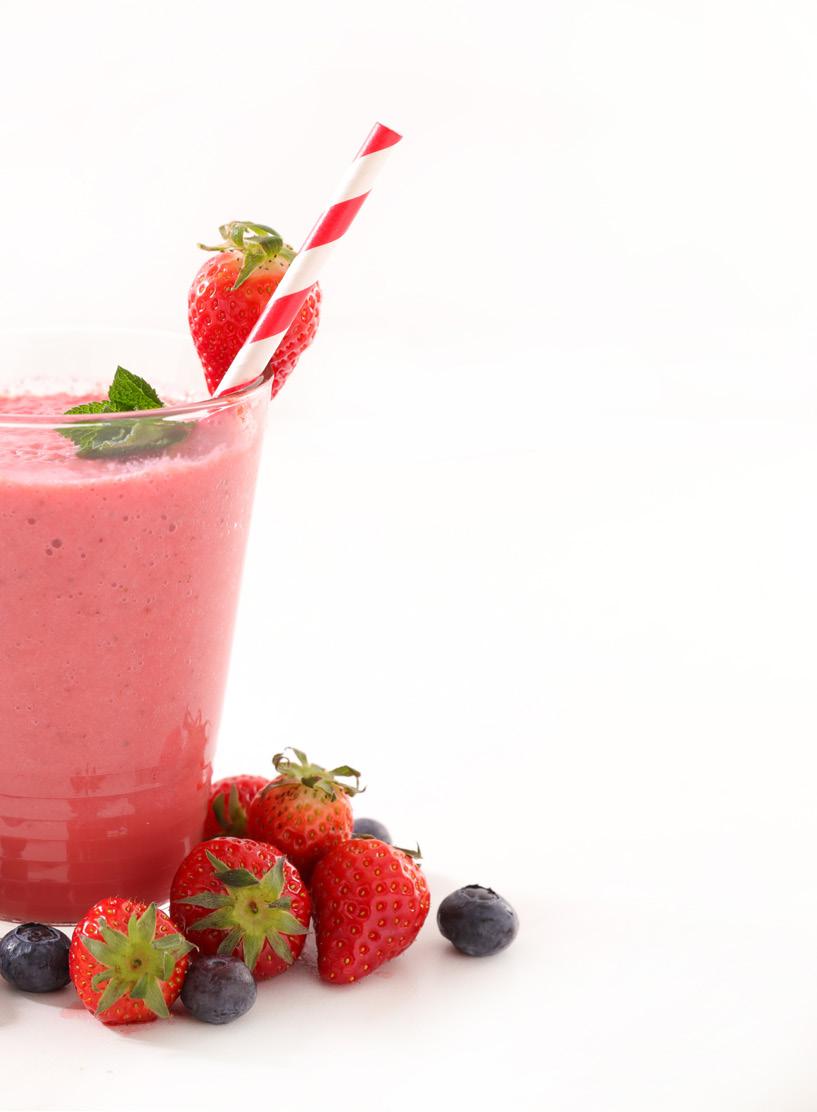
A high-protein diet has been associated with higher concentrations of circulating inflammatory biomarkers. This is because typical protein sources such as red meat, poultry, and dairy have been associated with a pro-inflammatory state. An emphasis on lean or plant-based proteins is recommended for their anti-inflammatory effects. Try reducing red meat to twice a week, choose breast over thigh filets and cut off any visible, solid fat from meat before preparing. You could also try and challenge yourself by incorporating one or two plant-based meals per week, such as beans, tofu, or tempeh.
M is for the Mediterranean diet
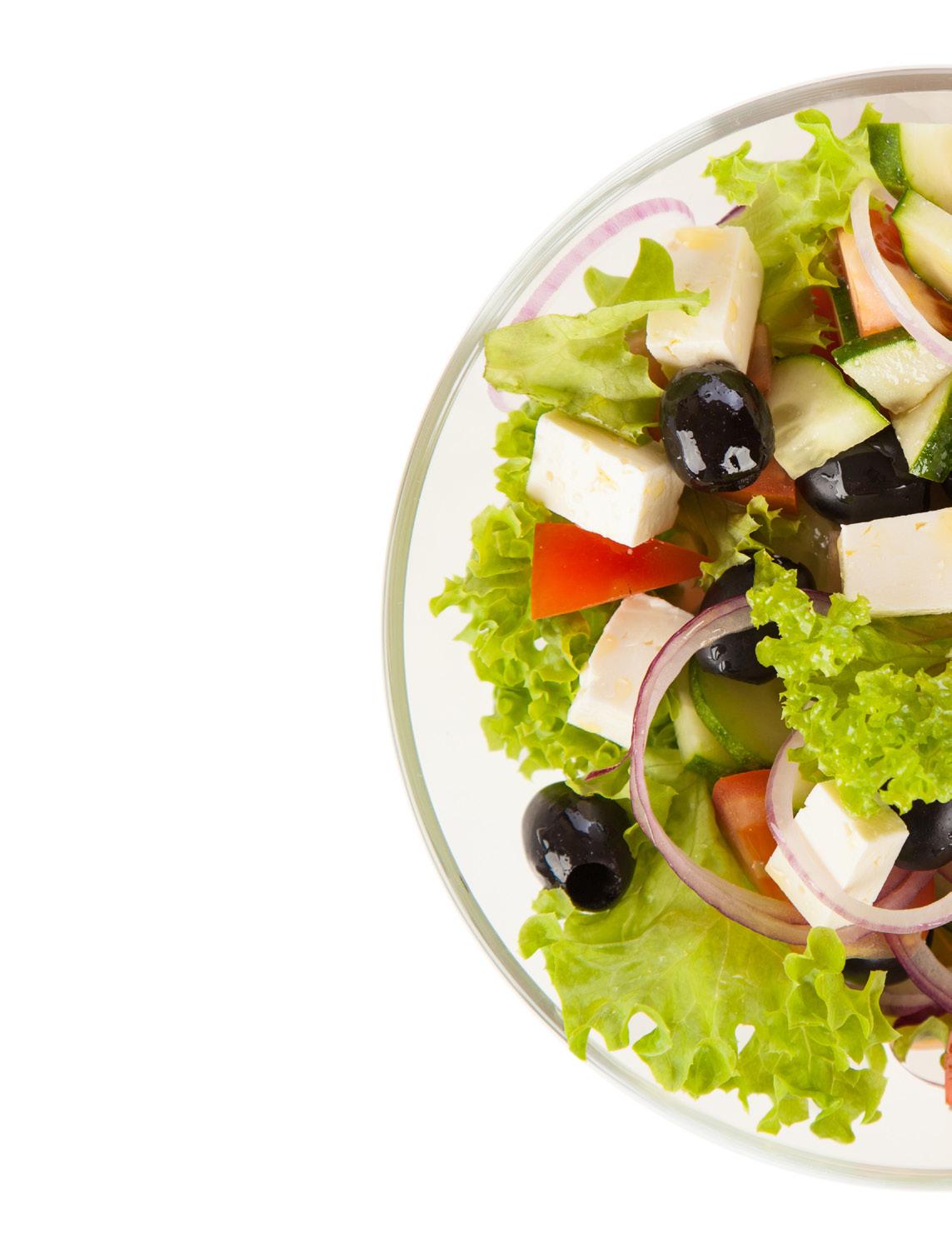
The Mediterranean eating pattern is well known for being rich in antioxidants, vitamins and minerals that have impressive anti-inflammatory properties. The foundation for this healthy diet includes:
Plentiful fruit and vegetables, whole grains, nuts, and legumes that are minimally processed.
Extra virgin olive oil as the main source of dietary fat.
Fish, poultry, cheese, and yoghurt are consumed daily. Red meat is consumed in very small amounts.
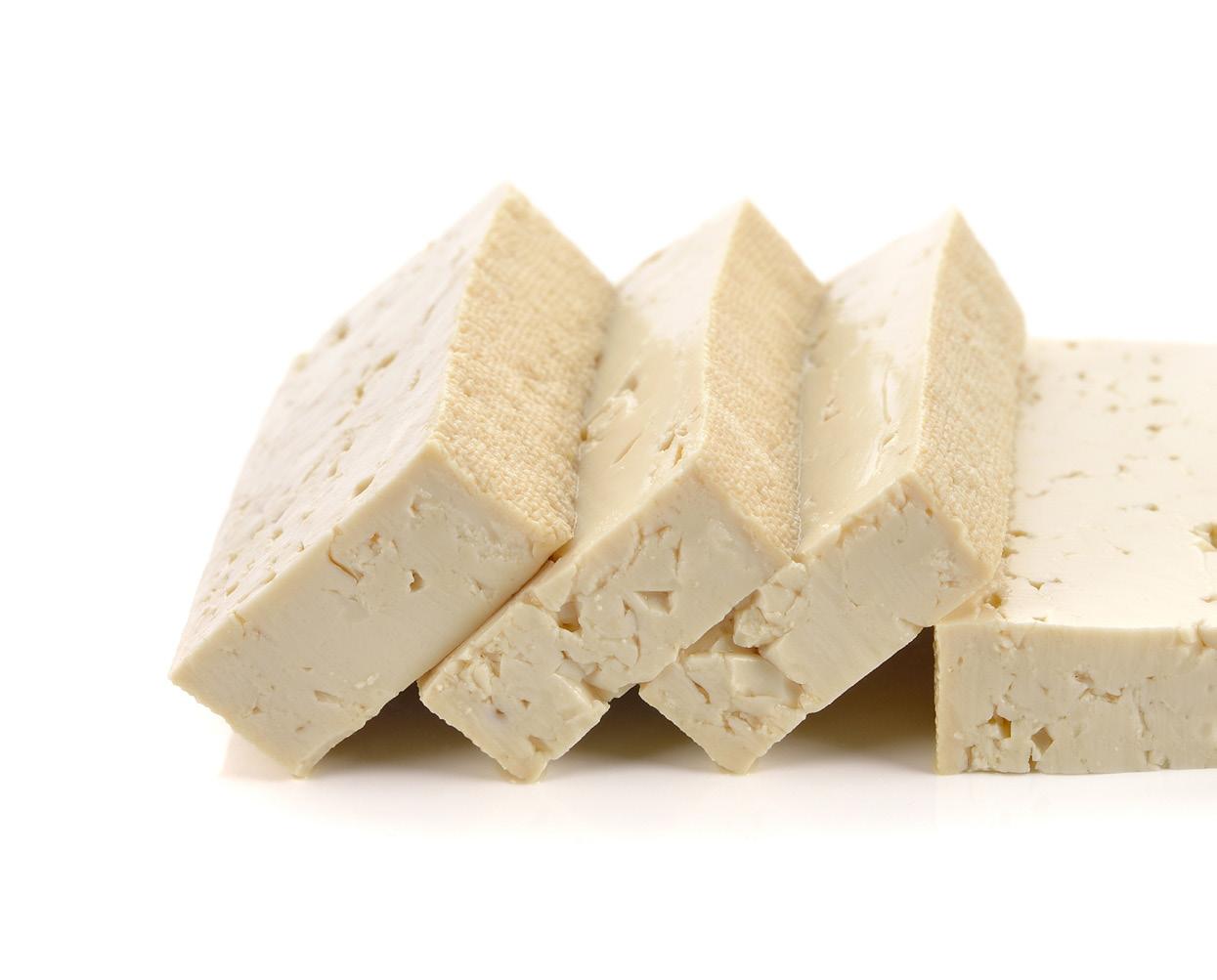
Limited sweets with added sugar and wine consumed in small amounts. Here are two small changes that may bring you one step closer to the
1. Consume a handful of raw nuts every day.
L M N
2. Begin each main meal with a crispy salad of leafy greens and seasonal veg.
N is for nuts
Aim to consume 30g of nuts per day to reduce your risk of cardiovascular disease by up to 21%. This may look like 20 almonds, 15 cashews, 40 peanuts, 10 walnuts or 4 chestnuts as a
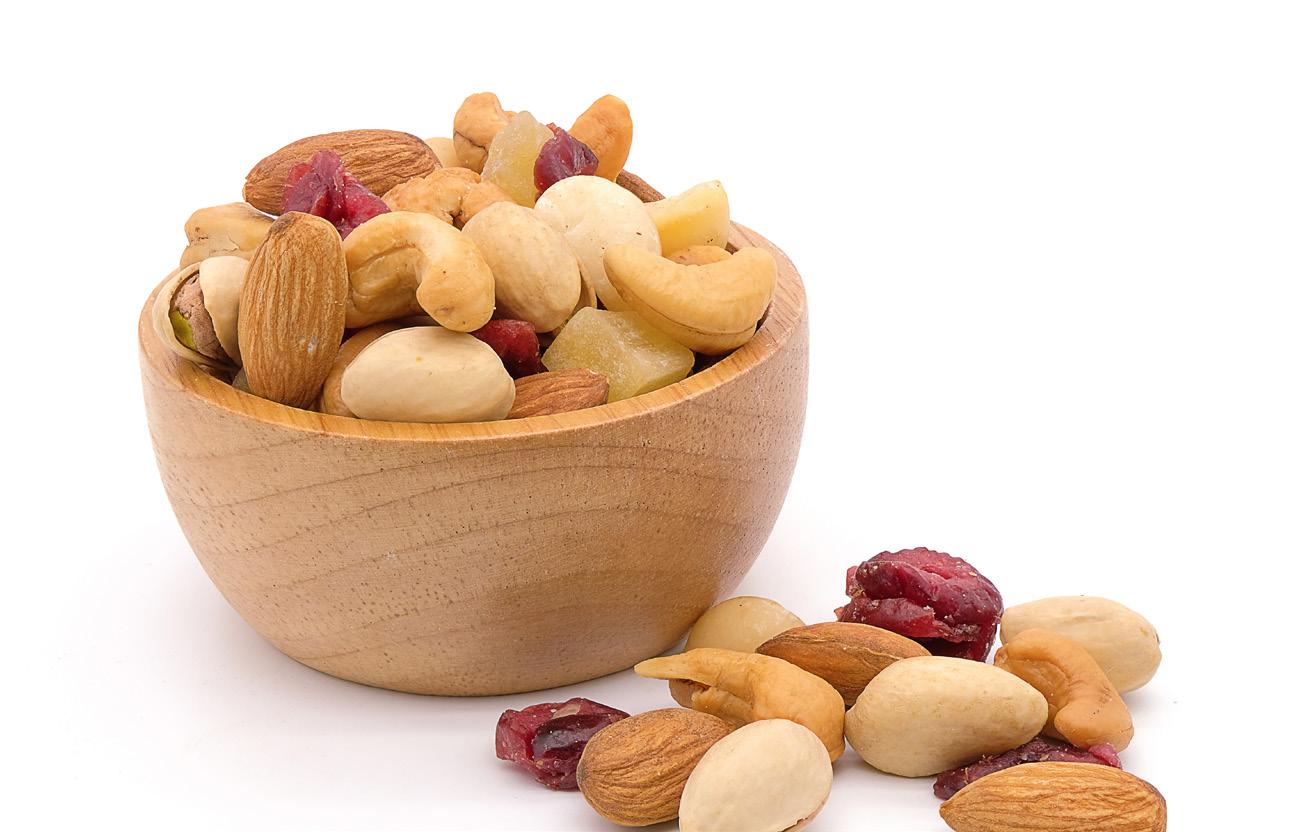
O is for omega fatty acids
A healthy diet will contain a balance of omega-3 and omega-6 fatty acids, which you may have read up on already from issue #1 of beingMAN. Researchers believe that omega-6 fatty acids are associated with a proinflammatory state, including obesity and high cholesterol and have even been found to promote the growth of cancerous cells in the prostate.
Omega-6 food sources come from vegetable oils such as sunflower sesame and corn oil, meat, poultry, fish, and eggs.
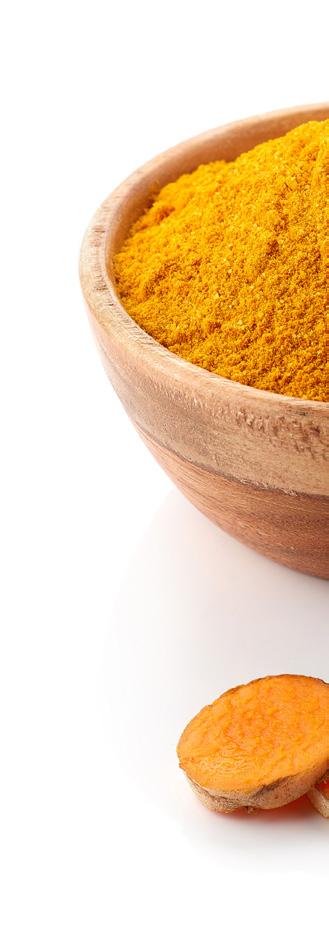
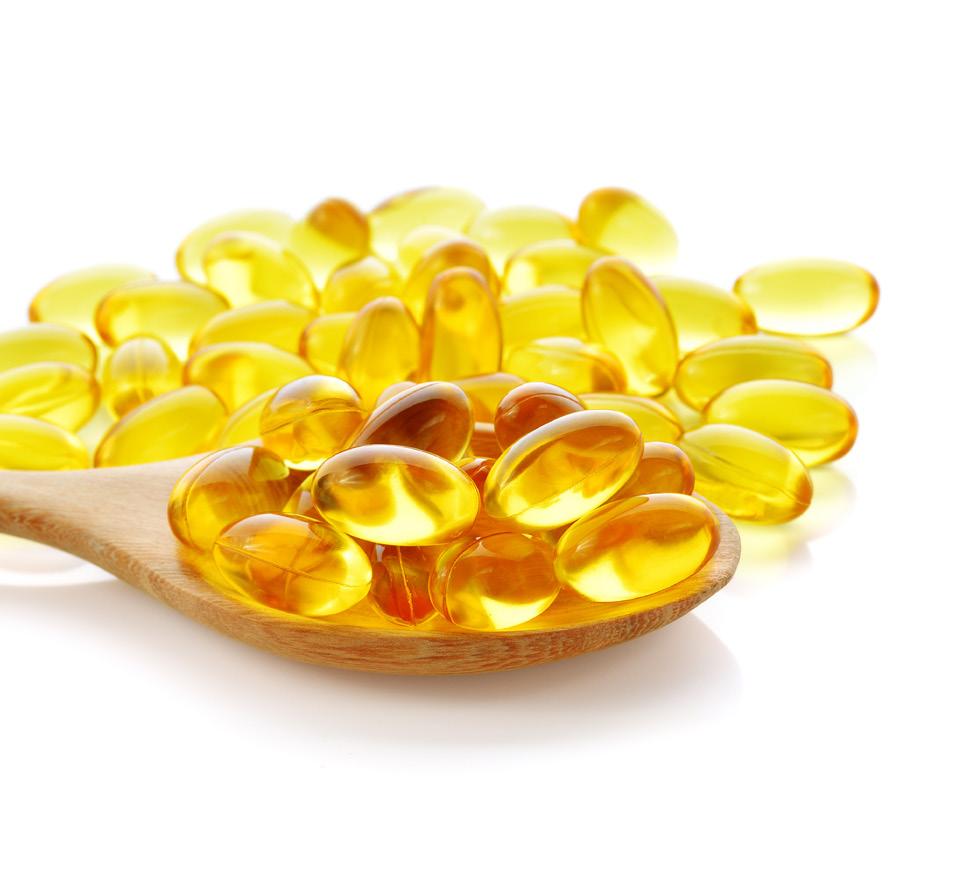
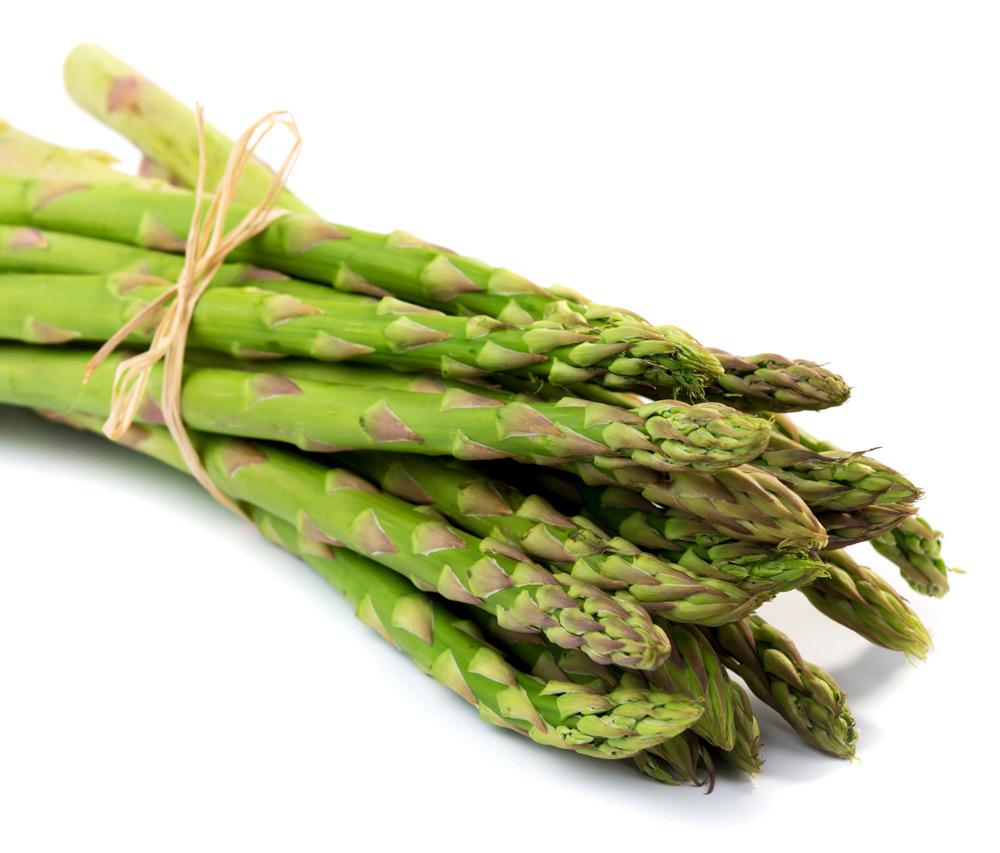
Omega-3, on the other hand, is also naturally found in food or supplement products but has been found to have a protective effect against chronic conditions such as heart disease, eczema and even rheumatoid arthritis. Omega-3 food sources come from oily fish such as salmon, mackerel, tuna, and sardines, nuts and seeds and plant-based oils.
To optimise your omega-3:omega-6 ratio, aim for one serving of oily fish twice a week and limit consumption of processed foods, as most manufacturers use vegetable oils to mass produce.
Q is for quenching thirst
P is for polyphenols
Did you know that there are over 8,000 different types of polyphenols? You may have heard of some of these before… flavonoids, phenolic acids or lignans. Polyphenols are a micronutrient found in many plantbased foods, and a large review of the evidence found a diet rich in polyphenols may be protective against chronic health conditions.
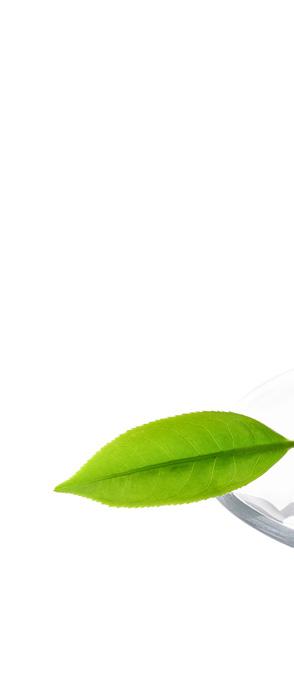
Polyphenols are antioxidants, antiinflammatory, neuro-protective, and good for heart health and insulin
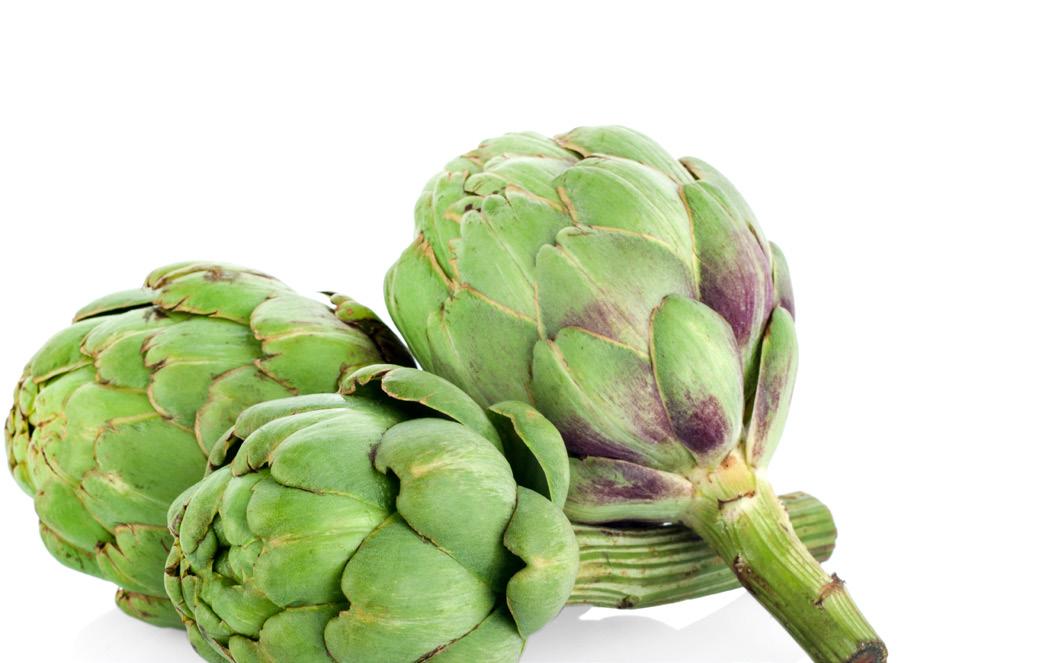
When it comes to antiinflammatory food tips, we often forget about how important proper hydration really is. Drinking enough water not only assists with regulating body temperature but also in preventing infections and keeping joints lubricated. Adequate hydration is important for quality sleep, good mood and managing inflammation by flushing out toxins from our body. Everyone needs at least 6 cups of water (at an absolute minimum) to keep hydrated. Why not try flavouring water with some fresh cucumber and mint or watermelon cubes to make it fun and exciting? Or fizz it up and make it into a glass of soda water.
A simple way of calculating your fluid requirements is to multiply your weight by 30–35 mL of water. For example, someone who is 80kg needs somewhere between 2,400–2,800 mL of water a day. Now it’s your turn!
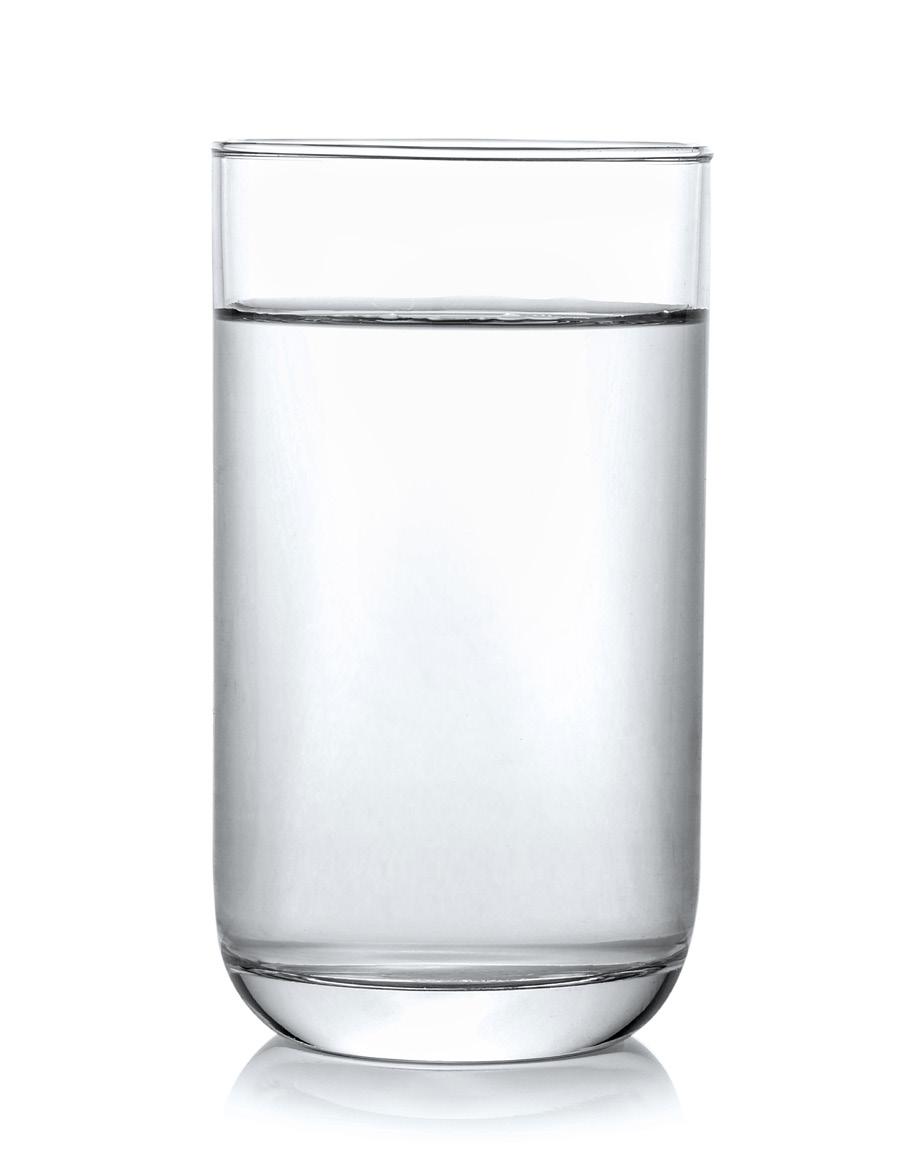

R S U
R is for regular eating
As a rule of thumb, aim to eat at least every 3–4 hours and avoid any longer gaps. This has got to do with the glucose curve and how long it takes for your glucose to peak and begin to return to baseline again. Prolonging this gap will leave you in a fasted state which has been shown to exacerbate insulin resistance (aka systemic inflammation).
S is for spices
Turmeric is a 4,000-year-old golden spice, and beyond its flavour in Indian curries, it is still the market leader in natural health trends. Turmeric has many health benefits, is rich in polyphenols and is known to block metabolic pathways that lead to underlying inflammation. It has been used for centuries as a medicinal herb in Chinese medicine and can be consumed via food or supplementation.
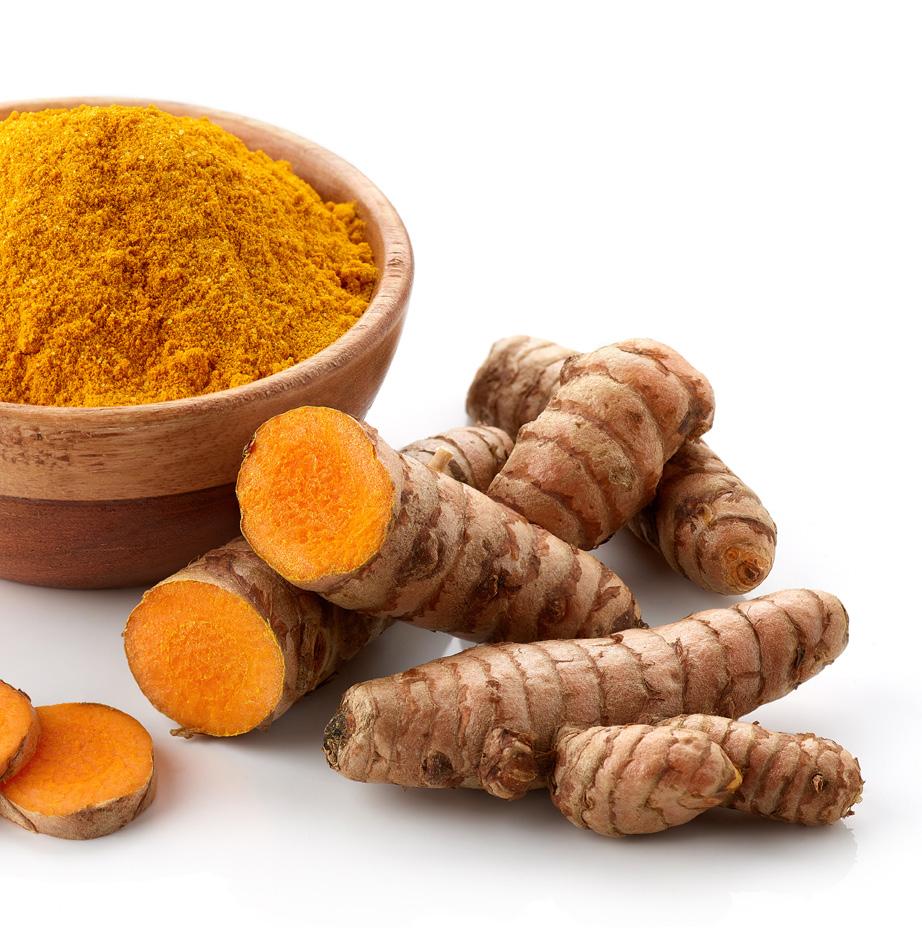
Why not try a turmeric tea by pouring 1 cup of boiling water over 1 tsp ground turmeric and ground ginger? Or make it into a creamy latte by adding a dash of milk of your choice.
TT is for tea
As above, tea has been long used in traditional Chinese medicines to also help decrease inflammatory factors associated with chronic disease. Ginger, turmeric, chamomile, and green tea are among the most popular.
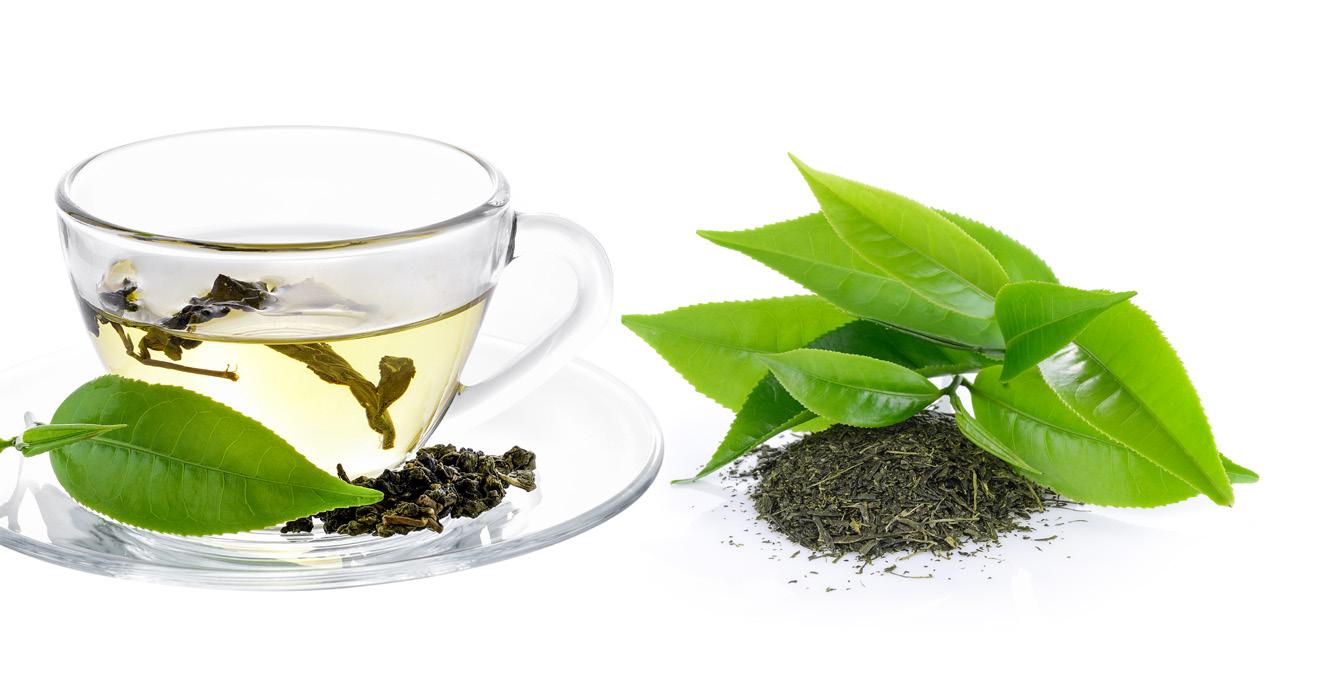

Not a hot tea person? Why not serve cold over a glass of ice and make it into an iced tea?
U is for ultra-processed
Ultra-processed and processed foods or ‘junk’ food are those that are typically lower in fibre and micronutrients and are higher in salt, sugar, and fat. It’s no secret that eating these foods is harmful to our health. The Australian Dietary Guidelines recommend that we reduce our intake of processed foods to “only sometimes and small amounts.” How? You might be wondering.
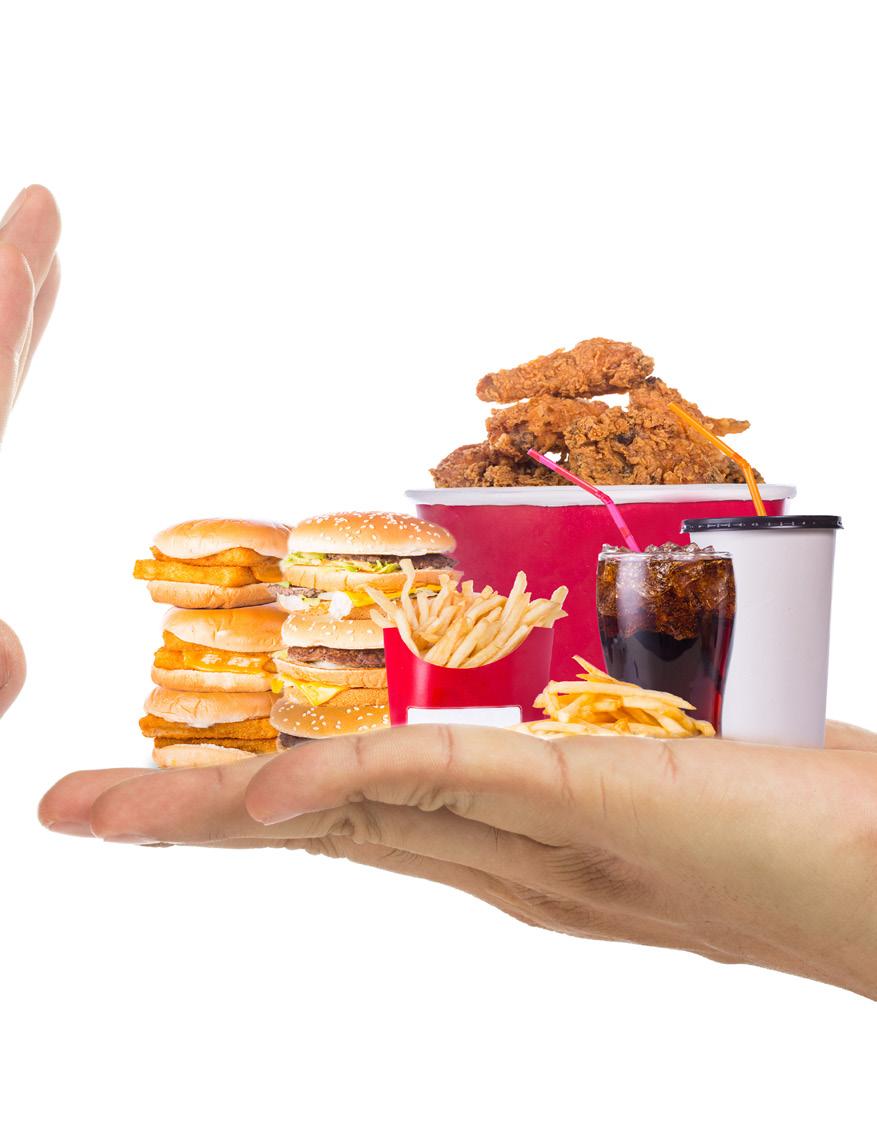
1. Try shopping for groceries online to reduce the temptation of buying processed foods.
2. Prepare for the week ahead by organising a weekly menu and shopping list. Need more help? We’ve got you sorted. Keep your eyes peeled for our 90-day diet program launching through Saving Brothers soon.
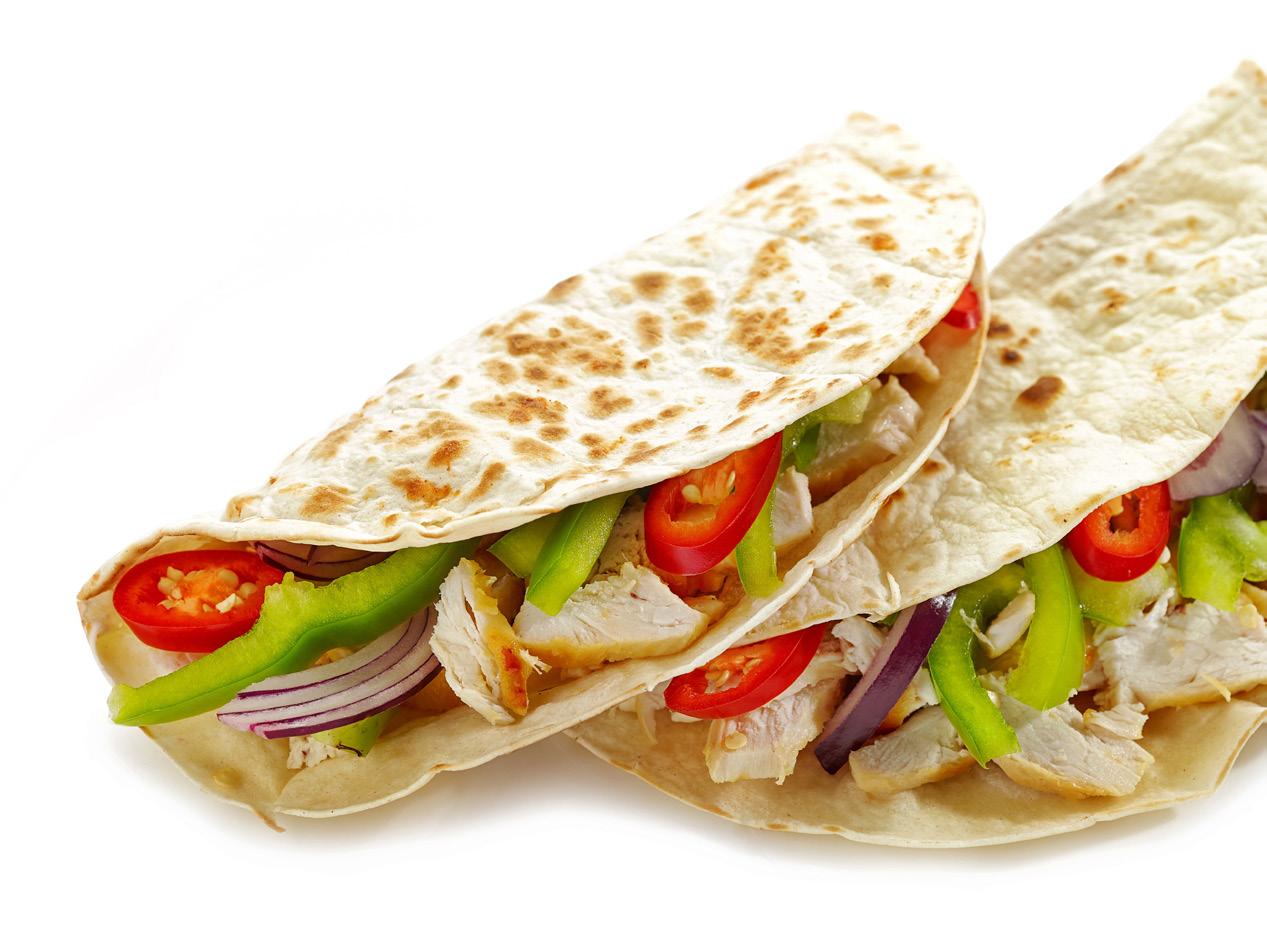
V W X
V is for vitamin C
Vitamin C is a water-soluble vitamin and natural antioxidant that can be found in a variety of fresh foods such as oranges, lemon, kiwifruit, broccoli, cauliflower, and cabbage. Researchers from Malaysia actually found supplemental vitamin C to potentially lower circulating inflammation in people with comorbidities such as being overweight and/or diabetes.
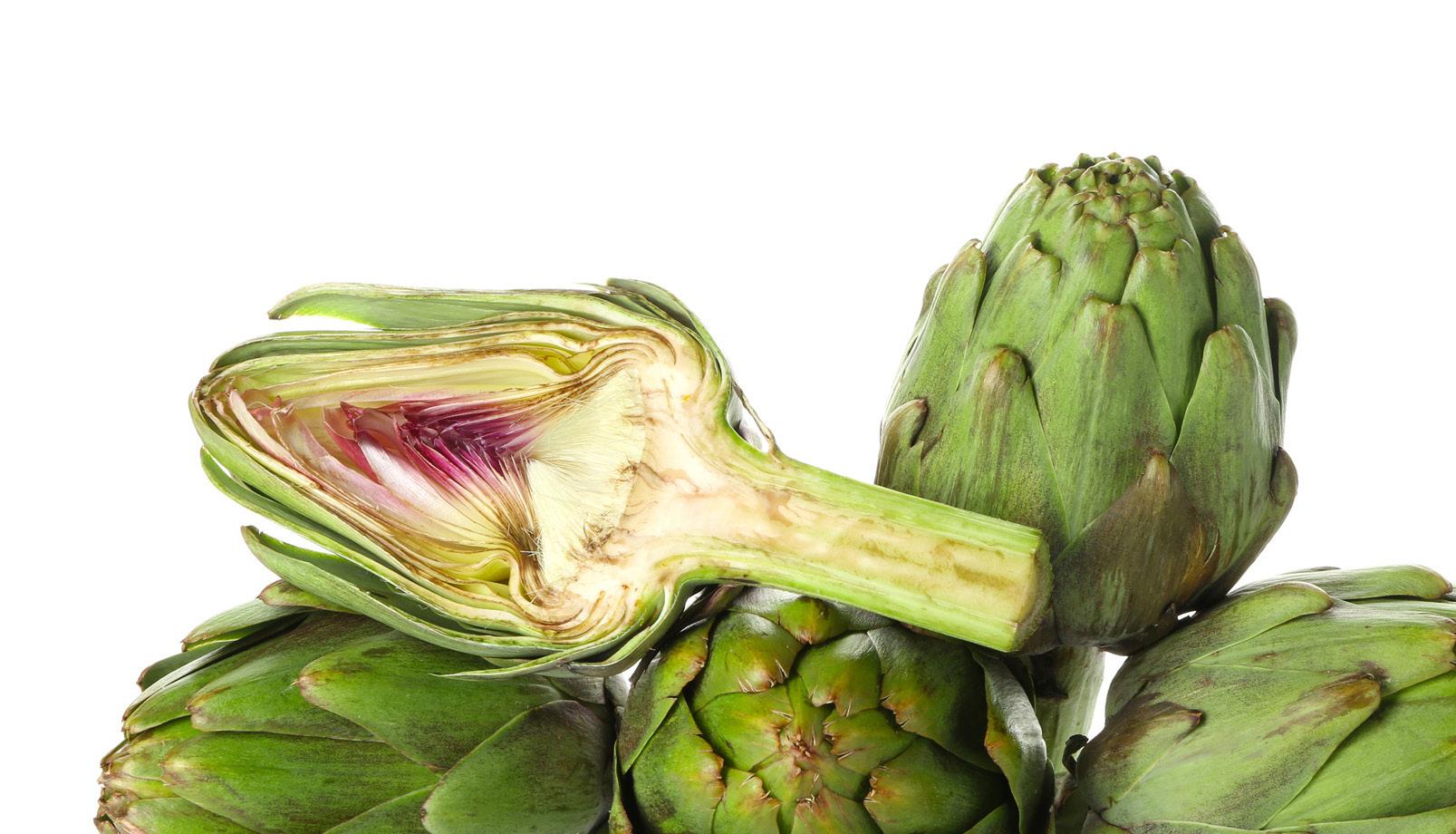

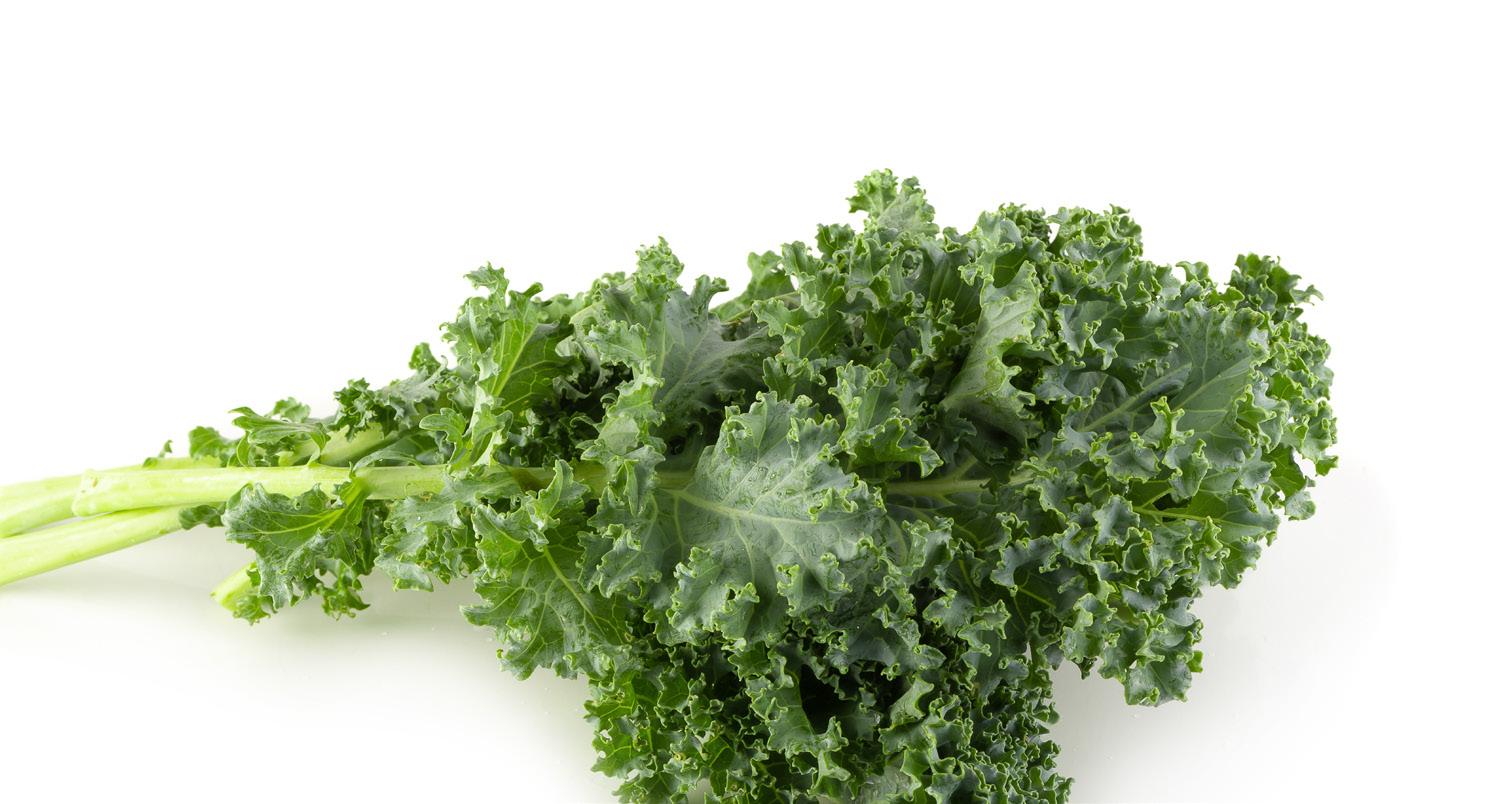
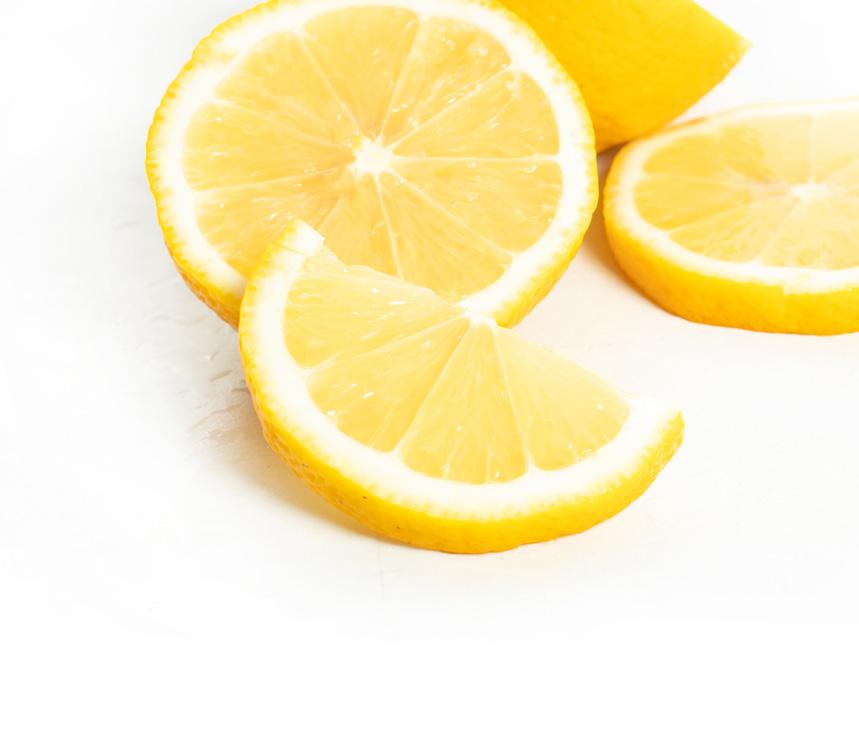
Vitamin C has other benefits too. It has been long found to help shorten the duration of the common cold and has often been referred to as an ‘immune booster.’ Try this vitamin C-packed breakfast smoothie for all its benefits:
Blend 1 kiwi fruit, ½ medium banana, 1 cup fresh or frozen berries, 1 tsp ground ginger, 1 tsp honey, ¾ cup milk of your choice and 1 scoop of unflavoured protein powder.
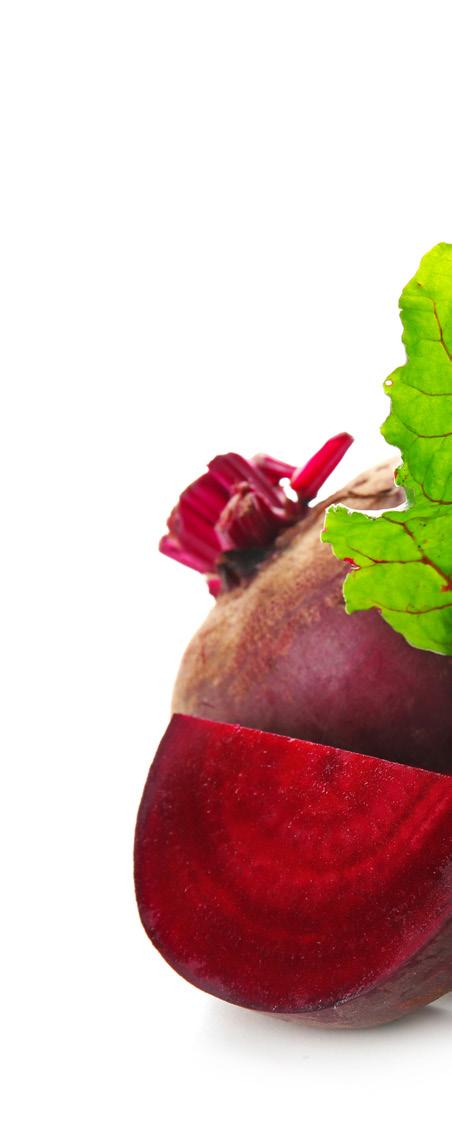
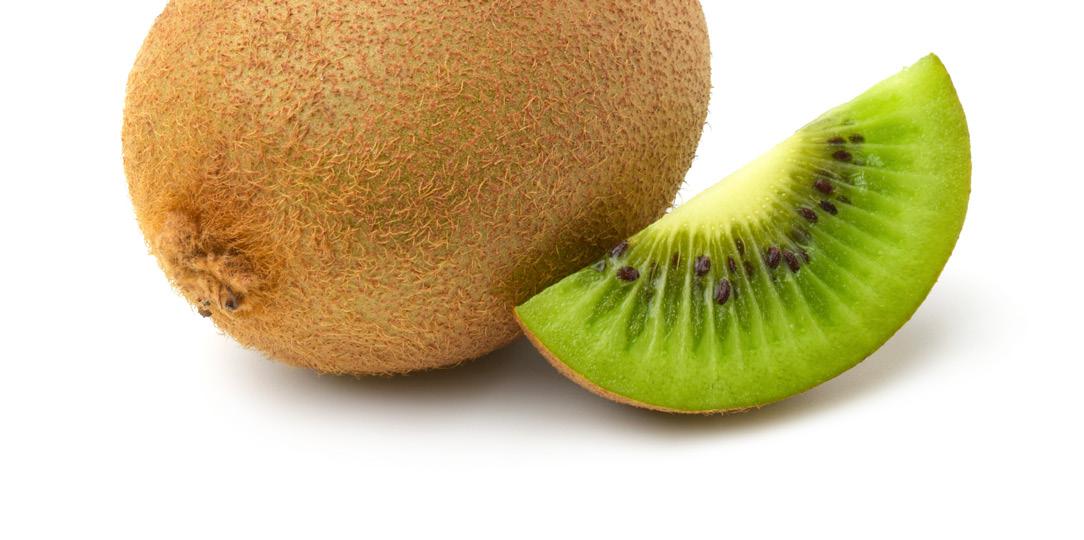
W is for whole grains
Whole-grain intake has been related to lower levels of circulating inflammatory biomarkers. This refers to grains where the gran, germ, and endosperm are intact.
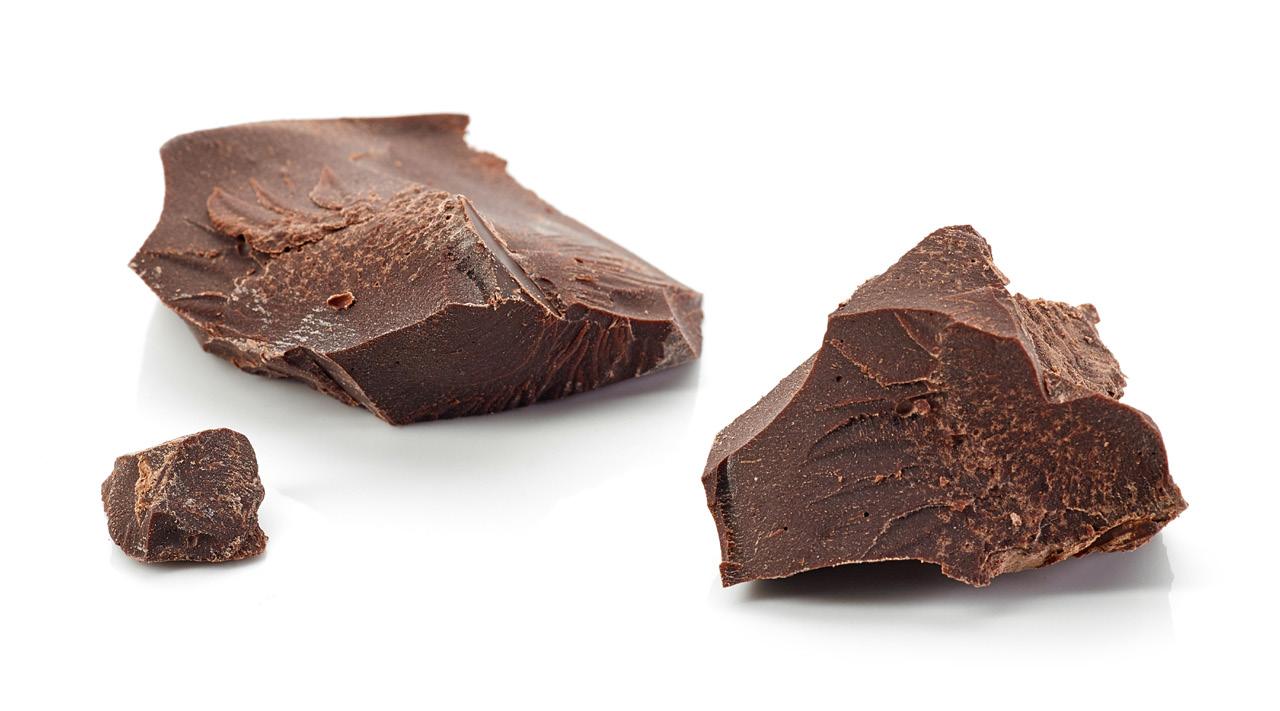
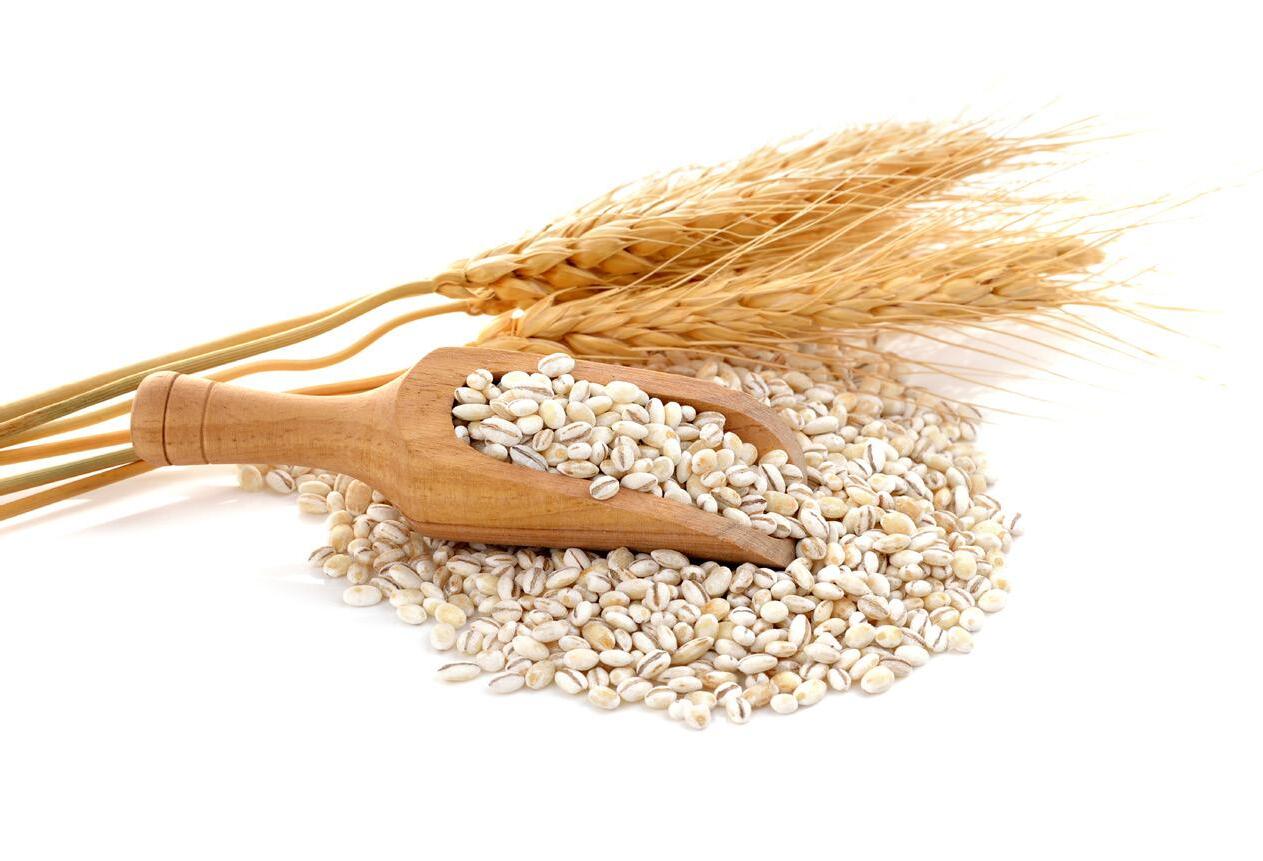
A simple switch to ensure you’re getting your daily intake of whole-grain is to choose bread labelled as whole grain or biscuits such as 9-grain Vita-Weets.

X is eXtremely hard to write a tip for… but remember those antioXidants!!
Y Z

Yoghurt
Yoghurt (specifically the dairy kind) has many impressive health benefits that will leave you wanting to consume it more. Yoghurt is jam-packed with protein, B-group vitamins, calcium and probiotics, which are known to reduce inflammation. If you feel overwhelmed by the many different choices of yoghurt in the supermarket, you are not alone. Here are our tips to make the choice a whole lot easier.
The best choice of yoghurt is one that is ‘low’ in sugar or has ‘no added sugar.’ Aim for less than 12g of sugar per 100g of yoghurt, which you will find on the nutrition information panel.
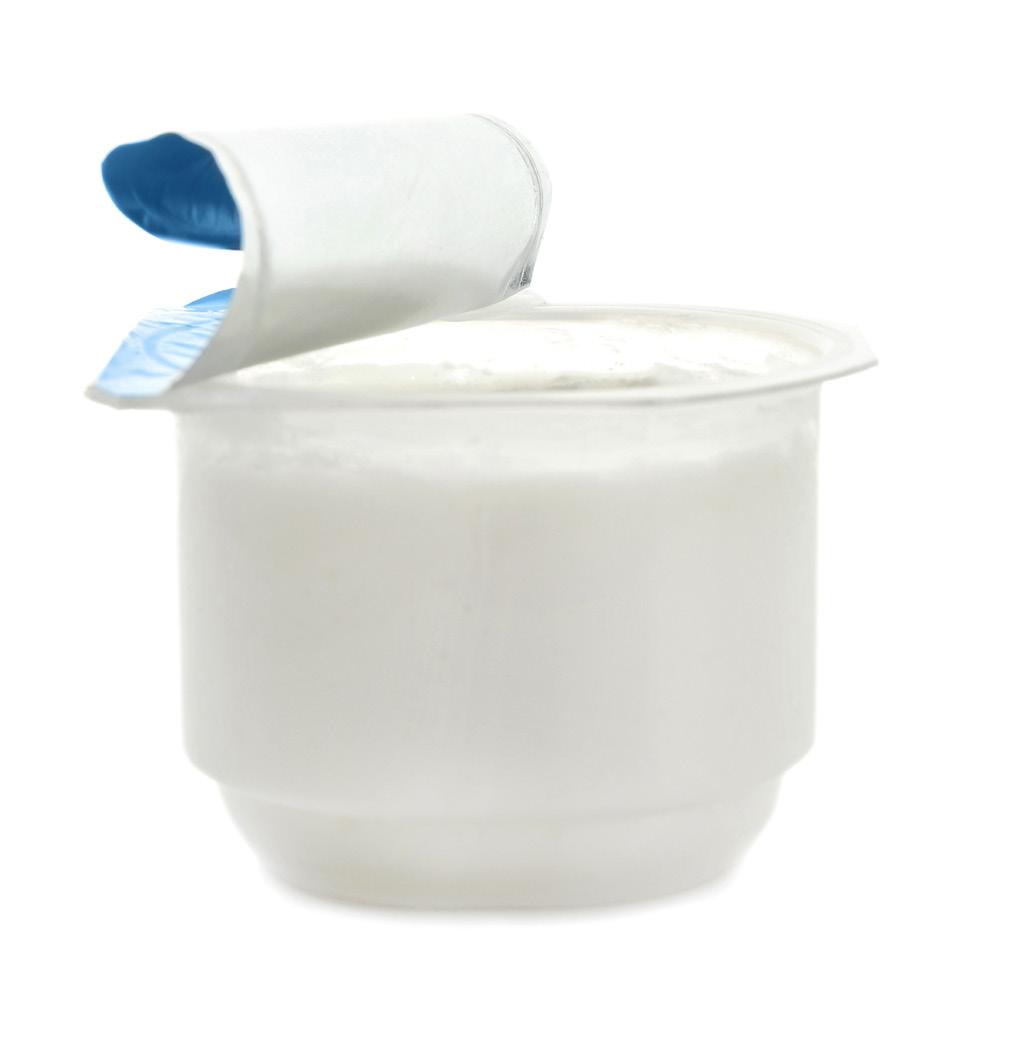
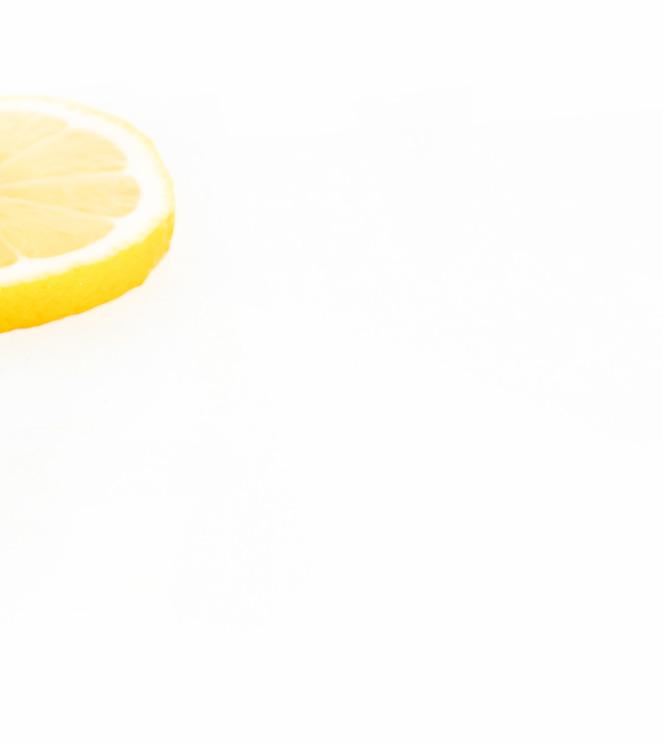

Also, look at the labelling for claims such as ‘good source of calcium’ or ‘contains live cultures’ to ensure you’re getting all the health benefits of yoghurt in one.
Z is for if you have zero time
As we come to the end, for those of you reading that are working full time, are night-shifters, have young children or are single parents, you might be thinking that some of these ideas are timeconsuming, which adds a lot of burden! Well, we are not here to create stress (because that, too, is pro-inflammatory!). We are here to take it away.
Why not try a ready-made, pre-packaged meal replacement? An option that you can purchase in bulk and freezer stores to take away the burden of grocery shopping and preparing meals yourself. Pair with a fresh packet salad, so you’re still eating that rainbow of colours. For personalised advice on the healthiest meal replacement for you and your tailored requirements, reach out to one of our Accredited Practising Dietitians.
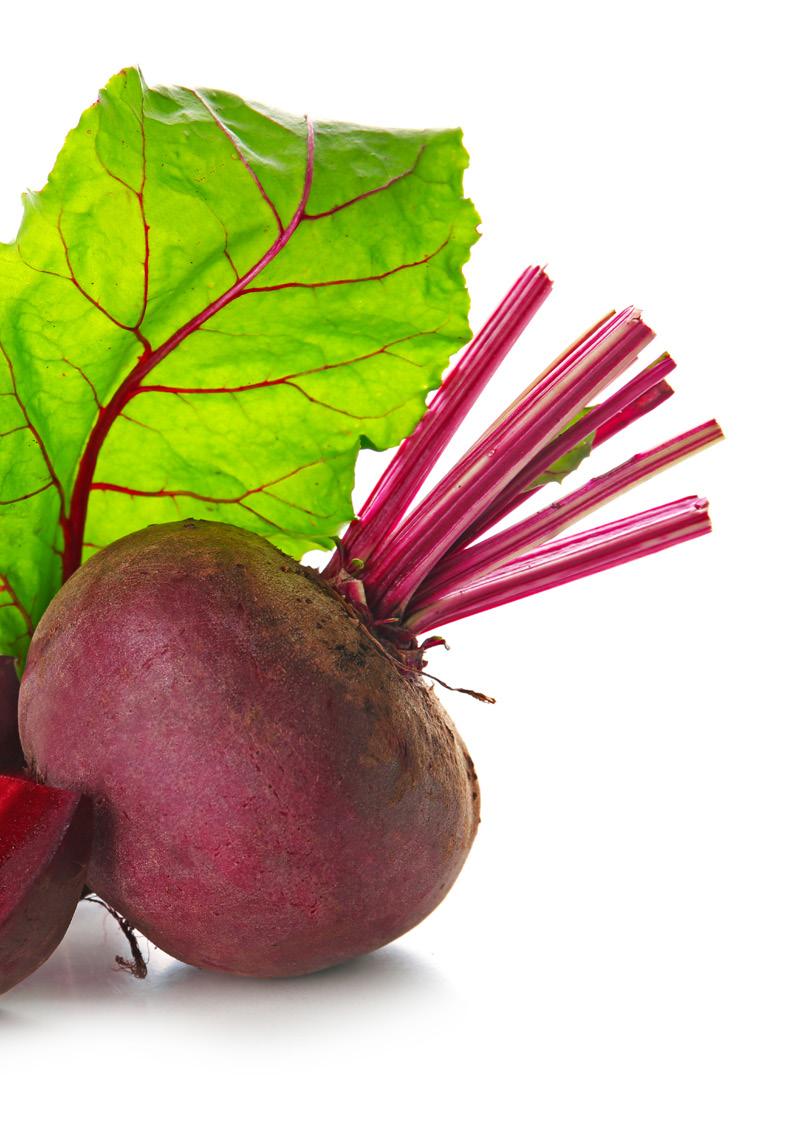
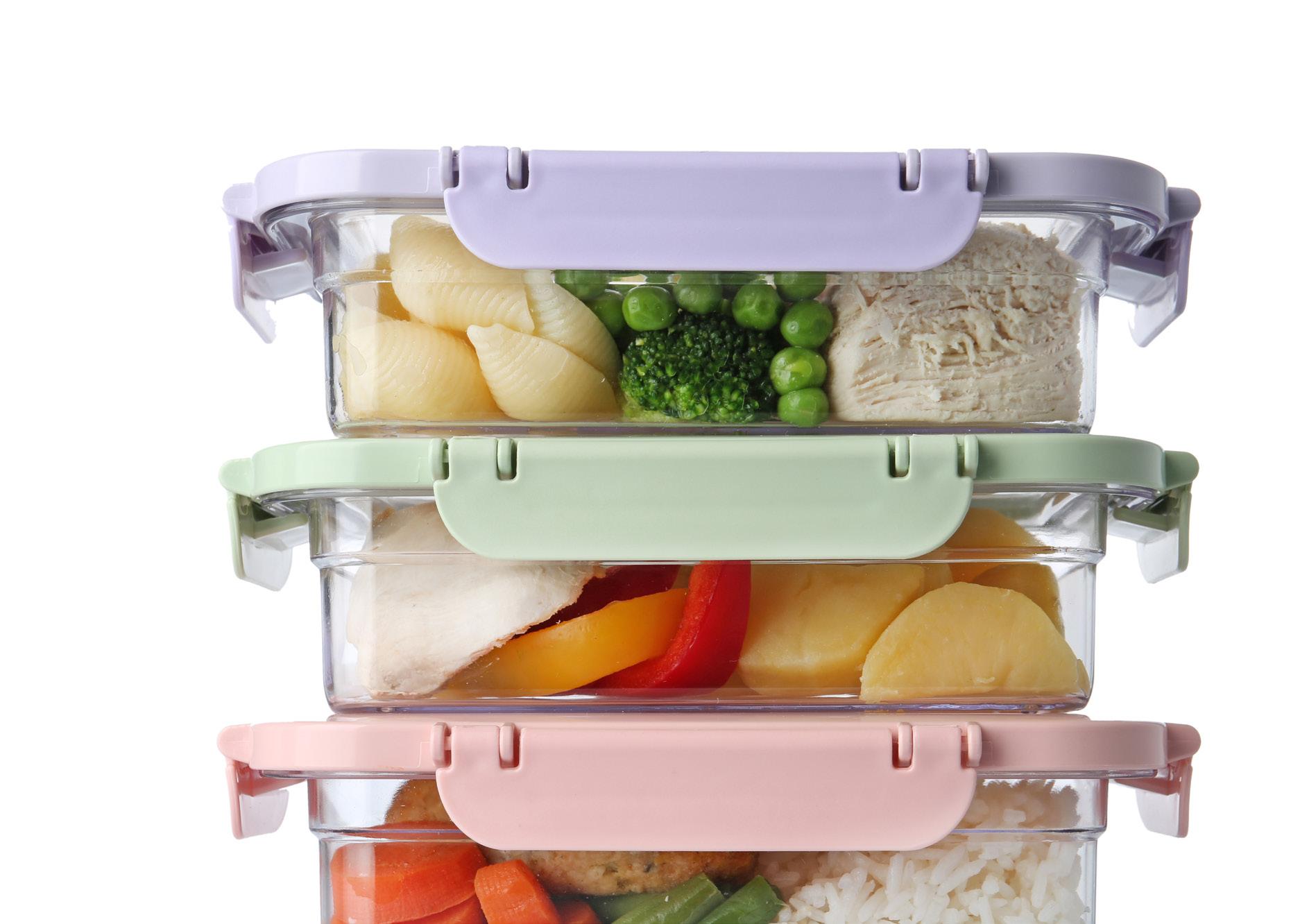
SNORING AND SLEEP APNEA
This daytime therapy for the treatment of mild OSA and snoring uses neuromuscular electrical stimulation (NMES) to train muscles and activate nerves.
NMES is a new and emerging technology in the sleep space, however it has been successfully used across the healthcare industry in other areas for many years.
eXciteOSA provides treatment during your waking hours and has an app to link to your device so you can run the daily program from your phone.


The program consists of:

• An initial intensive period of 20-minutes per day for 6 weeks
• A maintenance mode consisting of 2-3 times per week for 20-minute sessions thereafter
This is 100% daytime therapy with no mucking around required at night, removing the inconvenience for those who do not wish to use, or are unable to tolerate, other therapies.
For treating snore-only and mild obstructive sleep apnea, eXciteOSA offers a new and alternative choice of therapy. The handheld device is lightweight, battery operated and connects to a mobile phone app to run the 20-minute program. It’s travel friendly and without night time hassle, so it can easily be taken on holidays and used discreetly without noise or notice!
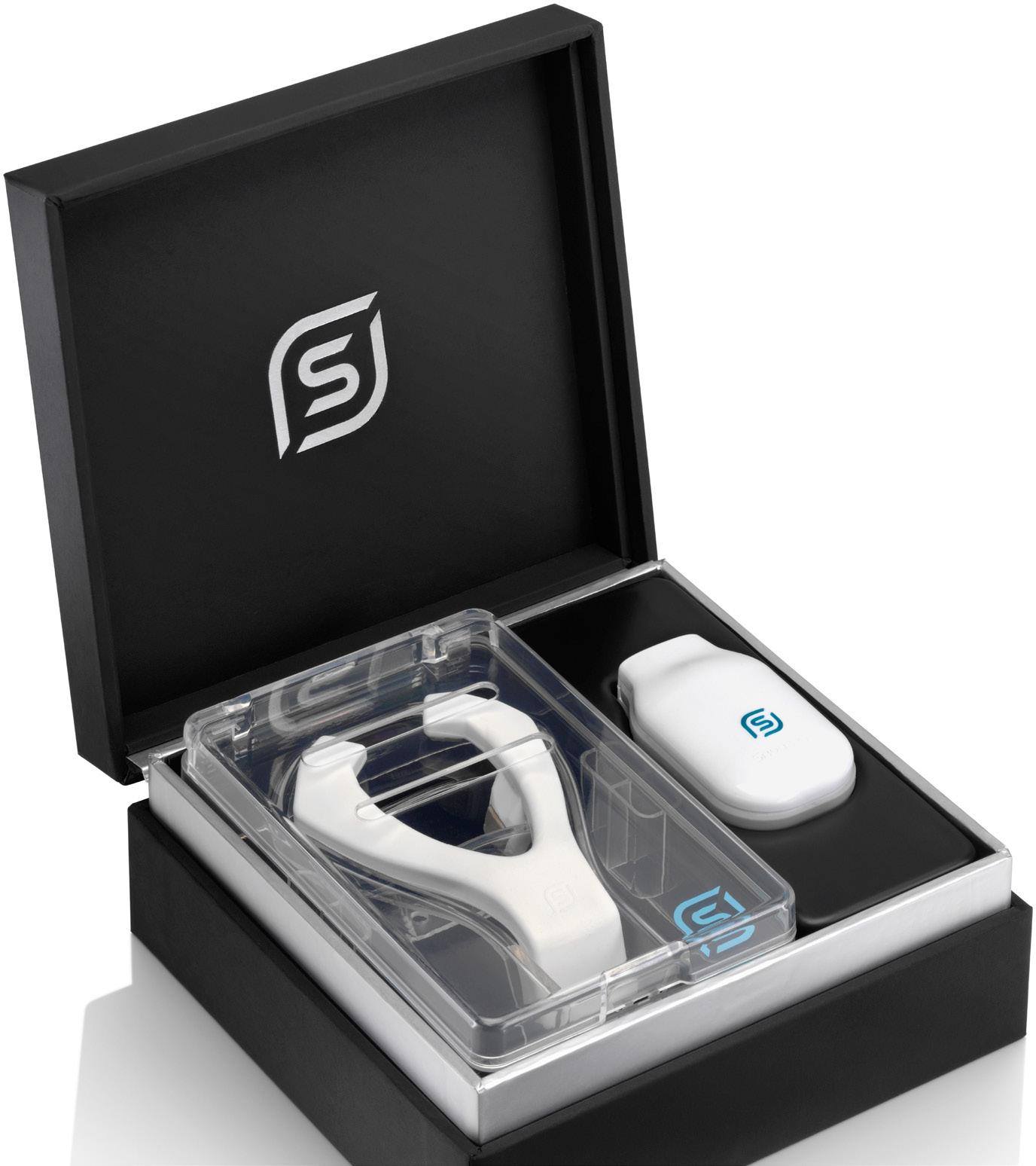
The eXciteOSA app allows the user to control the intensity of stimulation being delivered during treatment. This daytime wearable is non-invasive and free of hassle – a welcome solution for both snorers and mild OSA sufferers alike.
LEARN MORE
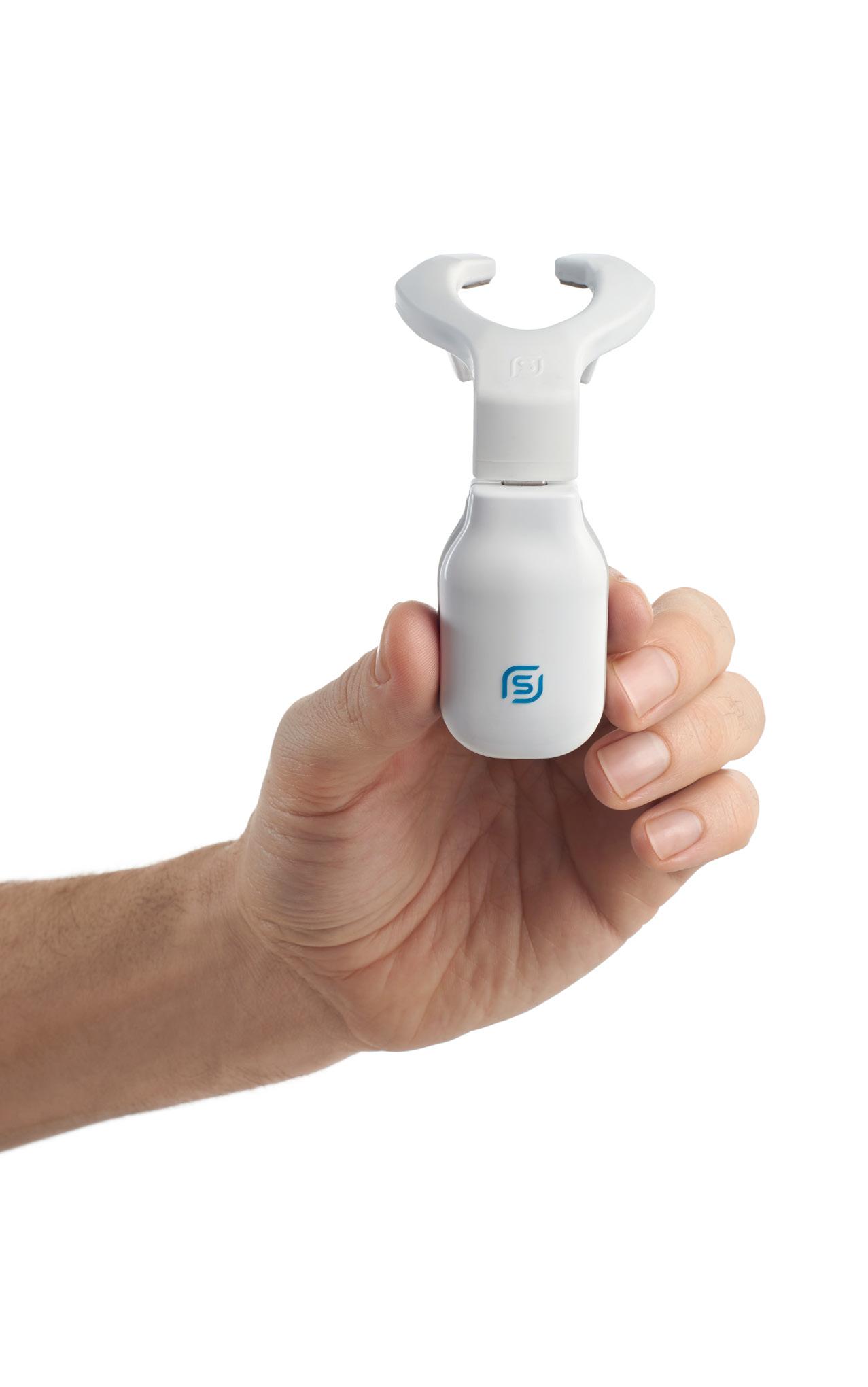
1. CAROBOHYDRATE RICH FOODS
Carbohydrates are perceived by many as “fattening” but what is forgotten is that carbohydrates provide glucose which is essential to provide fuel for the body and is a great source of fibre. Choosing a bread with ingredients that contain wholegrains such as flaxseed or barley will provide long lasting fuel, slow release glucose (low GI), gutfriendly prebiotics and can also even help with controlling weight by providing a very fulfilling lunch.
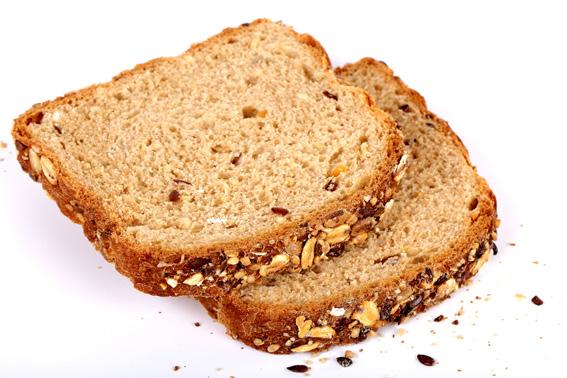
4. POTATOES
Potatoes are both a great source of potassium, resistant starch, and carbohydrates. Funny enough, potatoes have only 15g of total carbohydrate per 1 medium potato which is less than an apple but are often seen as a “voodoo” food if trying to lose
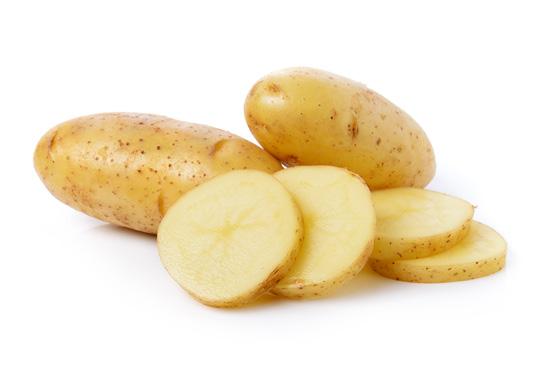
2. DAIRY

Many people are now confused on what type of milk to choose. On the shelf you will find coconut milk, almond milk, rice milk, oat milk, soy milk, lactose free milk and even protein modified milk. The list is endless. Simple dairy milk from a cow provides all important protein, carbohydrate, and calcium naturally without fortification or tampering.
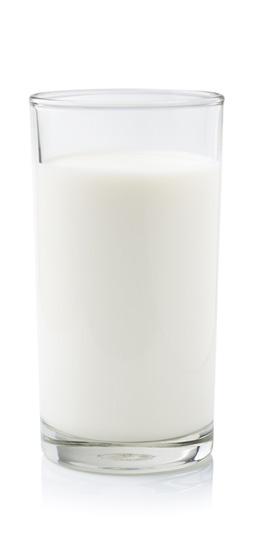
FOODS FOR
3. RED MEAT
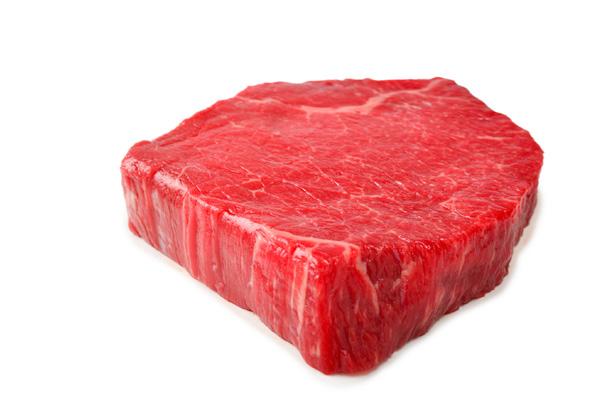
Lean red meat is a great source of lean protein, iron, and sustainable energy. Aim for at least 3 serves of lean red meat per week. Many men can suffer from anaemia (often forgotten as women are more often checked for anaemia) due to not meeting their iron requirements and lean red meat provides a highly absorbable form of iron known as "haem” iron. Vegetable sources of iron are not as efficiently absorbed.
5. OLIVE OIL
Olive oil is a great source of monounsaturated fats, rich in antioxidants and contains all important essential fatty acids. It provides flavour to our foods and a salad is not a salad
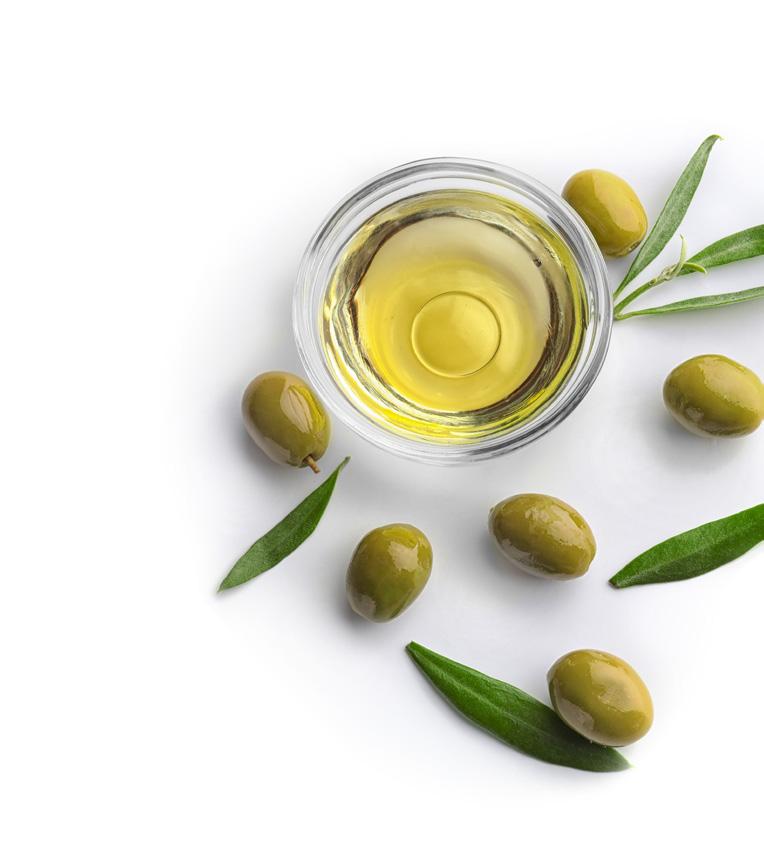
Know your staple foods!
CHOCOLATE
Dark chocolate is well known to be a great source of antioxidants and polyphenols. Many of my patients are “all or nothing” and believe eating chocolate is “cheating and not healthy” but controlled portions can be consumed safely in a healthy “balanced” eating
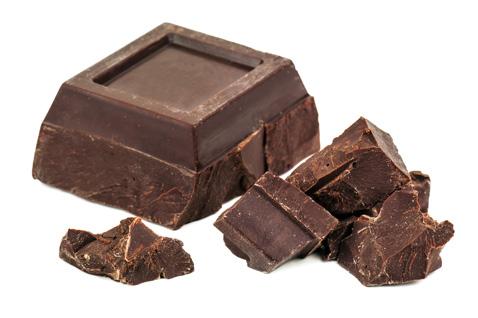
ICE CREAM
We're bombarded with new diets,”fasting” new superfoods and new food crazes all the time, but there are some things that should remain a constant in your diet no matter what.
Many people think “I cannot eat ice cream if I am going to eat healthy”. Ice cream is a source of protein and low GI carbohydrates, even a source of calcium! Eaten in controlled portions, ice cream can be incorporated into a balanced healthy eating plan and does not need to be avoided.
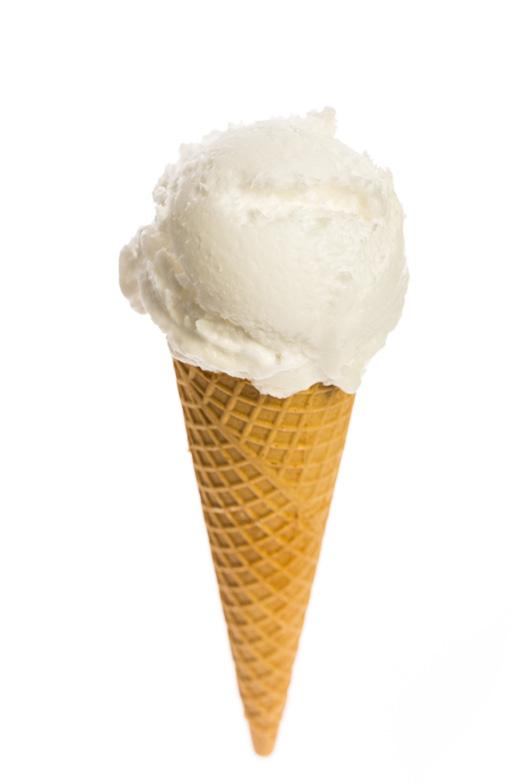 WORDS BY GERALDINE GEORGEOU
Accredited Practising Dietitian DIRECTOR OF DESIGNER DIETS
WORDS BY GERALDINE GEORGEOU
Accredited Practising Dietitian DIRECTOR OF DESIGNER DIETS

WINE
Like chocolate, red wine in particular is also known to contain antioxidants and polyphenols. I usually recommend no more than 2–4 standard glasses per week
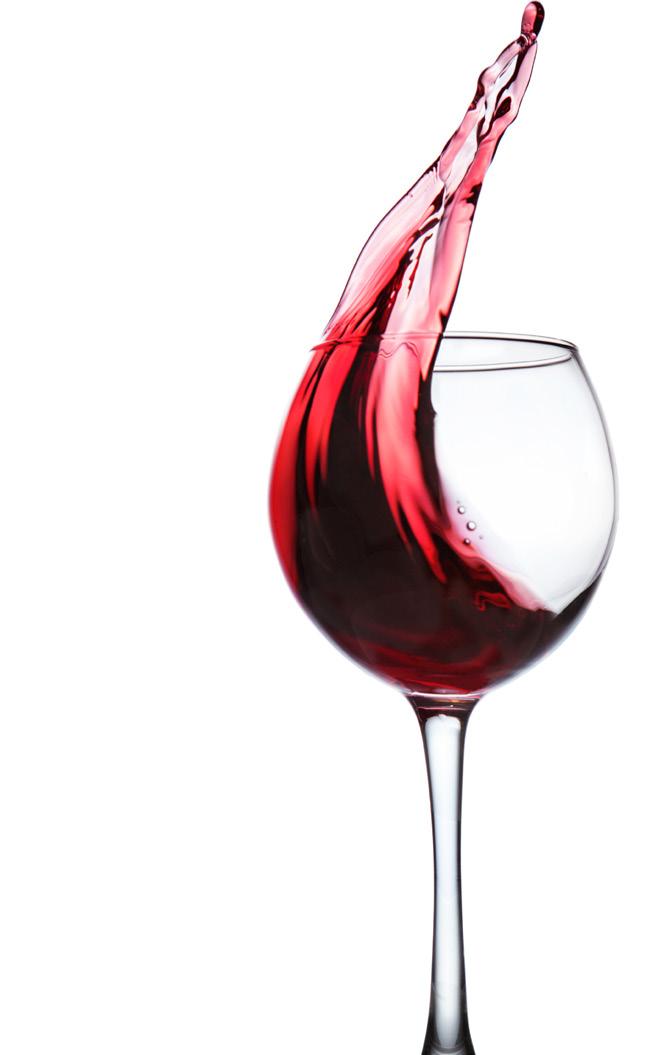 6.
7.
8.
6.
7.
8.
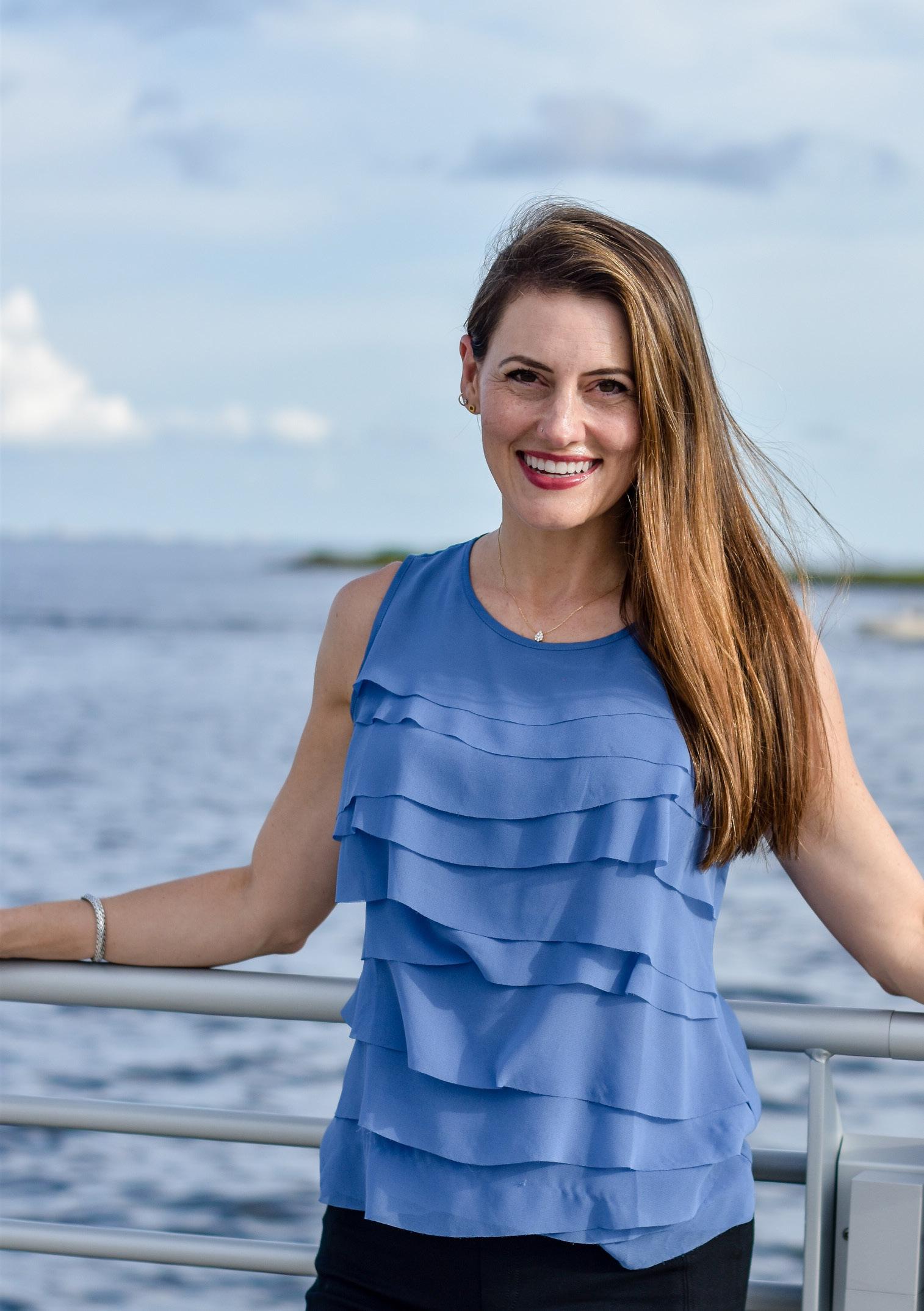
Sara Webb’s story
Sara Webb is an author, inspirational speaker, yoga teacher, and coach with a passion for the healing magic of meditation. Her mission is to empower people to live life with intention, focus on solutions not problems, and transform their suffering into strength. She teaches meditation and self-improvement techniques to clients in order to reduce stress, promote happiness, and become the best versions of themselves.
WORDS BY JESSICA MASUDAA passionate speaker from a young age, Sara Webb has been inspiring listeners for decades as a professional educator turned full-time mother, and currently as an inspirational speaker, following several years in her local Toastmasters International chapter leadership position.
Having confronted her own demons and learned how to process – and reframe – negative thoughts and experiences, Sara is now on a mission to heal the world through meditation.
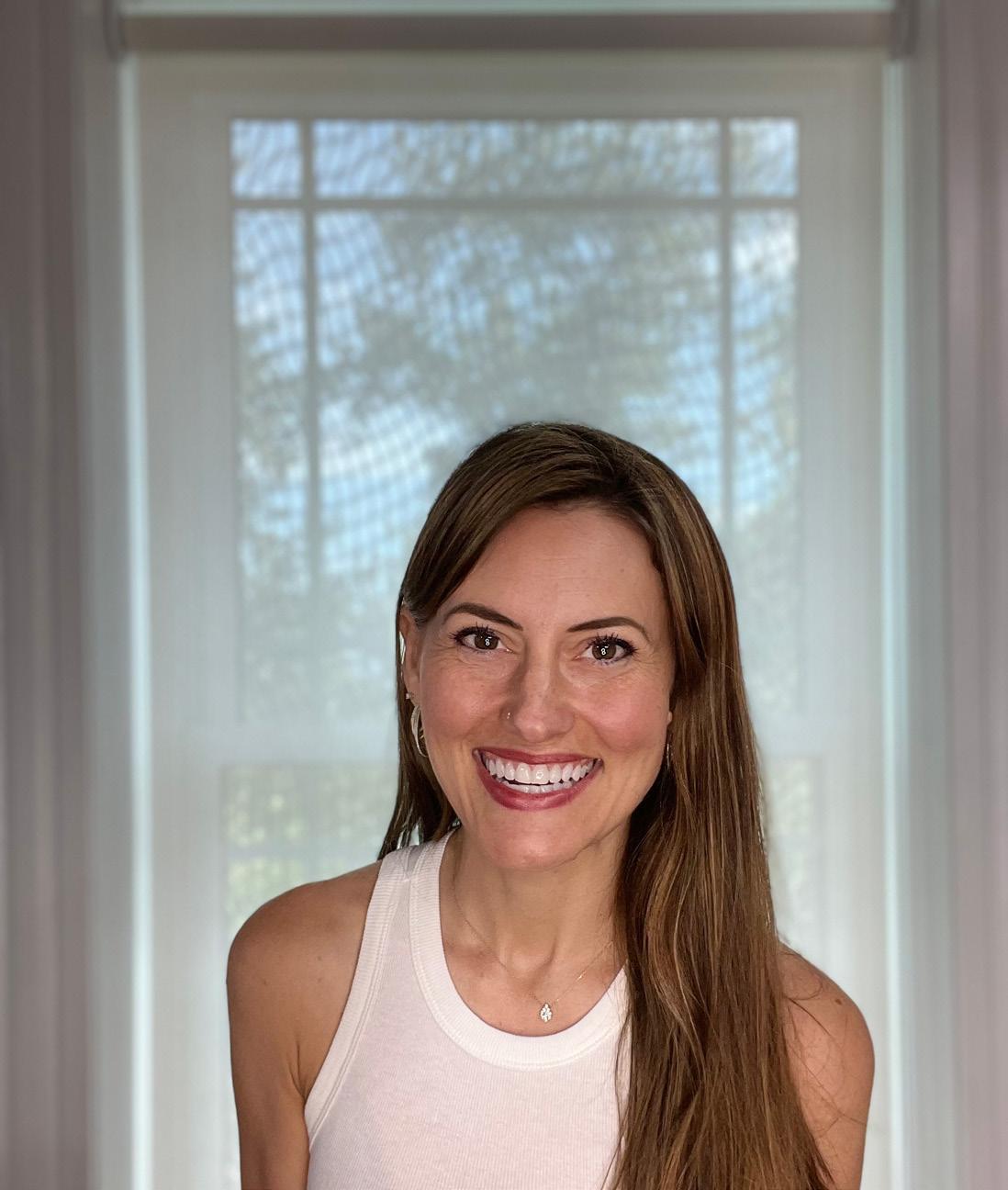
MEDITATION IS MEDICINE
When the opportunity arose to extend her coaching services into the Saving Brothers community, Sara jumped at the opportunity to bring the healing practices of yoga and meditation into the lives of men looking for a little magic. Men may have some resistance to meditation, partly because of the inherent social constructs that push men to focus on accomplishment and doing. Because meditation is the act of stopping and taking stock of the world around us, many people (particularly men) struggle with the seeming lack of action.
As a lover of neuroscience, Sara has invested a lot of personal time exploring a range of studies behind the operation of our minds and how meditation allows us to slip past the various layers of our reality until we reach deep into the subconscious. Meditation, sitting quietly with our thoughts or engaging in repetitive,
“When we access our subconscious, we can hijack our brain waves and insert the way that we want to think and the way that we want to feel. Our thoughts and actions are the only two things that we can control. Thoughts are where it all begins. Thoughts become
mindful activities like sanding down a boat, driving, or mowing the lawn, allows us to slip beyond beta brainwaves - where we generally operate - into alpha or even further into theta, where we are most impressionable.
And this is where the magic - and healing - happens.
“The paradox is that when we sit down and turn our eyes around and look at ourselves, we can actually get more done. It’s been proven that our brain copes better with life when we spend just a few minutes in quiet meditation.”
actions. Actions done repeatedly become a habit. And habits make up who you are,” Sara says. In her speaking role, Sara speaks candidly about her journey from victim to victor and the role that meditation played in that. As a sexual assault survivor and having recovered from alcohol addiction as a result of this experience, Sara used meditation to process her trauma, granting her the ability to forge a life lived on her terms. And this is something we’re all capable of - when we have the tools to build it.
HEALING THROUGH TIME AND SPACE
Sara’s key message is that the mind’s ability to shift our thoughts and change our actions is a personal type of magic we can all cultivate within us. She describes meditation as a type of self-hypnosis that allows us to get in touch with our true nature by slipping down into those impressionable theta brainwaves. It is from here that we can address, and even challenge, thoughts that have been hardwired into our subconscious mind from perhaps a young age, through the power of simply sitting quietly.
But mediation is not a silver bullet, Sara cautions. It does not prevent suffering, stress or negative thoughts - however it does provide us with the tools to change how we react to them.
“The Buddhists say pain is inevitable; suffering is optional… You’re not necessarily going to stop those thoughts but you’re able to look at them and say, ‘I know you. I’m going to put you over here’ and replace it with an empowering thought.”
Sara herself has been meditating for nearly 2 decades. It began with yoga, and 7 years ago she learned TM (Transcendental Meditation). She currently practices a variety of meditation techniques including breathwork, chanting, zazen, and kundalini.
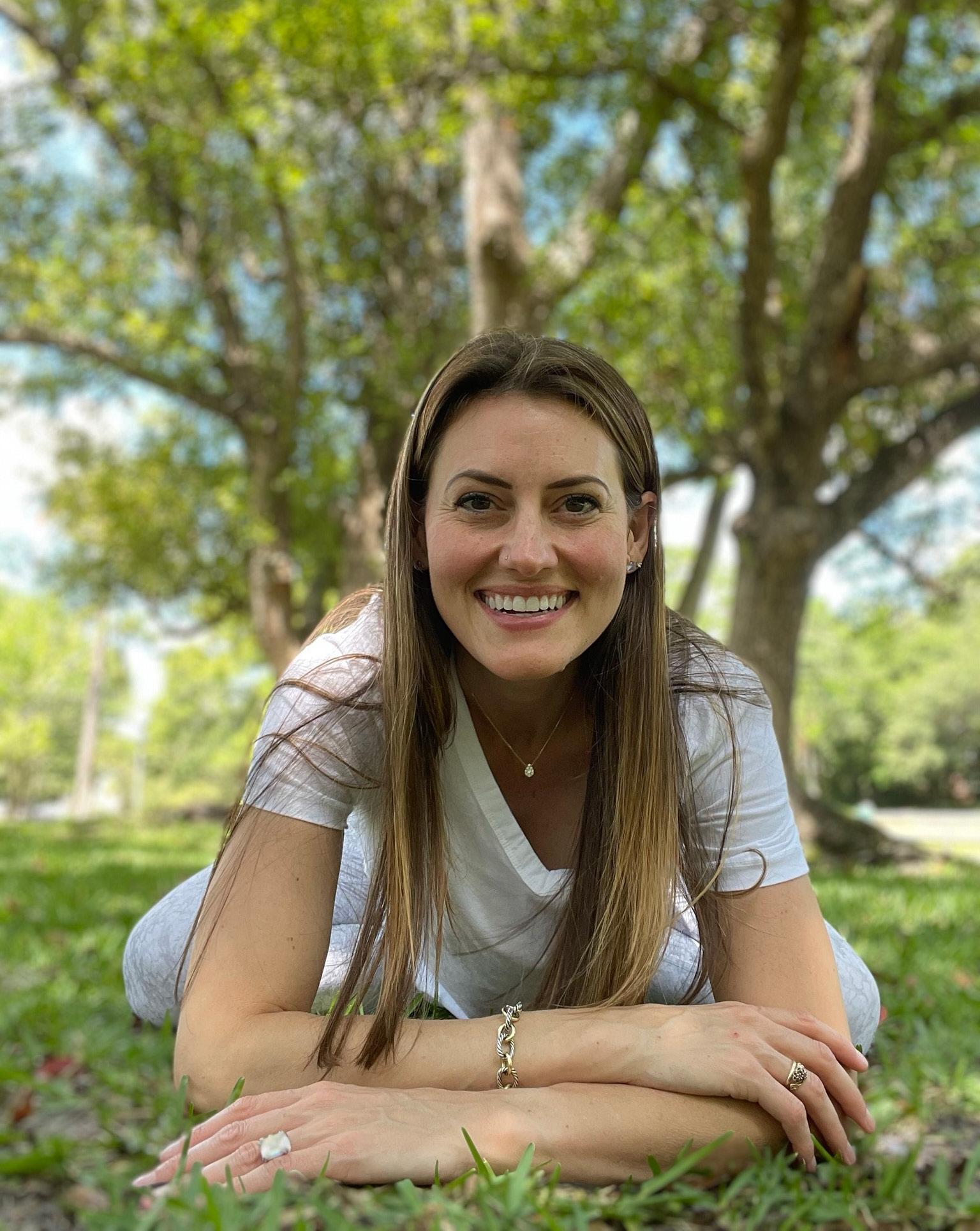
Regular practice of deep meditation can allow for access to the lower levels of the brain, where it may be possible to watch negative or stressful situations play out in alternate ways so we can challenge or replace our ingrained responses, and build ourselves anew.
While some people may experience a knee-jerk aversion to the thought of hypnosis, stepping outside their
“We can survive for weeks without food, days without water, but only for a couple of minutes without breath.”
body or even just setting aside the time to practise this deep form of meditation, Sara assures us there is a process for everyone - and it can be simpler than you think.
FINDING THE TIME TO BREATHE
With the need to find calm in an increasingly busy and overwhelming life being the biggest commonality amongst her clients, Sara notes that breathwork and mindfulness are key skills that can be utilised in our battle to find peace - especially when we struggle to be present in the moment.
One of the first assignments Sara prescribes her clients is to just sit and watch their thoughts. The biggest hurdle she encounters is that instead of being aware of the here and now, they are ruminating on the past, which can cause depression, or feeling anxious about the future.
With breathing being the first of our bodily functions to be compromised when the fight, flight or freeze response is activated, maintaining conscious control over our breath is essential. Originally designed to react to predators in the wild, the stress response can be triggered by any number of things in today’s urban jungle, be it traffic, deadlines, our spouses, or our kids.
“Our subconscious brain is keeping us safe, and it’s a beautiful thing. But it’s constantly scanning our environment for problems, which is why it is so natural to be negative.”
Once our bodies are in a heightened state, it’s very difficult to calm ourselves down. However, by pausing to focus on our breath, we can interrupt our automatic
response to triggers and instead oxygenate our brain and our heart. “Just notice your breath,” Sara coaches. “Notice where your mind is and go, ‘Okay, I’m going to choose to breathe right now instead of responding or reacting’.”
Taking time to stop and notice your breathing is a great way to centre yourself and interrupt negative or stressful thoughts. As the only part of our autonomic nervous system that can be controlled, mindful breathing is the most important tool to have in your wellness kit because it is something you always have with you and can be done anywhere.
3 MINUTES TO THE MAGIC
Sara believes that just three minutes of basic mindfulness to take mental inventory and really focus on deep breathing from the belly is all it takes to get started on your path to calm - and it’s something we all can do.
While many may struggle to get started or have difficulty confronting their subconscious, it’s worth remembering that meditation is something you practise, not master. There are many different ways to meditate, and Sara encourages her clients to access the range of resources available to find the style that works best for them, whether that’s guided meditation, mantras, TM or simple breathwork.
To help impact more lives and teach others how to heal through meditation, Sara is currently in the process of developing her own app in addition to offering individual coaching sessions and yoga for the Saving Brothers community.
WHY PEOPLE DON’T MEDITATE
“I don’t have time.”
“I don’t know how to sit still.”
“I don’t know if I’m doing it right.”
You can keep up-to-date with developments at savingbrothers. com or her homepage, sarawebbsays.com
w sarawebbsays.com
@sarawebbsays
Hiking the TASMAN NATIONAL PARK
The Tasman National Park Tasmania is a stunning corner with natural beauty that 60 walking tracks, including multi-day adventure, the This renowned scenic walk three night journey leaving takes you through the tall Tasman National Park and highest sea cliffs.

NATIONAL
Park in south-east corner of the world, filled can be explored over including the award-winning, the Three Capes Track. walk is a 48km, four day, leaving from Port Arthur that tall eucalypt forest of the and up along Australia’s
WORDS BY STEVE CHAMBERLAIN-WARDThe Three Capes Track is the premier hiking experience in the Tasman National Park and a mustdo for all nature lovers. I first heard about the track through a friend of my wife. We originally planned to go in 2021 when COVID unfortunately delayed us, but we recently managed to tackle the track along with three of our university friends (all in their 50s), plus a 21-year-old daughter.
marathon in Queenstown – the others weren’t and one of them even shared the concerns that his mother and co-workers had held for him. Luckily, the track allows you to ease into things, with a relatively short walk on the first day of just 4km from the ferry to the hut.
“It was a bit like the show Survivor as we were dropped off on a deserted beach to start the walk.”
PREPARING FOR THE WALK
The walk needs to be booked in advance as only 48 walkers can leave each day and costs just shy of $500, which includes a ferry from Port Arthur to the start of the walk and a bus back from Fortescue Bay at the end.
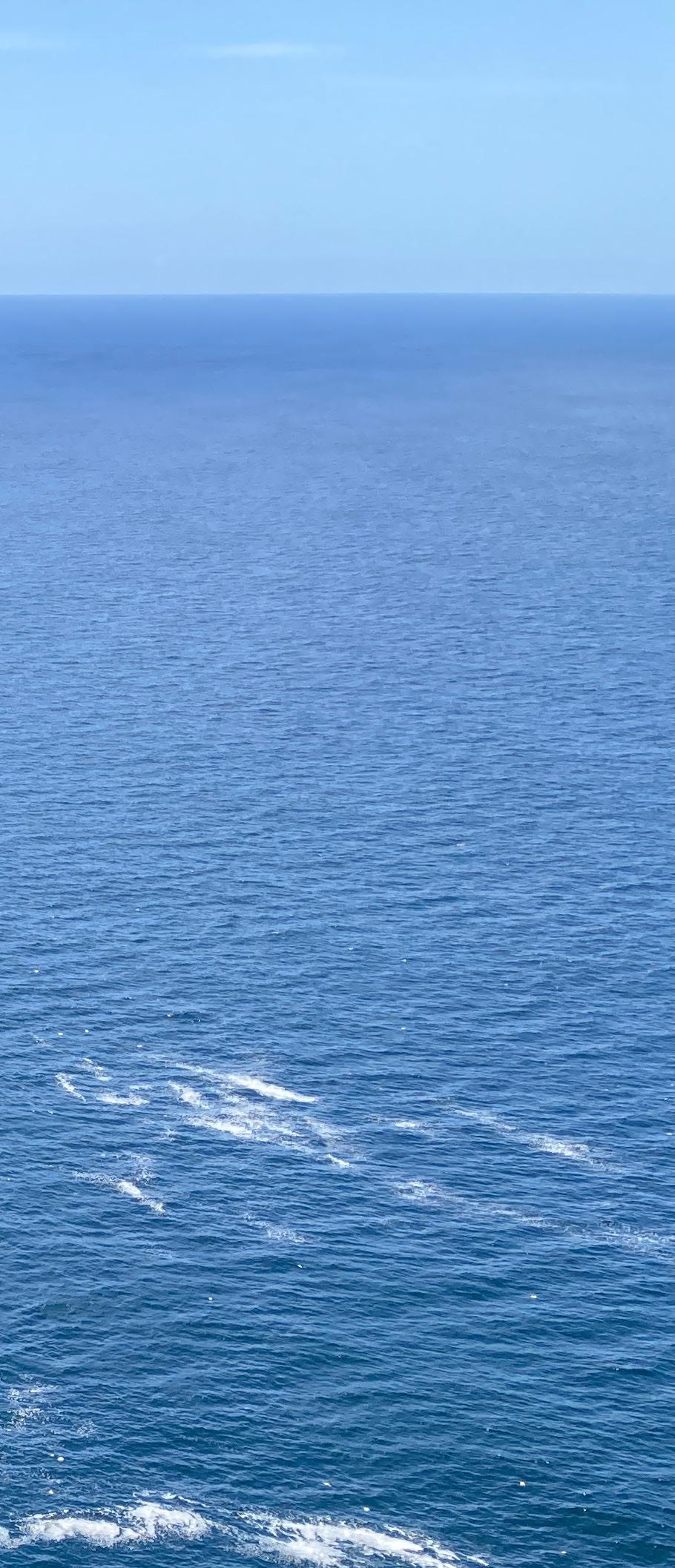
Although the track is billed as being achievable for all ages and abilities, if you’re not overly active before embarking on this journey, I’d suggest some endurance training like walking with weights in the weeks leading up to departure to help you prepare.
While Sue, my wife, and I are quite fit – she recently ran a half
The cooking facilities and accommodation at each of the huts were amazing and it was great not to have to carry camping equipment with us. We did have to bring our own food, but the Tasmanian government had invested $30mil to upgrade the track and build these opulent huts, which had wonderful comfortable beds, and there was lots of space both inside and out.
Things heated up after that, with subsequent days involving treks of 11, 19 and 14 km, including lots of walking up and down hills as well as countless steps. The hiking poles were put to great use, let me tell you! The views from up on the cliffs, however, were stunning.
“The Three Capes Walk demands long days of walking while carrying a pack of supplies weighing about 10kg.”
FREEDOM TO EXPLORE
I decided to leave the group in Port Arthur, to take advantage of all the wonderful solo experiences readily available across Tasmania. As an introvert, I also travel well on my own, so I took this opportunity to spend time in and around DerbyTasmania’s mountain bike capital. While the others continued with the Three Capes Track, I headed towards the Freycinet National Park to hike the saddle between Mt Amos and Mt Mawson for a glimpse of the beautiful view of Wineglass Bay. This is one of Tasmania’s most celebrated views, but the walk up to the viewing platforms is steep and rough – not at all like the upgraded tracks of the Three Capes.
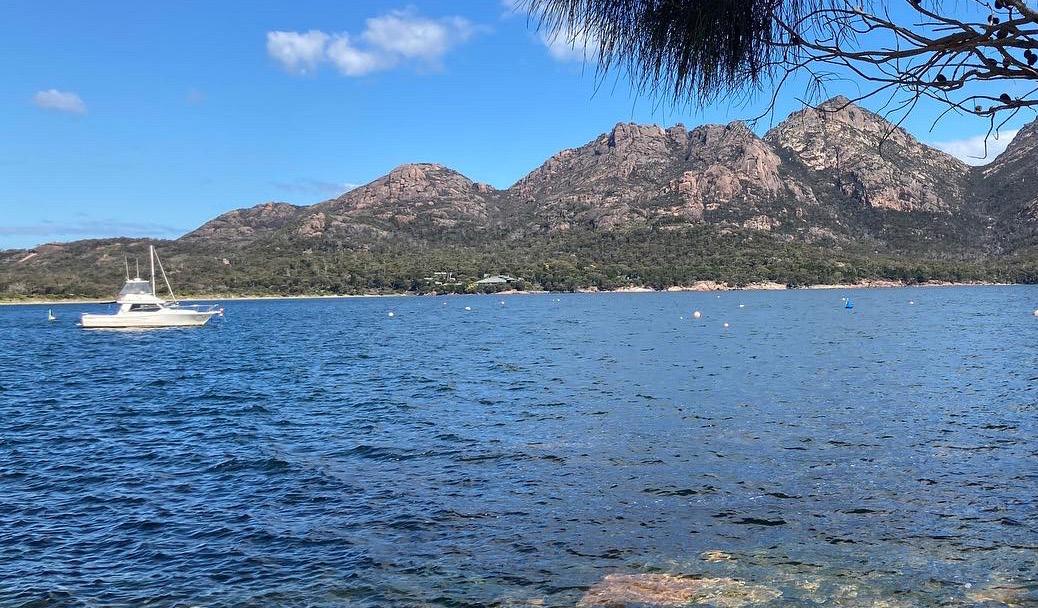
From there, I returned to Derby after spending the night in St Helens, where I had arranged my first ever mountain bike shuttle. This service has you driven to a spot on one of the famous trails where you’re left to ride before picking you back up 7kms down the track.
After enjoying a rewarding - but exhausting - couple of days on my own, it was time to regroup with my
commented on my exploits from the previous day!”
friends and family, and I had a little surprise up my sleeve I’d devised a few months earlier.
While the full Three Capes Track can only be done in a counterclockwise direction, there is a tough but manageable 7km hike from Fortescue Bay up to the last hut. With a day pack filled with cheese, biscuits, nougat, and a 3-litre bladder full of red wine, I set out from the bay to rejoin the others.
The hike up to the last hut was harder than expected, but I was greeted with joy - I suspect that my supplies may have played a good part in this! In the hour I spent with the group, we managed to empty the wine bladder and eat all the cheese and nougat before retracing my steps back to the car.
The following morning, I returned to Fortescue Bay and hiked the 4km coastal track to the stunning Monument Lookout – some 300m above the sea – to wait for my friends, who were hiking from the opposite direction.
TRAVERSING HOME
My wife and friends joined me after a while and we hiked back up to the Cape Hauy intersection. The hike out to Cape Hauy has amazing views of the ocean and towering cliffs. Despite being only a fairly short diversion of just a few kilometres, it was super challenging and by the time we’d walked out and back we must have climbed around 2000 steps or 100 storeys!
It was then just a matter of hiking the remaining 3.6 km to Fortescue
“I’d made quite an impression on the other walkers, as several
Bay – a gorgeous white sandy beach in the Tasman National Park for a quick dip in the freezing water – before finally returning to Port Arthur.
It was great to see the level of satisfaction they all got out of this walk. One of my friends described it as the hardest physical challenge he had ever done, while others found it challenging but achievable. All agreed that it was a great adventure and something they’ll always remember.
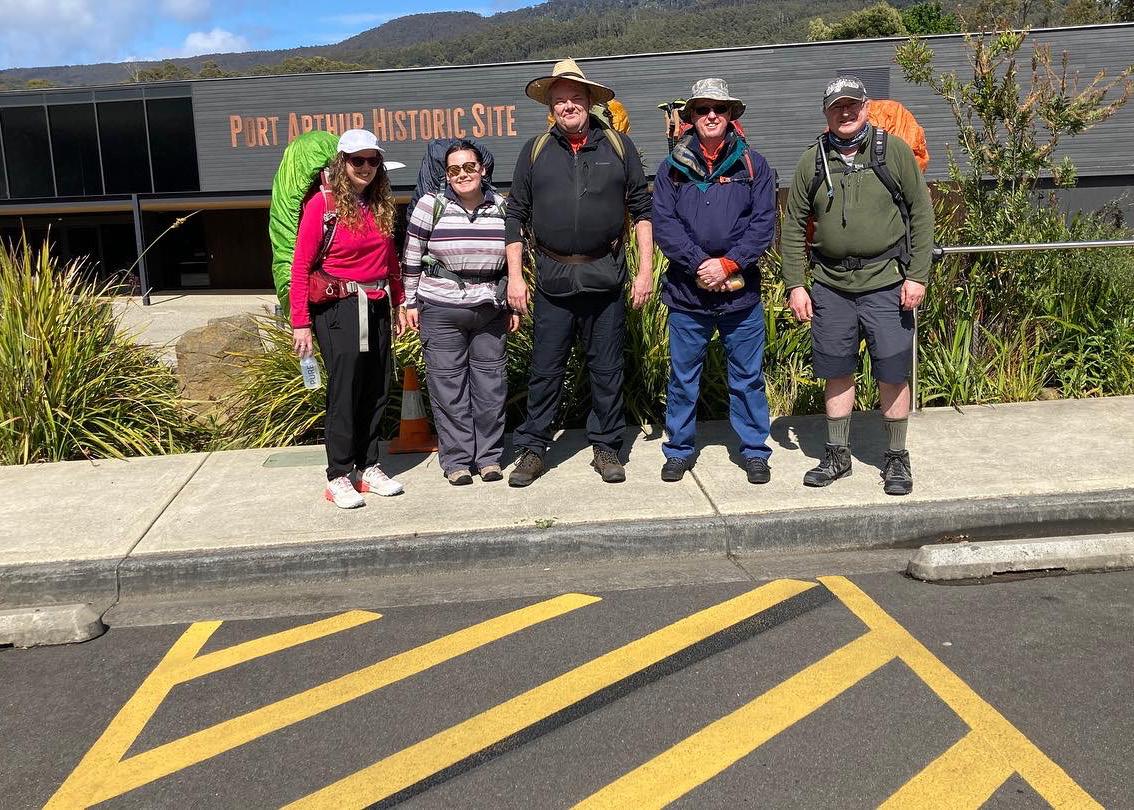
With countless walking tracks, mountain bike trails and outdoor adventures of all kinds, there is so much on offer in Tasmania.

If you’d like to read more about the Three Capes Track or book your own experience you can do so at https:// www.threecapestrack.com.au/ experience.html.
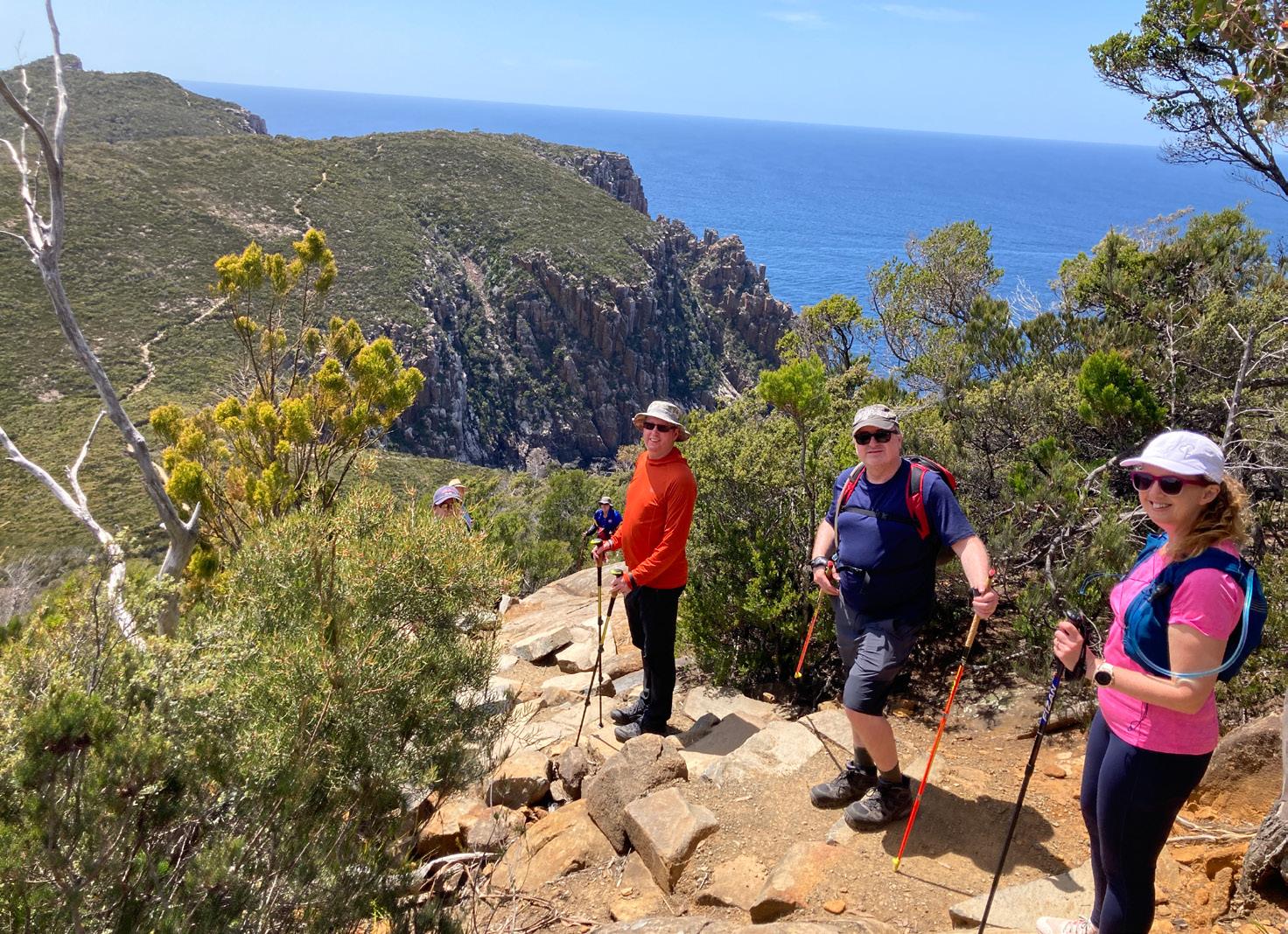
It’s absolutely worth it.
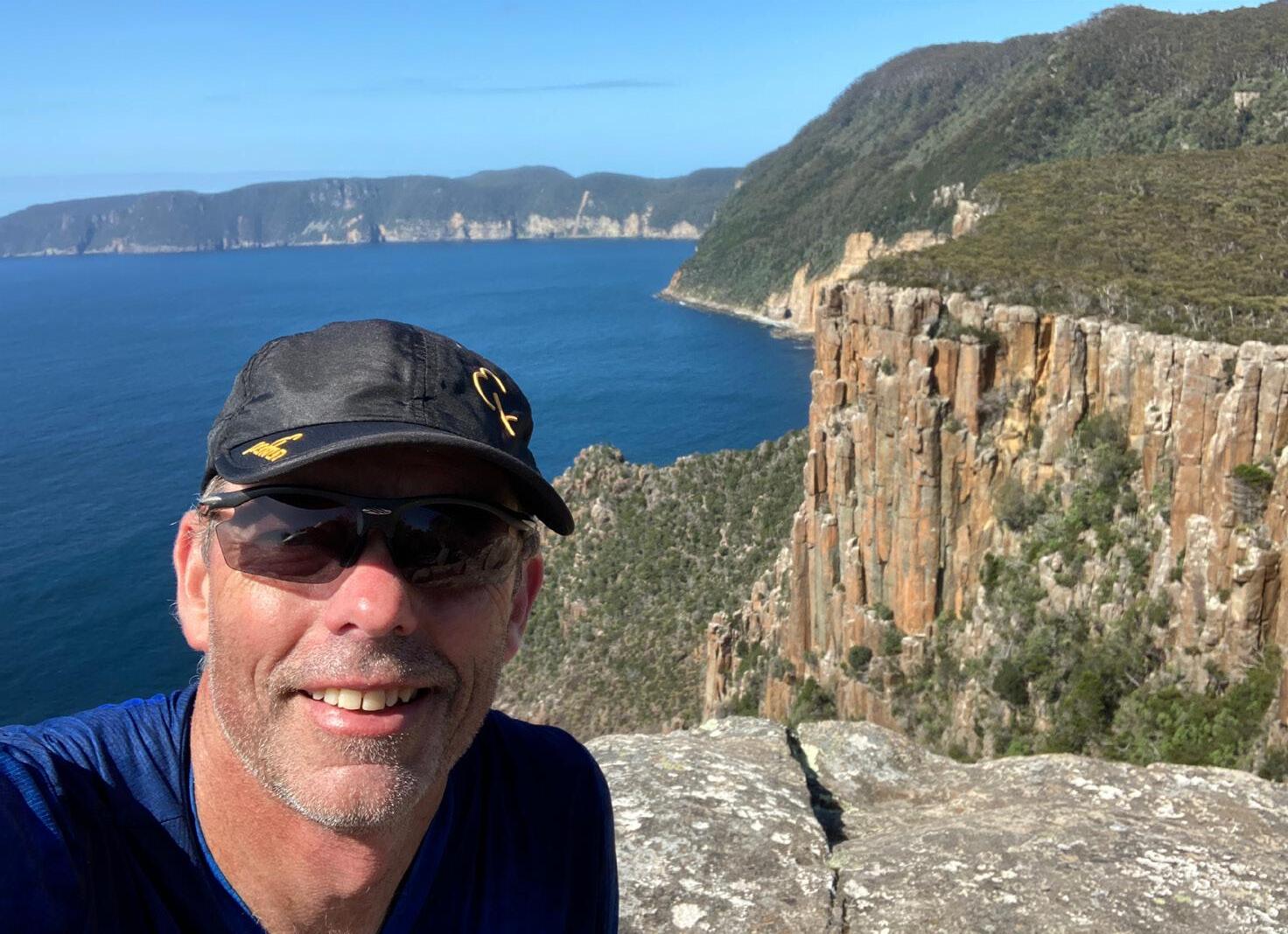
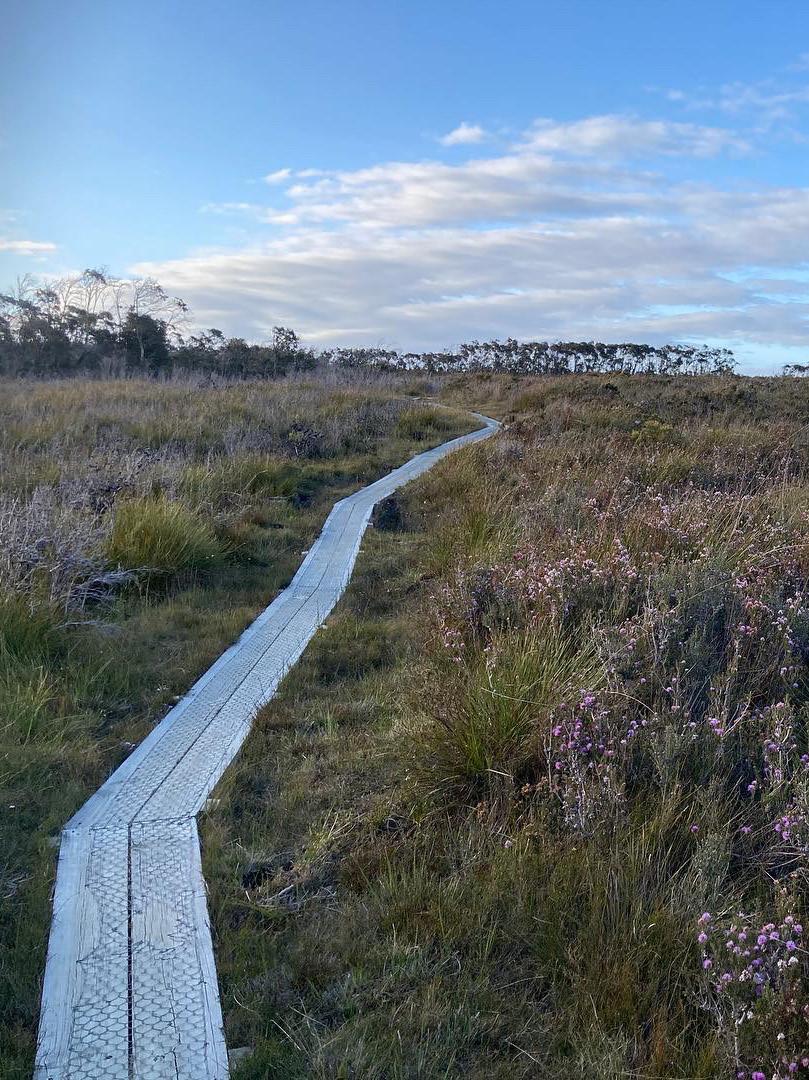
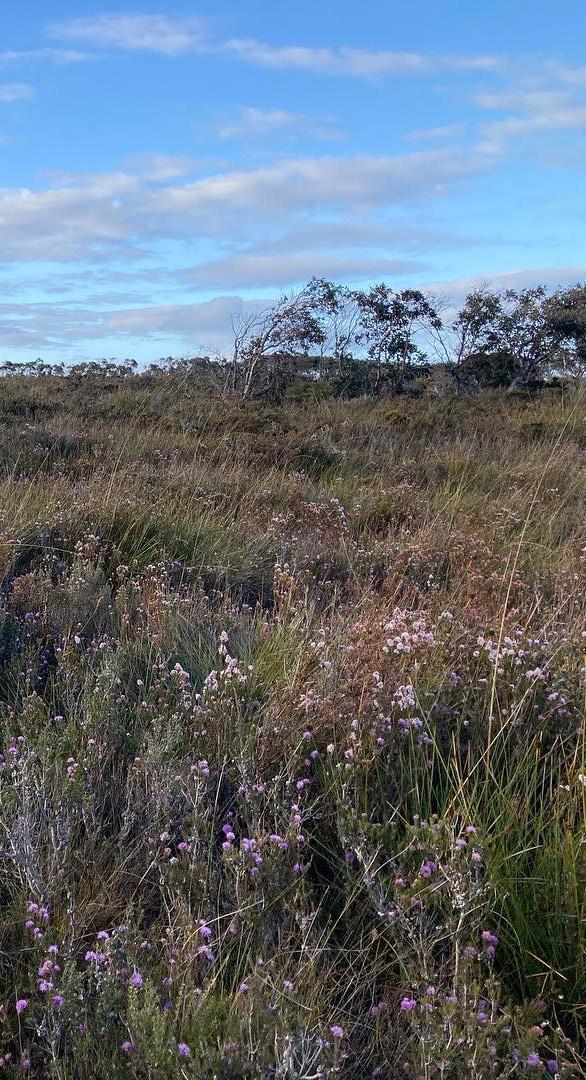
“I was a little nervous trying this new experience on my own, however I turned out to be one of the fastest riders of the day.”
Jeremy Oliver Living life with a glass half full
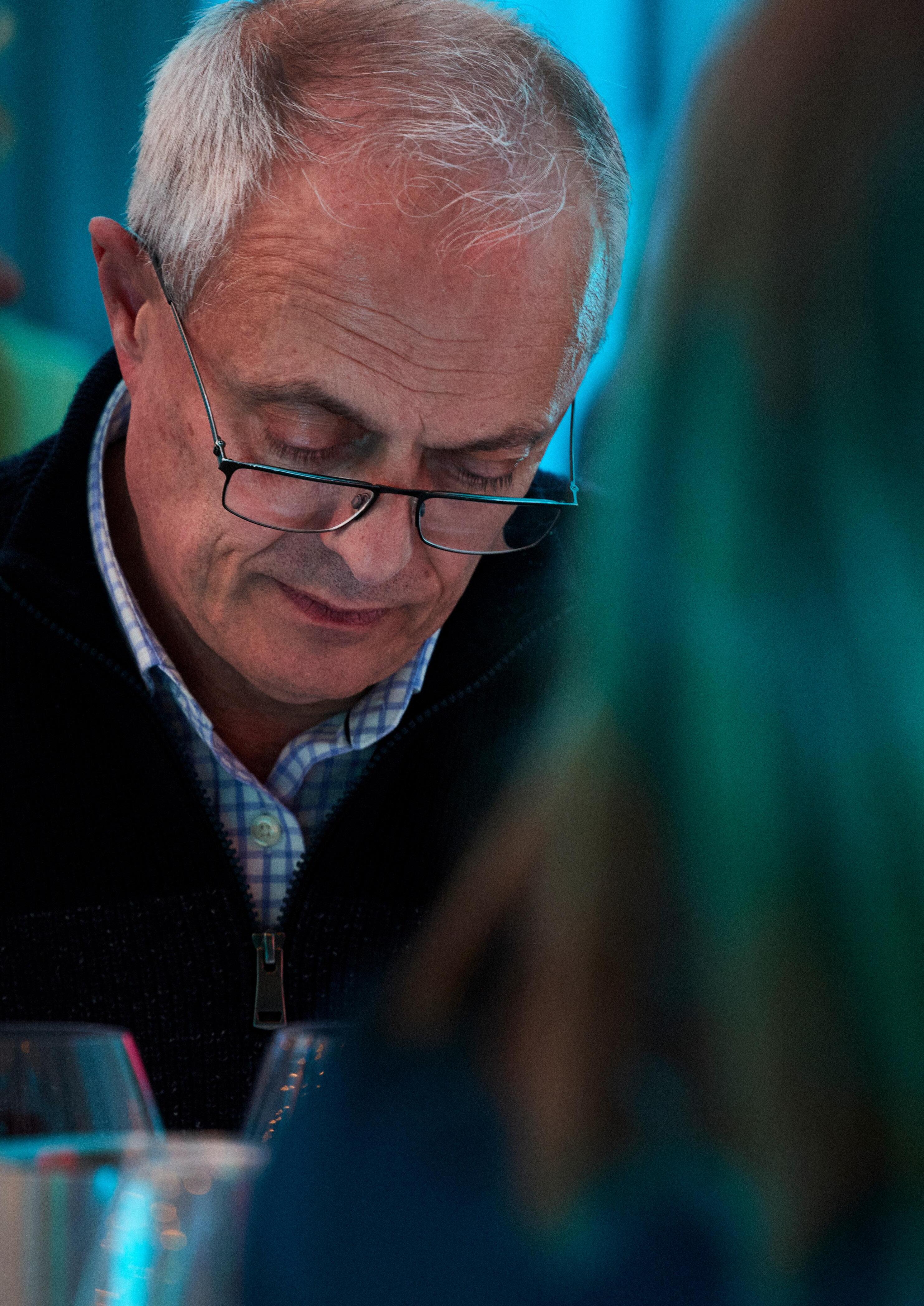
Jeremy Oliver’s story
When it comes to knowing wine, not too many people in the world are more qualified than Australia’s very own, Jeremy Oliver. Jeremy is an Australian wine writer, commentator, critic, educator, and presenter with more than 35 years of experience in writing and presenting wines. He published his first book, Thirst for Knowledge, at the age of 23, making him the world’s youngest professional wine writer. He has written more than 30 books since then. In 2005 he was named Wine Writer of the Year by Australian Wine Selector magazine and in 2018, Best Wine of the World (BBW) named him one of the world’s top 20 wine critics.
WORDS BY ALICE WHITEWHERE IT ALL BEGAN
It was Jeremy’s father’s interest in wine that Jeremy credits for his early introduction to what would become a passionate career.
As chaplain of Ballarat Grammar School, Jeremy’s father and other staff members would regularly take delivery of 250L barrels of wine for bottling. At their ‘bottling parties’, young Jeremy observed firsthand the nuances and flavours of the different wines–a knowledge that would serve him well as he forayed into a career as a wine writer, commentator, critic, educator, and presenter. He knew as a youngster that there was something special about wine’s ability to bring joy and happiness, something that he continues to enjoy being a part of to this day.
THE STUDY OF WINE
Jeremy completed a Bachelor of Agricultural Science at the University of Melbourne in 1982, then spent a year working in two
renowned Coonawarra wineries –Lindeman’s, and Katnook Estate. In 1984, he completed a Graduate Diploma in Wine at Adelaide’s esteemed Roseworthy College. It was at this time that Jeremy realised that he didn’t want to be a grape grower or winemaker given so many of the top vineyards are too remote. “They are a long way away from a decent cup of coffee,” the loyal Melbournite said. Despite this realisation, studying wasn’t a fruitless exercise. Being one of the few international wine writers with a formal tertiary education in winemaking and viticulture, Jeremy said, “if you’re going to write critically about wine, the least you can do is to learn how to make it.”
A SPECIAL MENTOR
While working in one of his first jobs outside of university as a floor stacker and advisor in the ‘Connoisseur’s Corner’, Jeremy had the honour to be mentored
by Dan Murphy. Jeremy worked in the original Dan Murphy store on Chapel Street in Melbourne and has managed to maintain a friendship and bond with Dan for many, many years.
“Dan was an amazing teacher,” he said. “He had this set of dark winetasting glasses, designed so you couldn’t see the colour of the wine inside. I can’t tell you how hard it was just to tell colour from nose and taste–especially with some wines that Dan knew to be especially tricky...” Although he had but a single store back then, Dan was a major force in the Australian wine industry. Their friendship extended decades. “For reasons I cannot explain, Dan took a liking to me and became my first mentor,” Jeremy reminisced. Jeremy’s mind was also influenced by other mentors including Len Evans (whose biography he wrote) and Peter Lehmann.
TASTING, JUDGING AND REVIEWING WINE - ALL IN A DAY’S WORK
Jeremy Oliver is one of the most respected names in wine. Over the last 35+ years, he has been a professional wine critic, authored over 30 books, written for dozens of publications in Australia, the UK, the US, Russia, Korea, Singapore, Japan, and China, and has made hundreds of appearances on radio and television. Jeremy is deeply committed to Australian wine and is not afraid to be critical of it when he believes it’s in the best interest of the consumer.
No stranger to pivoting when life throws him a curve ball, Jeremy has experienced several setbacks during his career. From declining book sales leading him to change his focus to online activity, to the pandemic all but wiping out his speaking opportunities due to international travel restrictions, plus changes in trade tariffs in China impacting his specialty market, Jeremy acknowledges when the chips are down. Regardless, he refuses to see anything but a glass half full.
LOOKING FORWARD
Over the next few months, Jeremy is gearing up to publish a new website using cutting-edge technology. The site will have a curated online retail selection using world-leading wine recommendation software.
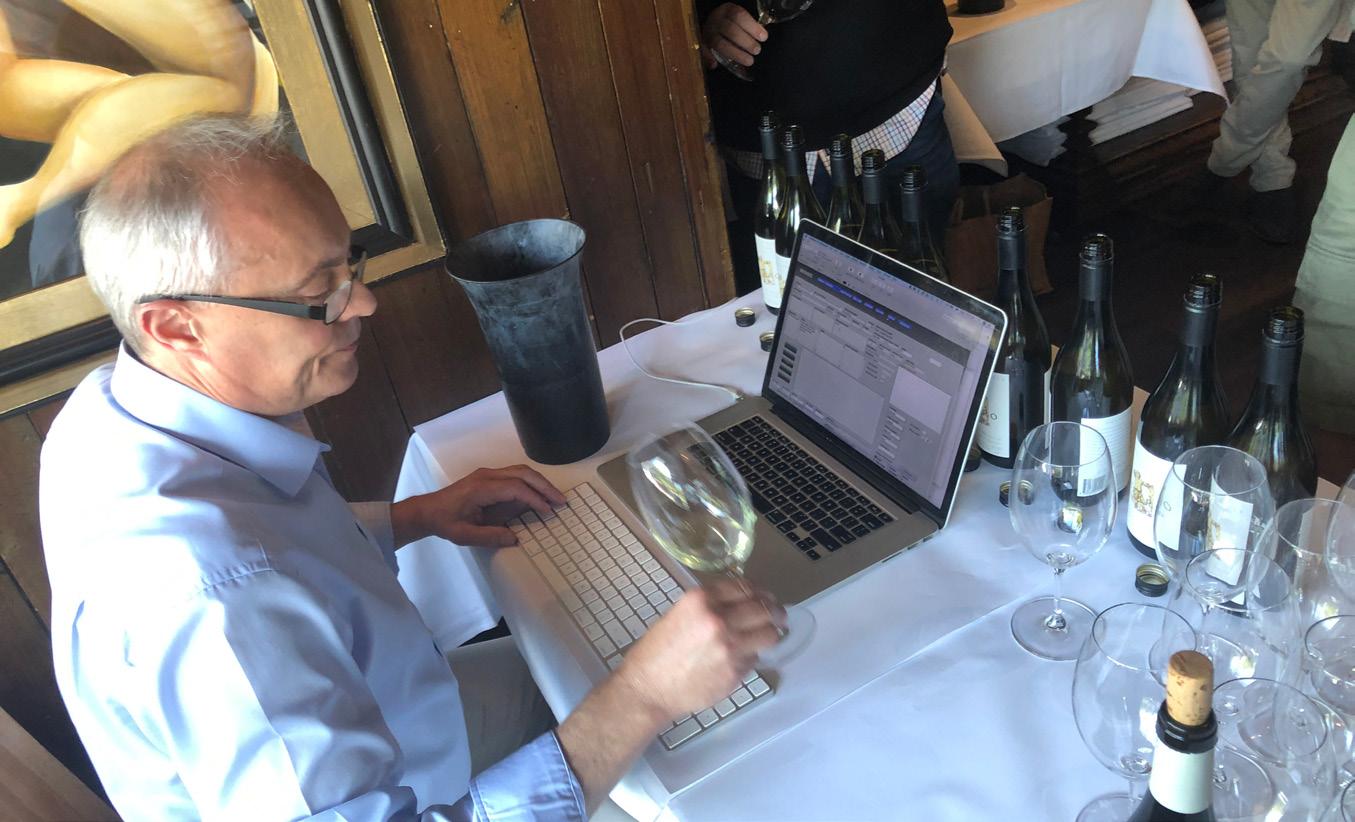
“The consumer doesn’t have to know anything about wine; they might just know a few wines they like. When they enter those wines into the system, we’ll return the very best wine recommendations based on their preferences.”
Jeremy is hoping the on-demand digital content and retail service will help open up the world of wine to more people. “When you’re spending $20, $30, $40 or more on wine, you want to be confident
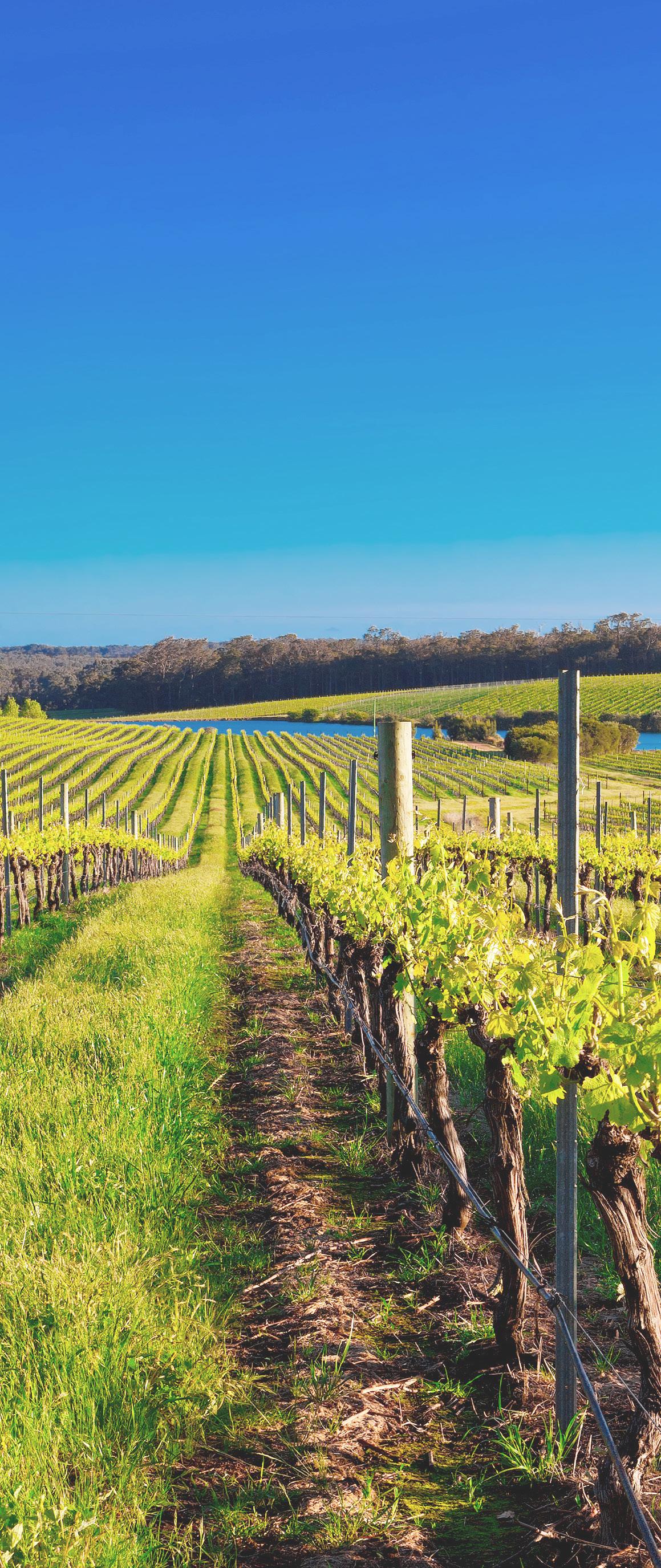
you’ll like it. No one wants to waste money, so they often stick to wines they know or order a single glass at a restaurant to sample,” Jeremy said, optimistic for more people to expand their palate’s horizons.
ADDING ANOTHER BOOK
As well as his new website, Jeremy is working on a book on the best cellar doors in Australia, including wineries; breweries, and distilleries. Jeremy says it’s all about the cellar doors that offer the best experiences to the visitor. “Australia has so many hidden amazing wine destinations, and they’re not all in Adelaide! Anyone venturing on a road trip should tuck this book in their dash… this is the best way to get value from Australia’s fabulous cellar door culture,” he said. With his partner in this crime, Robin Shaw, Jeremy has used a lifetime of
visiting and researching Australian cellar doors to draw inspiration for this book, having met with owners, tasted their products, and gained insights into what makes them unique. His book will list detailed information on each cellar door, about their location, food offerings, unique experiences and whether or not they offer accommodation and are friendly towards children, pets, caravans or RVs. We’re tipping it to become a fabulous gift idea, too!
AUTHENTICALLY HIMSELF
When critiquing wine, Jeremy prides himself on his rating scale and likes to point out that he is one of the only writers in Australia today who marks one as low as in the 70s out of 100.
“This gets me into a lot of trouble with winemakers. I’m usually not the most popular person in a room full of winemakers or critics”, Jeremy told me. “But I don’t get any income from wine producers. I am a
critic, not a cheerleader.” He prides himself on his unbiased reviews and while he may not be popular amongst those winemakers he marks lower, he says he’s usually a very welcome guest at parties and events. “Everyone seems to want to pin down the wine critic, so at times I end up telling people I’m a teacher or a mortician!! One of the issues around being completely honest about wine is that people are always telling you their favourites. So you soon learn how to let people down gently!”, he says.
STAYING PUT
Previously a frequent traveller around wine regions overseas as well as emerging wine markets
in Asia, Jeremy is often asked why he chose to remain living in Melbourne, despite the many opportunities available for relocation. His response is twofold: his son resides close by and he believes Melbourne is today the leading wine capital of Australia. “I’ve got to be careful what I say to a lot of friends in South Australia and Adelaide, but I think Melbourne is the full-time wine capital of this country; simply because of the diversity of the region, its wine and its cuisine and the scale and diversity of the population now. It’s quite astonishing.” With a glass-halffull attitude, Jeremy looks forward to what the future has in store.
JEREMY’S TOP 10 WINE REGIONS IN AUSTRALIA:
1. Margaret River WA
2. Barossa Valley SA
3. Adelaide Hills SA
4. Coonawarra SA
5. Yarra Valley VIC
6. Clare Valley SA
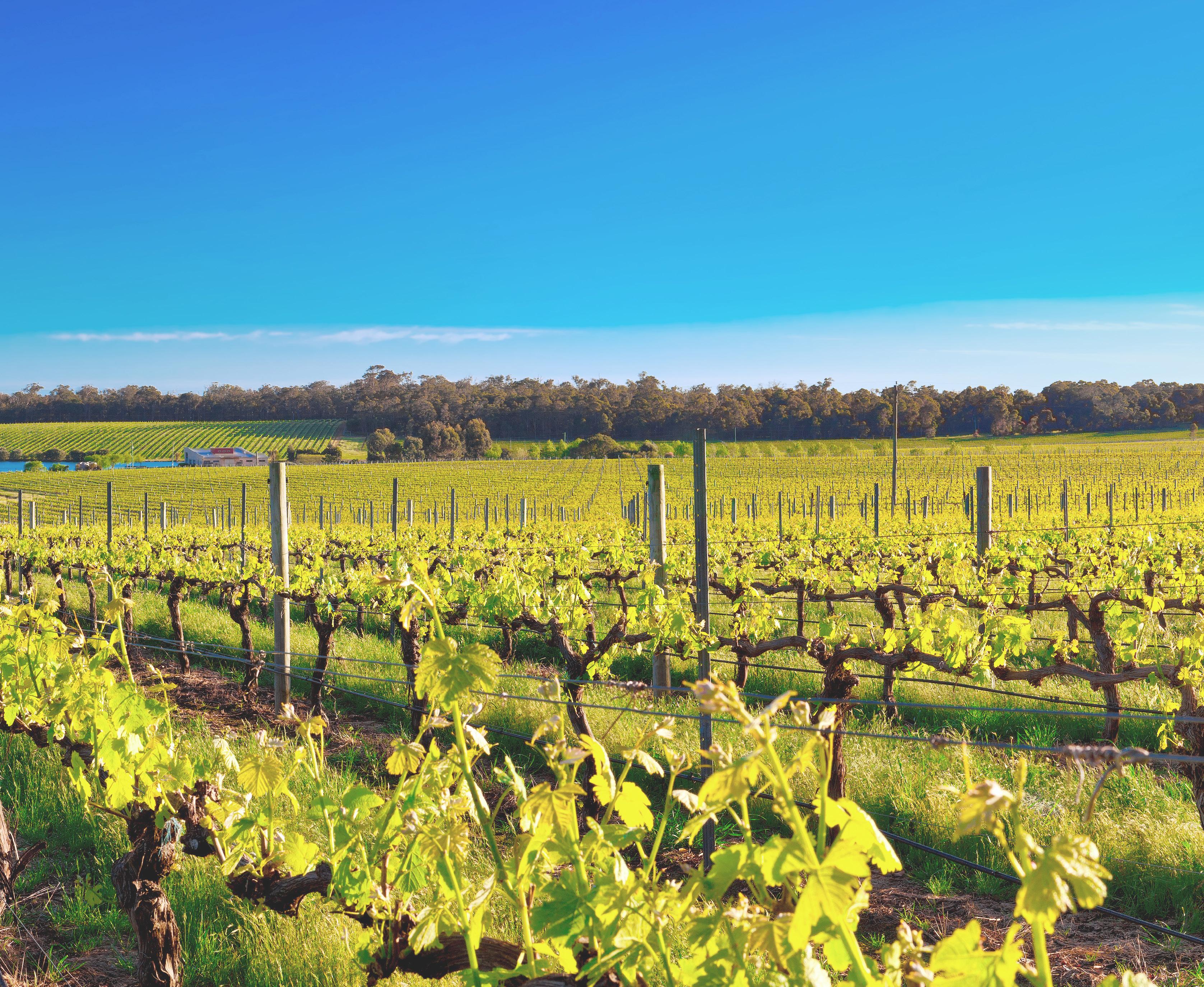
7. McLaren Vale SA
8. Mornington Peninsula VIC
9. Great Southern WA
10. Coal River Valley TAS
“The consumer doesn’t have to know anything about wine; they might just know a few wines they like. When they enter those wines into the system, we’ll return the very best wine recommendations based on their preferences.”
Let go of the Baggage!

Transformation & Relationship Consultant
w in www.ZevHalpern.com
p
www.linkedin.com/in/zevhalpern
Relationships: Today & Tomorrow
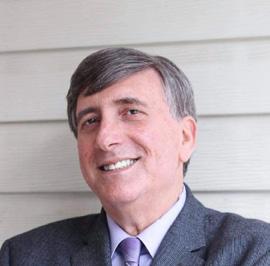
What baggage are you dragging up the hill like a sack of heavy rocks? Is it getting in the way of the life you really want? We’ve been raised by the rules, rituals and behavior of our parents’ marriage, former relationships and role models, as well shaped by our schools, family, and environment. And these have a profound influence on many of us as we grow into adulthood. We come out of our childhoods gravitating to familiar patterns and situations because we recognise them as what we may need. Truth is, we would be better served if we dropped the baggage that helped us navigate our childhood. Now, it only serves to block our clarity and success.
In life, we meet, are attracted to, and even recruit people and partners who help us act out familiar life patterns and scenarios. This is what humans do. Our lives are plays and we’re actors who perform our parts well - and this includes shouldering the unique, historical baggage that comes attached to the role.
Sometimes we play this role even if it has negative consequences and is non-advantageous to our situation. However, it’s important to remember: we always have a choice.
MAKE A DECISION TO IDENTIFY THIS OLD “STUFF”
• Negative role models
• Teacher and adult voices
• Limiting beliefs about our capabilities
• Mistakes we made as children
• Leftover experiences from relationships
• Negative self-talk
it’s from our childhood and has no business being in our adult lives. We’ve simply gotten used to having this old baggage around, even if it no longer serves any purpose. Truth is, it’s like carrying 400 pounds of rocks up life’s mountain –who needs that?
confounding even the best of our intentions - so let it go!
I know it takes courage to rid yourself of baggage. But when you let go, you open a window to positivity in your life, which allows growth and success to happen. This is one of the most important tasks of our adult lives.
By consciously acknowledging the negative consequences of old baggage, we welcome joy, meaningful relationships and positive habits that have the possibility of propelling us toward the successful and fulfilling life we deserve.
We can cease to unwittingly enroll other people to fulfill the patterns we grew up with, allowing us to let go of some of the relationship - and life-destroying baggage. Afterall,
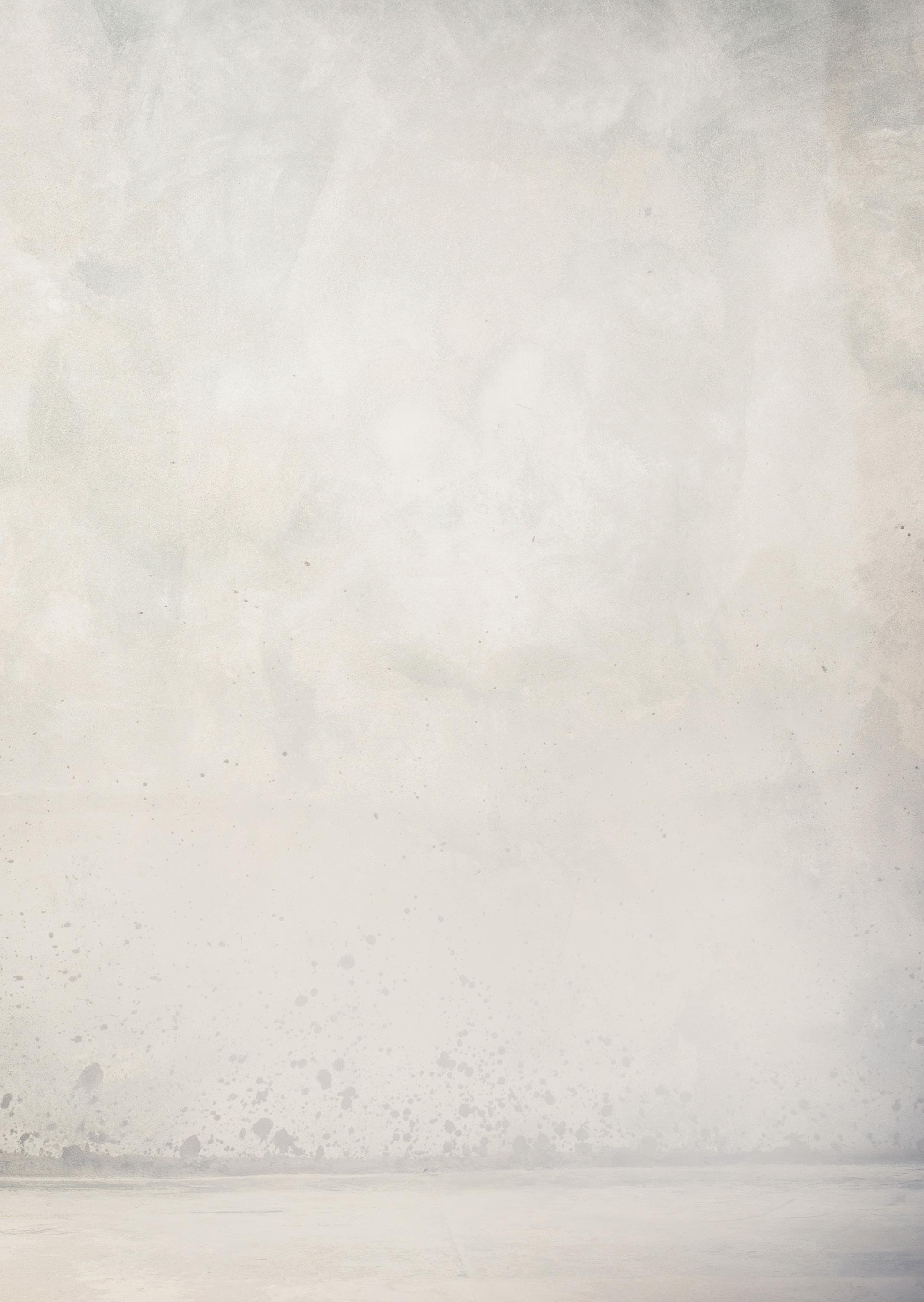
We need to banish this old baggage so it stops causing problems that complicate our relationships, marriages, and adult lives. It’s just laying around, living rent free,
So, I encourage you: be bold and let go of unneeded baggage. You will find new role models and influencers who can provide the tools to push you forward in life. By letting go and seeking clarity, you can become the person you were truly meant to be. You can become the best version of yourself, free to pursue your goals and aspirations.
Wishing you positivity and success!
Confronting our old baggage can improve many aspects of our lives.
Geraldine Georgeou has spent much of her personal and working lives surrounded by men. So, it’s ideal that she’s a key part of the Saving Brothers team, focused on the role of nutrition in men’s health. Today, we learn more about her and her significant work.
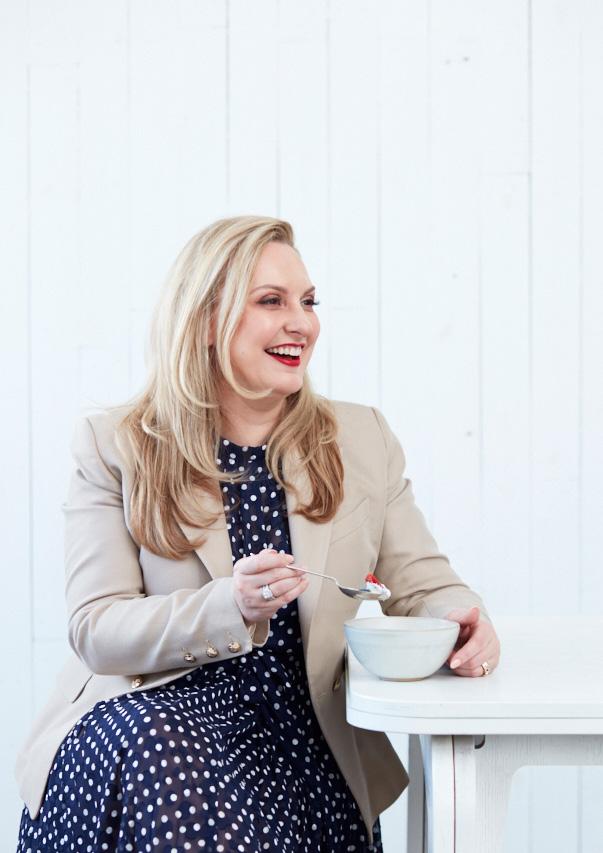 WORDS BY VIVIENNE PEARSON
WORDS BY VIVIENNE PEARSON
FUEL YOUR BODY’S ENGINE: diets designed for your make and model
A LIFE SPENT WITH MEN
Geraldine has spent most of her life happily surrounded by males: she is her father’s only daughter and has a twin brother, a husband, and a 21–year–old son. “Some would say I was a tomboy growing up,” she says. “I’ve spent a lot of time enjoying male-dominated activities like fishing, car racing, and building.”
So, perhaps it’s no surprise that after qualifying as a dietitian by completing a master’s degree, Geraldine has helped many men, including those who come to her through her business Designer DietsTM.
“I could be one of the only dietitians around who’s worked with such a huge volume of men… I’ve worked with whole ships of them!” she says about her time working with the navy as well as hospital inpatients and prisoners within the Long Bay jail. “It’s a privilege to work in men’s health.”
REFLECTIONS ON MEN’S NUTRITION AND HEALTH
Geraldine often likens nutrition to being fuel for a car. “If we look after our car and tinker with the engine, we get to understand what fuel works for which car,” she says. “Men like to fix things so if nutrition information makes sense, they’ll understand and use it.”
“When men know how to nourish themselves from within, there’s a huge impact on so many areas of their health,” she says. “Everything is affected – hormones, weight, cardiovascular disease, diabetes, sleep, sexual health, and even eye health.”
Yet, she knows nutrition cannot act alone.
“Some men look to nutrition because they don’t want to take more medicine, but food is not a health remedy on its own,” she says. This indicates her approach to working alongside doctors and other health professionals. “At the
end of the day, if the car’s engine is broken or rusted out, we need to fix the engine. I consider whether a man might need a blood test, a sleep study or other investigations when looking under the hood.”
In all her years of experience, Geraldine has come to see that men appreciate a clear and reallife approach to their health. “My approach is to help men understand where they’re starting from, how to set achievable goals, understand the nutrition-disease interaction and what they need to do in the present,” she says. “Men really value that as they can see the purpose and the outcome. It makes it real.”
As a dietitian and founder of Designer DietsTM, Geraldine is interested in both preventing and slowing the onset of disease. She is also interested in using nutrition to reverse disease processes and avoid exacerbating health conditions.
GERALDINE’S VIEW ON DIET FADS
“I’ve wanted to work in nutrition since I was 16, so I’ve seen so many food trends – everything from the ‘Hip and Thigh Diet’ by Rosemary Conley, to the Macrobiotic Diet.” Geraldine says. “One of my roles is to sift through fad diets to help people know the role of nutrition in their health.”
She knows men are influenced by the media they consume. Some of this is negative, such as influencers with no qualifications peddling diets on their socials.
Other media can have a positive influence, including Geraldine’s many television appearances, including 15 years on Today Tonight with Dr John D’Arcy’s Kick-Start Revolution and a 13-part show called The Food Investigators which looked at everything from whether chicken soup will really cure a cold
to how people survived on WWII rations.
Geraldine is no fan of a current dieting trend: intermittent fasting. “We haven’t seen enough evidence in practice and remember, a lot of research is done on mice and we are not rats,” she says. “For example, the University of Sydney recently published an article that says intermittent fasting might achieve weight loss but isn’t good for health. And some of that weight loss will be muscle.”
REAL MEN’S EXPERIENCES
Geraldine recently welcomed a 50-year-old man back to her practice. “He lost weight with me 15 years ago but, during Covid, most of the 40 kilograms came back,” she says. “He went on a program with someone who wasn’t trained and lost weight initially through restriction, but he was forced to take so many pills. He realised
that this trendy way of eating isn’t a long-term solution.” When men understand the difference between weight loss and health, they can make better decisions for their body.
SAVING MEN THROUGH SAVING BROTHERS
Geraldine will share her knowledge as one of the co-editors of the beingMAN magazine. Stay tuned for more on keeping well from within, and visit her at Designer DietsTM to discuss your own journey to wellness and access her bespoke co-collaborated nutrition and health programs including The Sleep Diet, The Metabolic Reset, and The Gut Reset.
We’ll leave Geraldine now to get back to her consultations and perhaps a spot of fishing and boating! Thank you for the work you are doing within the Saving Brothers community to foster men’s health and wellbeing.
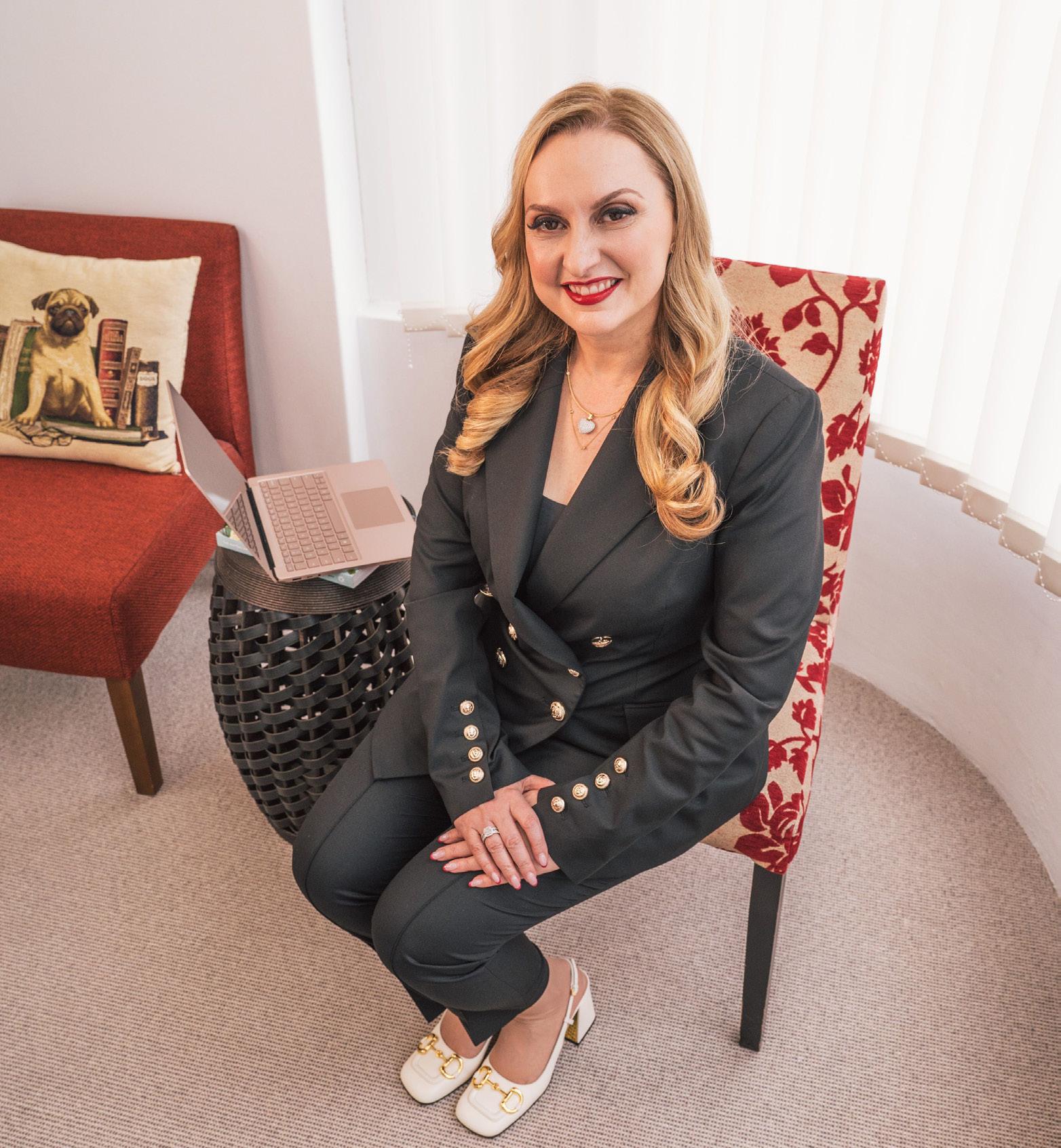
“I’ve wanted to work in nutrition since I was 16, so I’ve seen so many food trends –everything from the ‘Hip and Thigh Diet’ by Rosemary Conley, to the Macrobiotic Diet.”
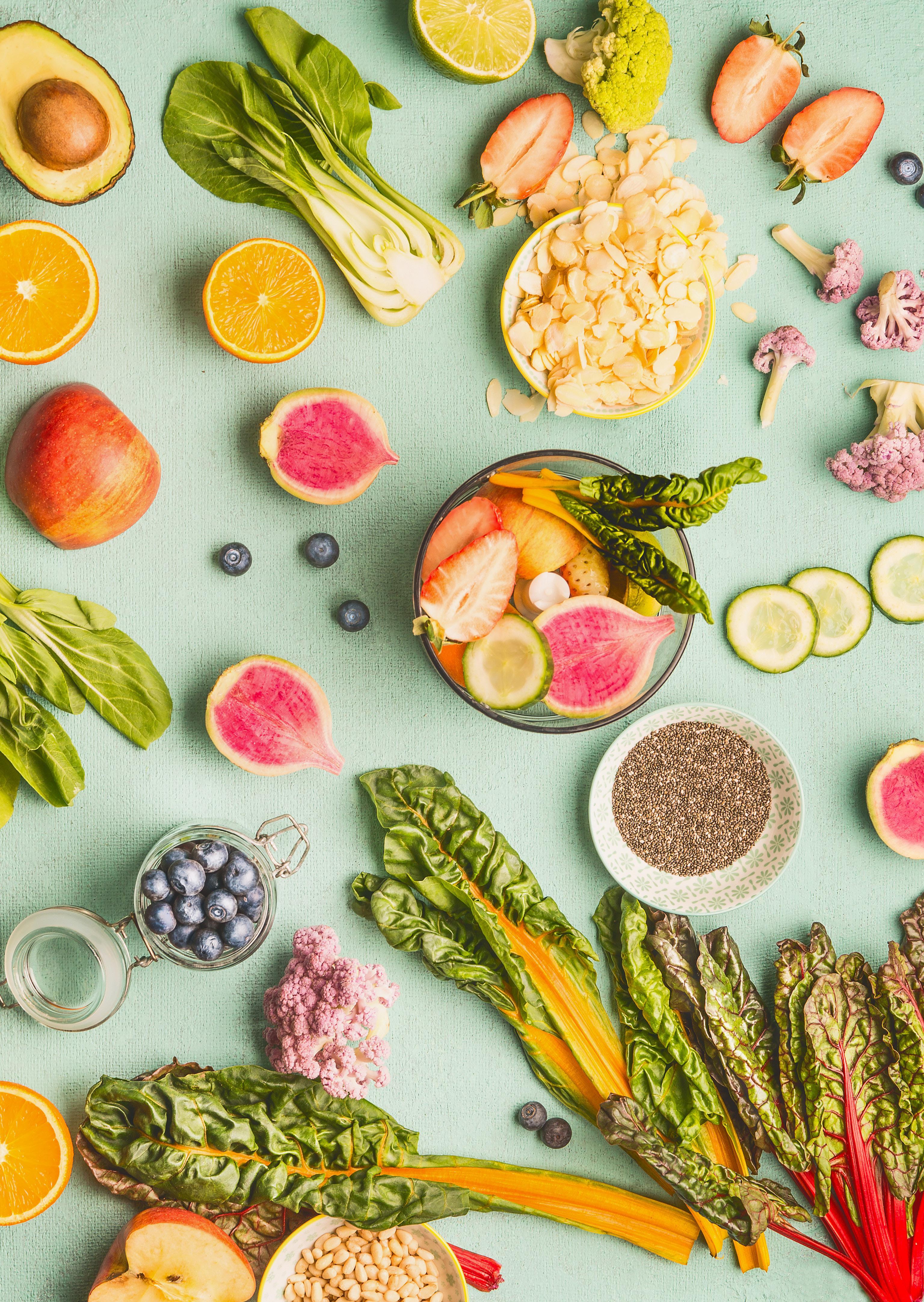
The top 5 QUESTIONS I’m asked as a GP
I have been a GP for over 40 years now, including 10 years locuming in the bush. I was also the club doctor at Hawthorn AFL Football Club for 15 years as well as having quite prolonged local footy and cricket careers. Suffice to say, I’ve pretty much seen and heard it all when it comes to men’s concerns (medical or not). So, if you want to be a fly on the wall of a doctor’s room, here’s the top 5 questions I’m asked as a GP. I hope it shows that no question is a silly one, and no question should go unasked.
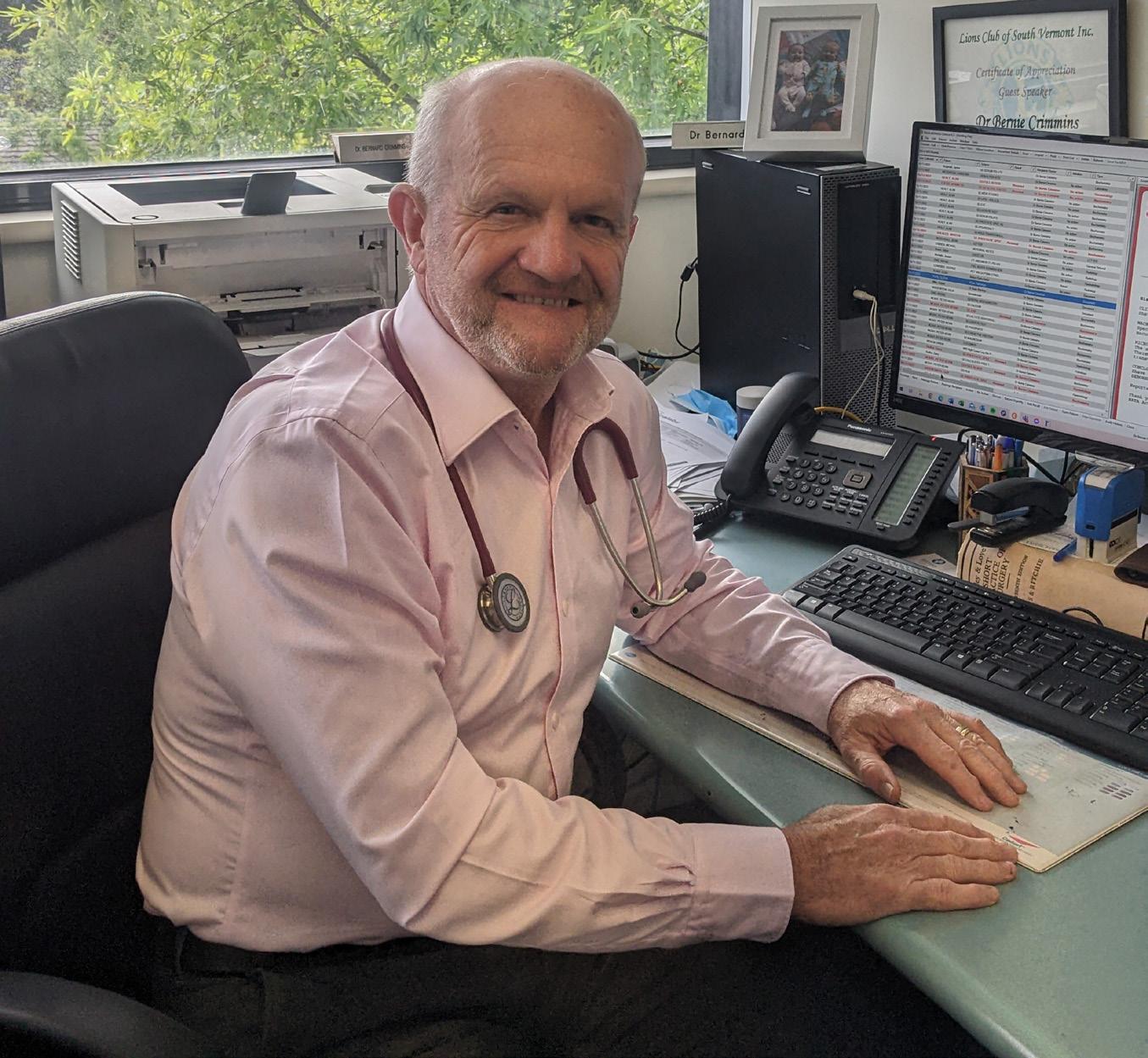
1.What happened to the Hawks on the weekend Bernie?
It is vital that you have a good relationship with your GP. This often results in friendly banter and develops a rapport between the GP and the patient resulting in a trustful and open relationship which for blokes is important to get them verbalising their feelings. My female patients often want to know how my grandkids are going and ask if I have any photos. These interactions start the consultation off on a happy note and auger well for a resolution of any problems. On a very busy morning recently, I had to see one of the other doctor’s patients whose first words to me were, “I am so angry that you kept me waiting! My time is important too!!” Not a good start. My response, stay calm, don’t get angry, offer an apology, deal with his issues and say a pleasant
Dr. Bernie Crimmins, OAM, graduated from Melbourne University Medical School in 1980 and has been a General Practitioner for 40 years with a special interest in Men’s Health, Nutrition, and Sports Medicine. His brother was the late Hawthorn AFL Captain in Peter Crimmins who died of testicular cancer in 1976. This led to his special interest in Men’s Health and being the author of two books titled Blokes Health 1 and 2. He was the Club Doctor at Hawthorn AFL Football Club for 15 years and he believes his greatest achievement in his life has been his family.bye-bye. Not worth the hassle. And a note to the receptionist – don’t book him in with me ever again!
2.I hope you don’t mind that I come in Doctor but I want to make sure he tells you everything!
This generally comes from the partner who enters the room before the patient and initiates the conversation with an emphasis on what are the worrying issues that should be addressed. Some of these may never have surfaced if the patient attended on his own so I am quite happy with this vital information. Once out in the open, it is up to the patient to follow through with the history of the said events.
3.I’m feeling pretty flat Doc, do you think it could be me ‘ormones?
This issue focuses on vitality, but I tend to see the opposite in my rooms. I see malaise. Vague tiredness is a very common complaint in General Practice. The problem is that virtually every disease may have this symptom as part of it and it requires an astute physician to sort it out. History is so important, particularly the length of time that it has been present. Shortterm tiredness could be something as simple as a viral illness and investigations are not warranted unless it persists beyond several weeks. However, other associated symptoms such as unexplained weight loss, pain somewhere, night sweats and abnormal findings on examination may necessitate earlier investigations. Men tend
to not come in at the drop of a hat anyway so most of the tired blokes I see have had it for a while, hence investigations are probably warranted, and the standard ones tend to be a full blood count, thyroid function, iron and b12 levels, kidney, liver function and glucose. Those with low libido do warrant a check of the “ormones” and a testosterone level is useful, particularly in those overweight. If they haven’t had a full check-up recently then cholesterol and prostate (PSA) levels can be added. A complete physical examination is vital as well. Physical causes need to be excluded first and then psychological conditions become the possible culprit with the complexities of diagnosis and management.
4.I can’t get it up or it won’t stay up Doc. Can I get some of those blue pills that my mate got?
This can be the primary complaint, or it is often thrown in at the end as he is going out the door having come in for some other minor complaint. Lack of vitality in the penis is perceived as a failure of virility and hence manliness, which then extends to self-worth. This might be a pretty straight up and down issue (excuse the pun) but it can also be pretty complex. Once a bloke fails once, it puts an element of doubt in the mind/brain setting up for further failures the more and more he worries about it. Throw in the worries of the partner and a pleasurable event can become a stress-filled tango. The Viagra class of drugs are very useful for reducing performance anxiety as they tend to take over and counterbalance the negative vibes coming from the brain. The hope is that once
confidence is attained again then the pills can then be a useful but infrequent necessity. However, if there are other cardiovascular risk factors, I always like to get some sort of cardiac check-up as Erectile Dysfunction can be like the canary in the mine shaft. It may be due to a blockage in the penile artery which could also mean blockages in the coronary arteries. Don’t just try one of your mates or get them online. See your GP asap.
5.When do you want to see me again Doc?
This is probably the most important question as it triggers the beginnings of continuity of care. It is a recognition that health assessments and concerns are not just a fleeting occasional foray every now and then or if something seriously goes wrong. It recognises that things may be prevented by getting a check-up, a bit like taking your car for a service. If you have had tests done like blood tests or X-rays, scans, etc. it is important to follow up on the results and have them explained to you – the abnormal ones and also the normal ones. Don’t assume that no news is good news. These days telephone consultations are useful for that. I often will email a copy to the patient if they wish. Some will just be happy with my reassurance that all appears well, but I stress that a regular check-up is the preferred option. Over 50 it should be yearly with every 2 years from 40 and every 3-5 years from 30. Even a baseline set of blood tests in the 20s wouldn’t go astray.
This is just five - I could give you another 500! You would not believe the things I am asked. But that is the joy of General Practice. You don’t know what is going to walk in the door next.
Stay happy and healthy... and guard your vitality!
#keep5alive CHALLENGE THE SNORING CHALLENGE
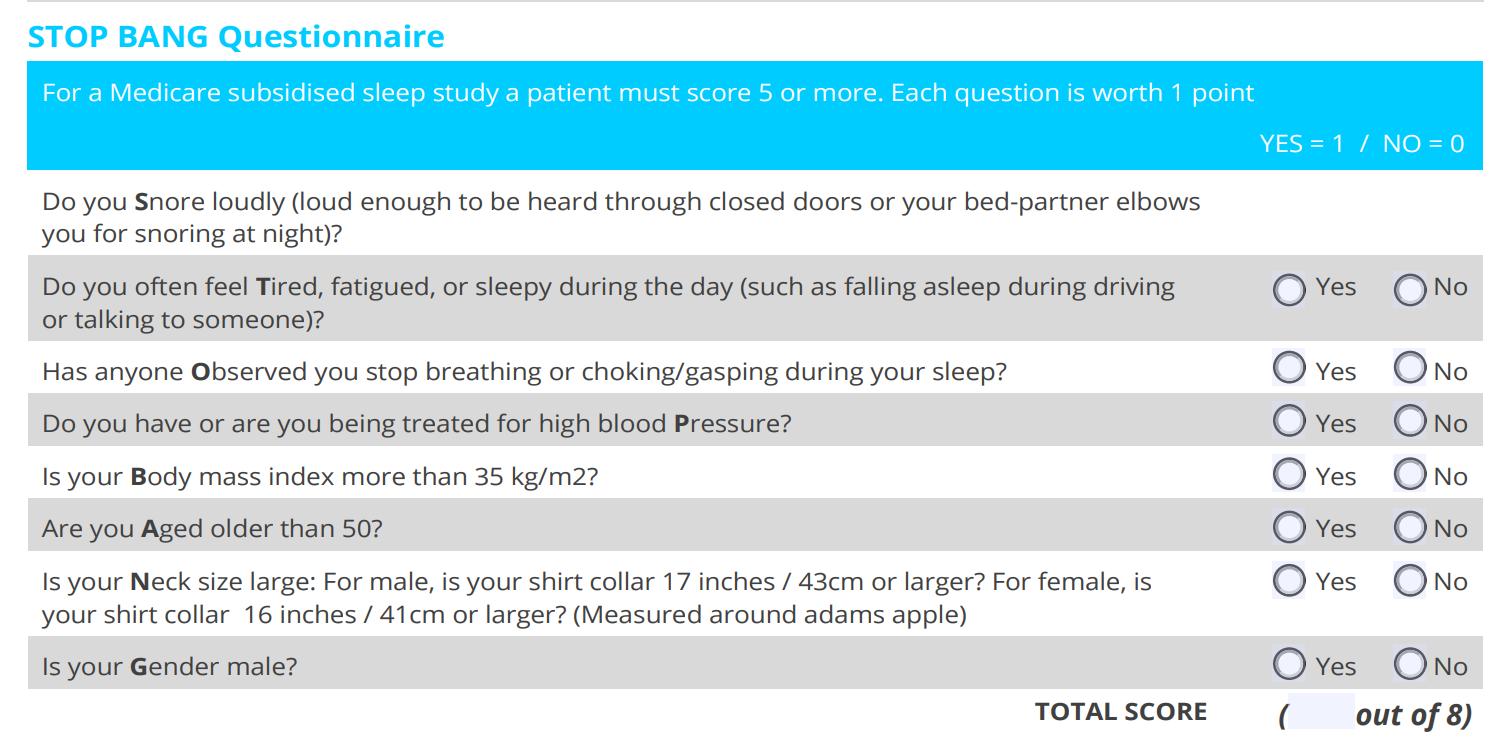
Snoring is a killer for getting great sleep. It’s risky for your health, relationships, and vitality.
Great sleep is one of the holy grails worth chasing – your body and mind cannot live without it.
Instantly gain more Vitality through the power of quality sleep by putting the brakes on your snoring with this month’s Snoring Challenge.
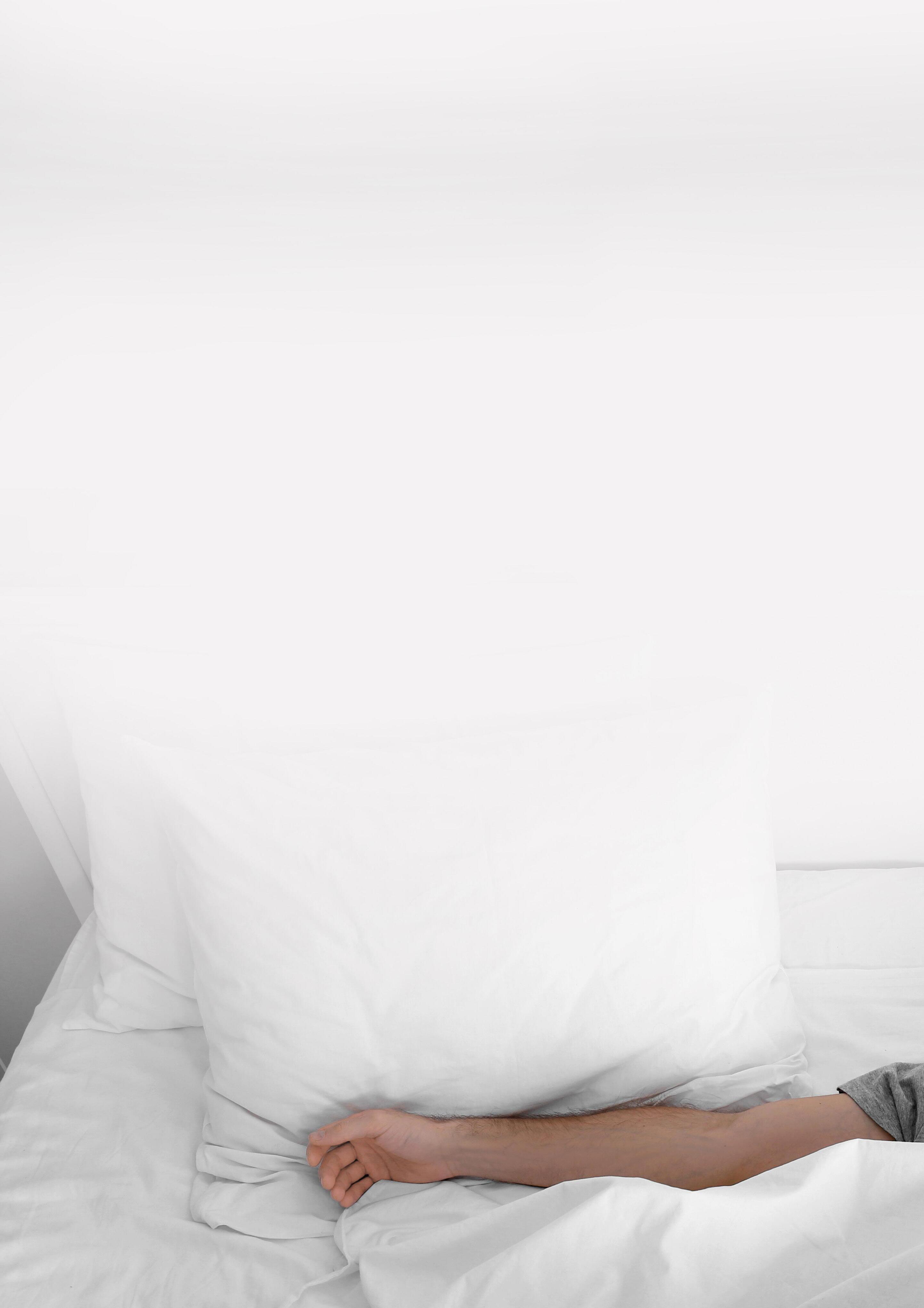
GETTING STARTED
We’ve designed this snoring challenge to be quick and easy… no fuss whatsoever. We’re here to help you find quality sleep, and in turn, more vitality!
WHO SHOULD TAKE THIS CHALLENGE
• Snorers
• If you feel tired
• If you have a family history of sleep apnea
TIME
1-2 minutes to complete the “STOP-Bang” sleephealth screener.
HOW TO
Click the quiz button below and answer 8 questions to get your risk score. The STOP-Bang questionnaire is designed to screen for the common sleepdisordered breathing disorder, obstructive sleep apnea (OSA).
1 in 4 Men are at risk of OSA and the majority are undiagnosed!
Want to learn more about sleep apnea and how snoring connects in? Visit sleepingtest.com
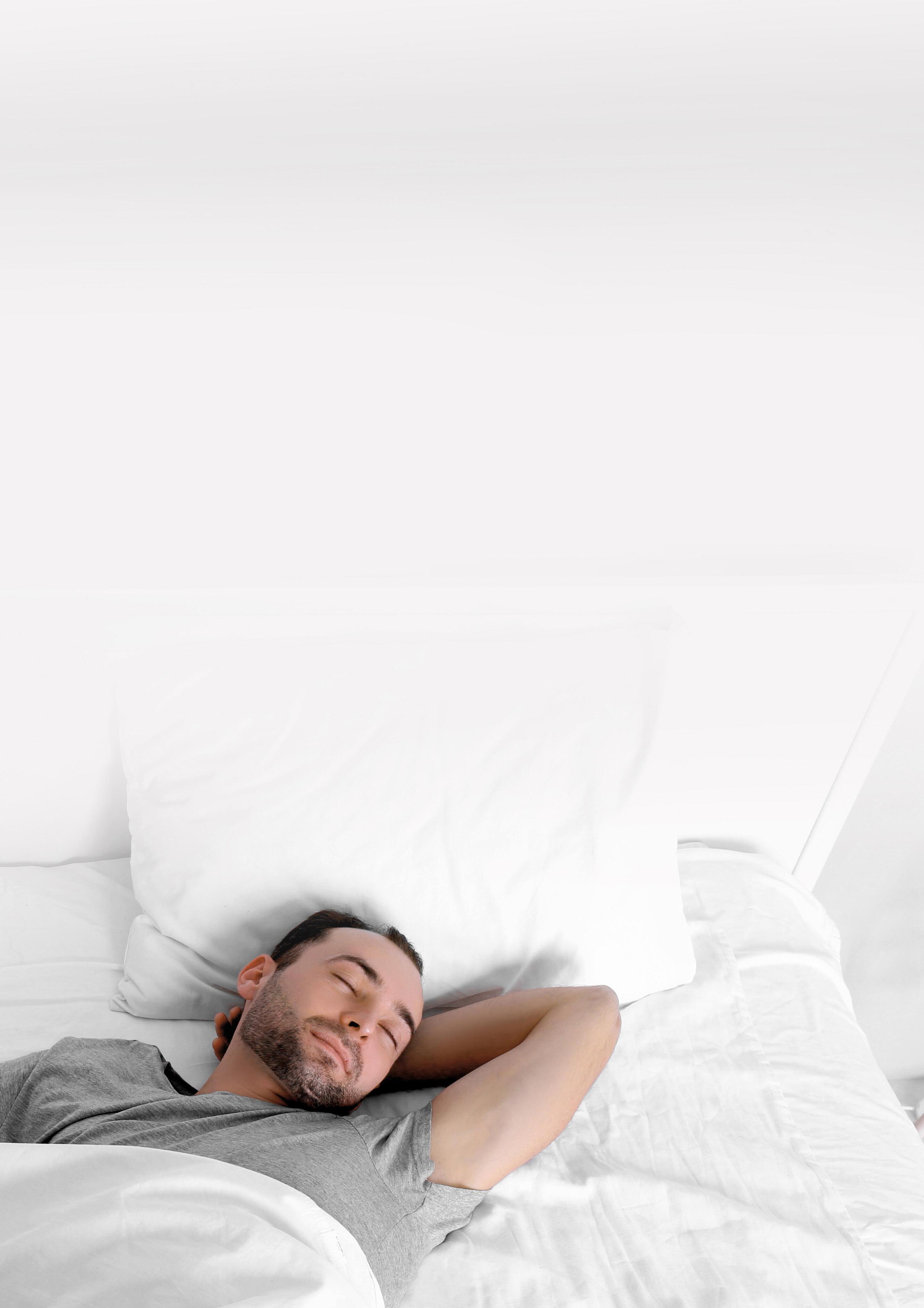
QUIZ
SNORING INSIGHTS
• Snoring is no laughing matter. It’s risky business and a key symptom for sleep apnea, a serious medical condition
• Snoring only happens when you sleep.
• Snoring is the sound created when parts of your throat vibrate as you breathe. It indicates airway instability and that your airway is at risk of obstructing (no airflow).
• It occurs when the muscles around the throat relax and soften, the pharynx is less strongly held in place, allowing it to vibrate as air passes in and out.
• Someone sharing a bed (or even a house) with a snorer can lose significant sleep and find themselves understandably frustrated and angry. And, for the snorer themself, their
night time sounds can be an indication of sleep apnea, a potentially serious disorder.
• 69% of OSA sufferers found to have erectile dysfunction (ED).
• 46% increased risk of suffering a stroke when you snore.
• Snoring is a predictor for developing high blood pressure.
• 46.1% of OSA sufferers experience depressive symptoms.
• Anxiety symptoms found in 53.9% of OSA sufferers.
• Weight control and gain become problematic if you snore with OSA. Better sleep can help with weight loss.
5 Wall Mount a TV in EASY STEPS
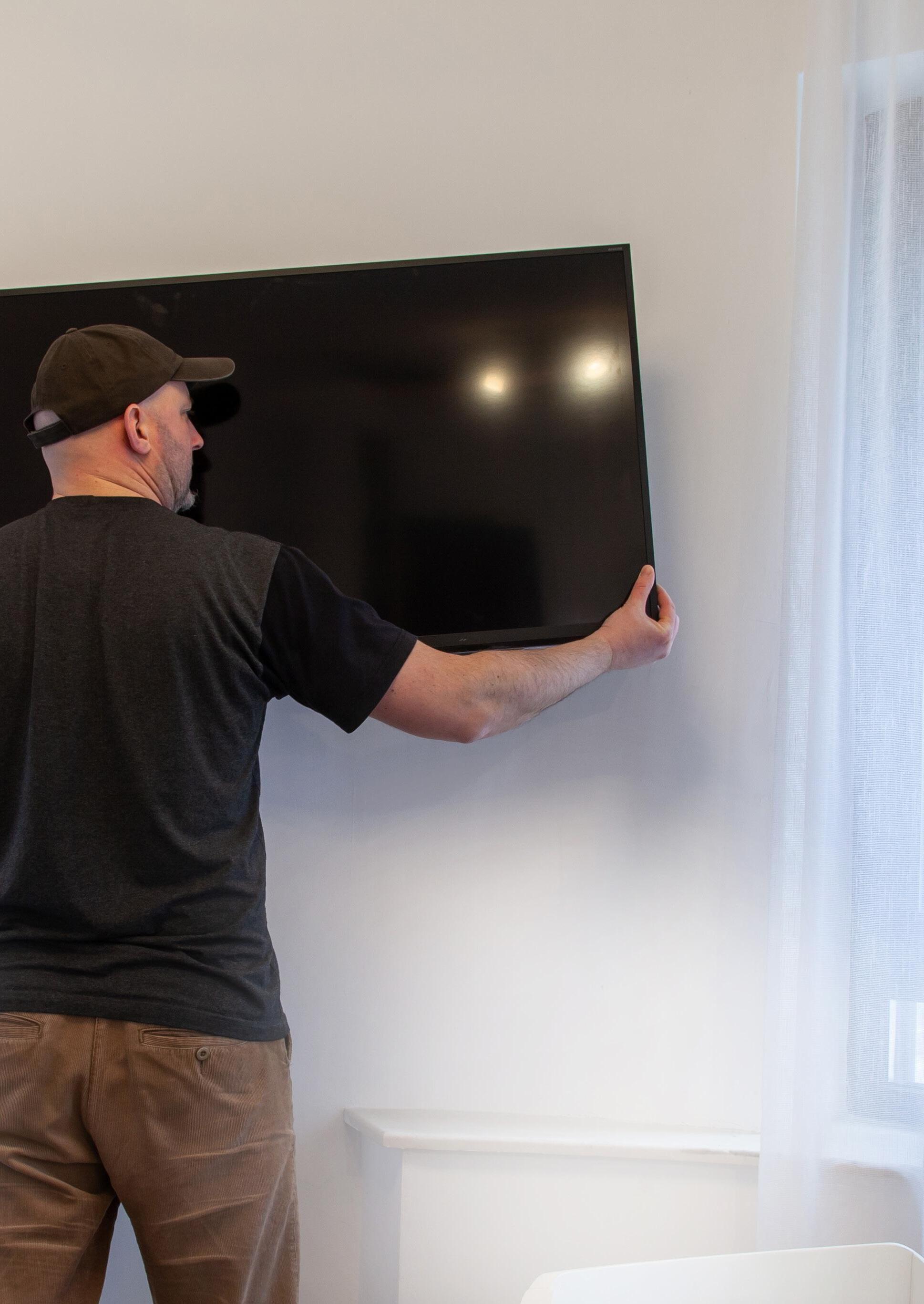 Leon Theofanous
Leon Theofanous
Wall-mounted TVs save space, eliminate clusters of cables littering the ground and means you don’t have to worry about kids or pets running around and accidentally knocking over your expensive TV. On top of all that, it can be better for your eyes, neck and back health ensuring it is at the ideal height for optimal TV viewing.
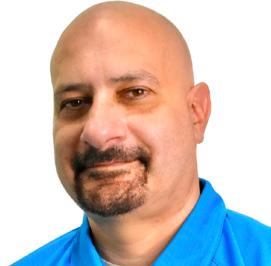
GETTING STARTED
You will need the following tools and fasteners to wall mount your TV:
• Power drill
• impact driver
• Various-sized drill bits
• Split level
• Tape measure
• Stud finder
• Pencil
• Painter’s tape
• Wall anchors
• Universal TV mounting bracket
• TV cable management cover or cable clips (if you want to keep the cords out of sight)
Before you get started, try and line up a second set of hands to have on standby and familiarise yourself with the items needed and the steps below to save any surprises half way through.
1 2

Choose a suitable wall - pick a wall that can support the weight of your TV and the mounting bracket. When you have picked the spot, clear the area. On the chosen wall, determine the approximate location of the TV to be mounted on the wall. The height of the TV should be mounted with the seating eye level centered to the height of the TV. It is recommended to always install the bracket across two (2) internal studs (these are generally 450 or 600mm apart), otherwise, it can be installed on at least one stud and the other end installed onto the plaster only using wall anchors. Mark the area with a pencil.
Locate Studs using a stud finder by moving across the wall until it indicates it has found a stud and then mark the center of the detected stud with a pencil or painter’s tape.
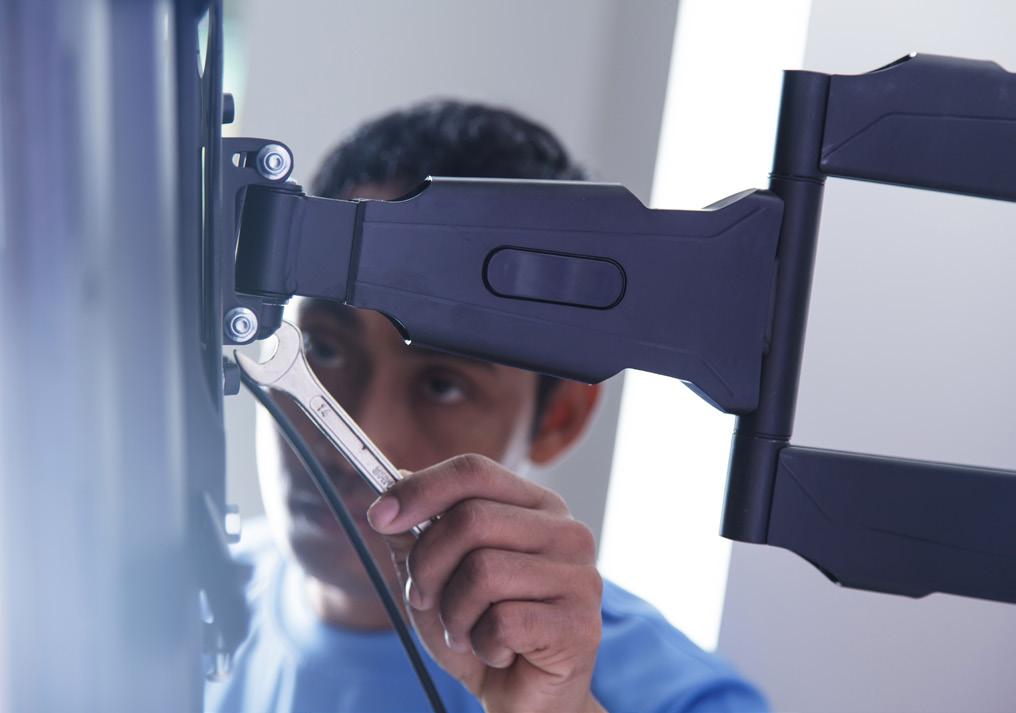
Install TV Mount Brackets using suitable screws and spacers (supplied with unit) to attach the TV mount brackets to the back of the TV.
Install Wall Mounting Bracket Place the bracket against the wall over the marked detected studs. Use a split level by placing it on top of the wall mounting bracket to get the bracket level. Drill a small pilot hole (approx. 2mm) through the plaster to confirm there is a stud. If the stud is present, use a 3 to 4mm drill bit (or as recommended by the supplier) Using the pencil, mark the four (4) points to be drilled –2 on top and 2 on the bottom of the bracket. Remove the bracket and drill only one hole for the top of the bracket, ensuring that it is drilling through the plaster and timber stud. Using the timber screws supplied and your impact driver (set to low) – drive in one screw with a washer if required, but do not tighten. Use the split level again to check the level before drilling the next opposite hole at the top of the bracket. Drive in the 2nd screw but do not tighten. Drill the remaining two (2) bottom holes and drive in the screws when you are happy with the screw positionings, tighten all screws.
Mount the TV (two people) by hooking it over the top of the wall-mounted bracket. Ensure that all cables are not in the way when mounting (if required, install the cable management cover beneath the TV and seat in all the cables).
3 4 5 6
Turn
The Word last
After 6 weeks at sea on the Southern Cross Shipping Line, Colin McDonald, aged 8, immigrated to New Zealand from Scotland in 1962 with his family. Following many highs and lows in life and moving all over, he decided to settle in Christchurch, just before they were hit with the devastating earthquakes in 2011.
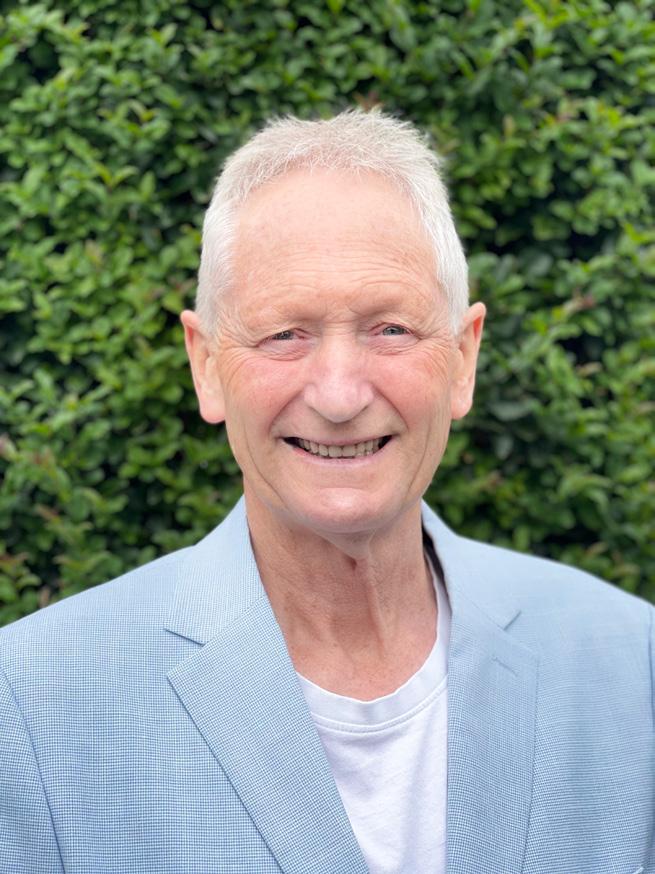
Over the next decade, Colin rebuilt his business before eventually
selling it and transitioning into the security industry. 10 years after experiencing the trauma of the Christchurch earthquakes, Colin faced a new daunting challenge when he was diagnosed with bowel cancer in 2021. He faced five weeks of chemo and radiation treatment followed by surgery - and although there were complications, Colin eventually returned home after seven weeks of hospitalisation.
 - Colin McDonald -
- Colin McDonald -
Colin has become an advocate for Saving Brothers and the Gut Cancer Foundation through fundraising initiatives and promotion of the cause. Colin dearly treasures his wife, Karen; grown-up daughter; stepson; stepdaughter; and two granddaughters.
1. Last Holiday Location?
Stunning central Otago which is located in the South Island of NZ.
2. Favourite eating spot?
Riverside market in central Christchurch - it has an abundance of fresh foods from a variety of restaurants, cafes, and bars.
3. Pets?
No pets. I did have a cat over 15 years ago called Cloe who gave birth to four kittens on our bed early one Christmas morning. What a Christmas present it was to wake up to.
4. I unwind by…
Taking a good walk to stretch the legs and tuning into popular music or motivational music during cardio workouts.
5. The last book I read was… A Life on Our Planet by David Attenborough - the story of how we came to make this our greatest mistake in destroying our planet and how we can put it right.
6. Favourite movie or TV show?
I am more of a documentary fan, however, I have watched some good movies and TV series. The movie that I thoroughly enjoyed was Braveheart due to my Scottish heritage.
7. Greatest achievement?
I cannot say that I achieved anything great academically or professionally, however, my greatest achievement was beating colon
cancer recently. This disease claims so many lives but determination, a positive attitude and a willingness to make changes to my lifestyle gave me my life back.
8. Music from my adolescence… The Beatles, Rolling Stones, Duran Duran, Led Zeppelin, and The Beach Boys.
9. Dream destination A tropical island with golden sand and crystal-clear water. The Maldives could be a winner here.

10. Another thing on my bucket list?
Travel around Scotland and learn more about my heritage.
11. I think the biggest challenge facing men today is… Excessive alcohol. We are a nation of binge drinkers and many men are the worst due to their display of being a macho man. But the link between men, alcohol, and mental health is shocking.
12. What I’d like boys and young men to know…
Life is a precious gift, a rollercoaster full of happiness and sadness. Life is a journey and many mistakes will be made on the way while others will be honoured with success.
13. Men and women have differences but one way they’re just the same is… While women and men have differences, the one thing we have in common is love. As the old saying goes, love makes the world go round.
14. What would I like to tell my 18-year-old self?
Choose a path in life. Many 18-yearolds today don’t know what career path to take and end up wasting their days. I would tell him to choose a path, any path.
15. One thing I find difficult to talk about?
My personal feelings in a friend or family situation because it may flare a conflict or I don’t know how the other person may respond.
16. My best habit…
Gratitude, to focus on what I have rather than what I don’t have. Gratitude is a sure way to health and happiness.
17. My worst habit… Surfing the internet or playing solitaire on my phone while in bed before going to sleep. Then I wonder why I am not sleeping well. Something I need to work on for sure.
18. Someone who inspires me is… Keanu Reeves. In spite of his fame and fortune, he is such a humble person who gives of himself to others less fortunate than himself.
19. My last home handyman project was…
A raised vege garden. I always get satisfaction going out to my vege garden to pick fresh produce for our dishes. Also, there is the cost savings due to skyrocketing prices.
20. The last time I helped a ‘brother’ was when…
A friend’s son was having a marital relationship problem that imposed suicidal thoughts. With his dad living in another city, my friend asked if I could call round and speak to his son. I spent time just listening to him and established that he was not serious about suicide but mildly depressed about his situation and just wanted to be heard. I advised him where to get help and his situation has changed for the better, and is still in his relationship.
